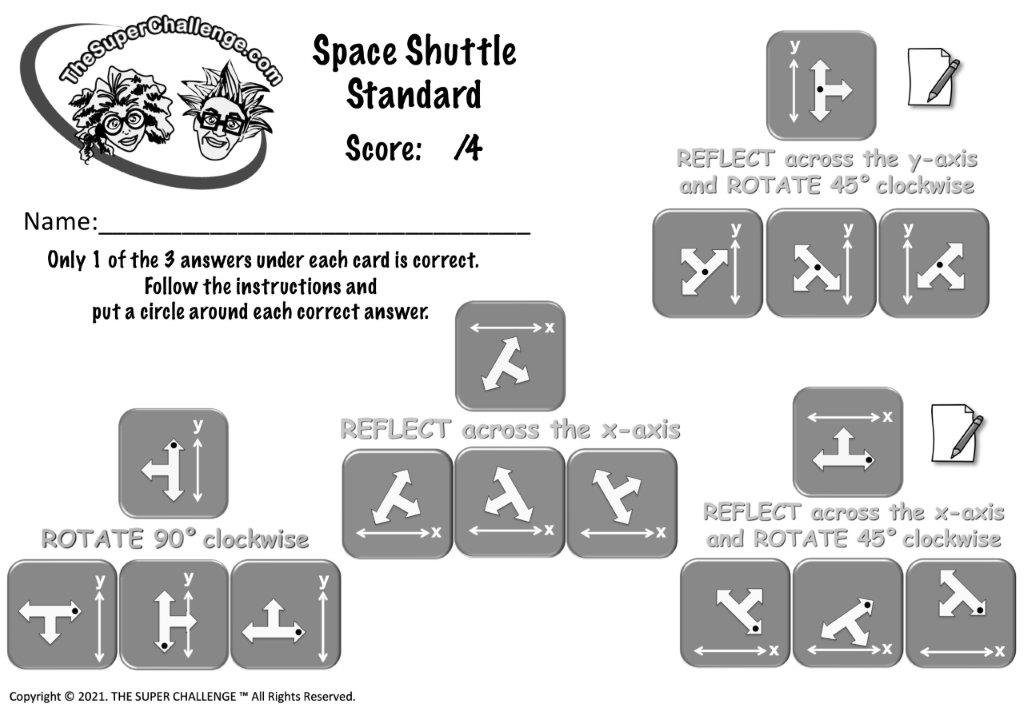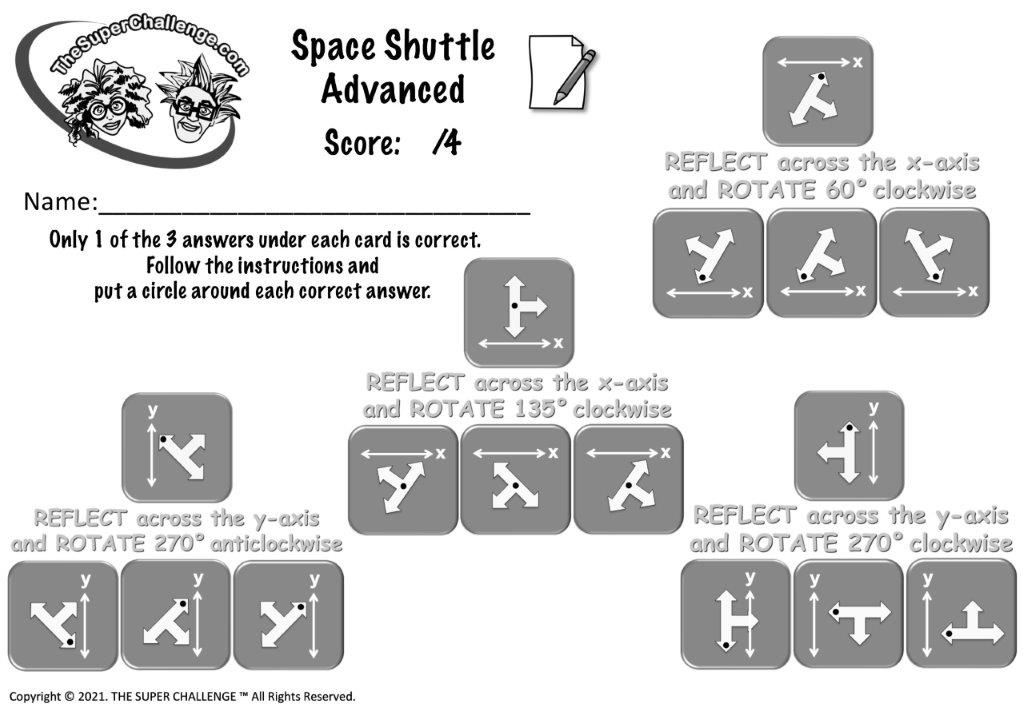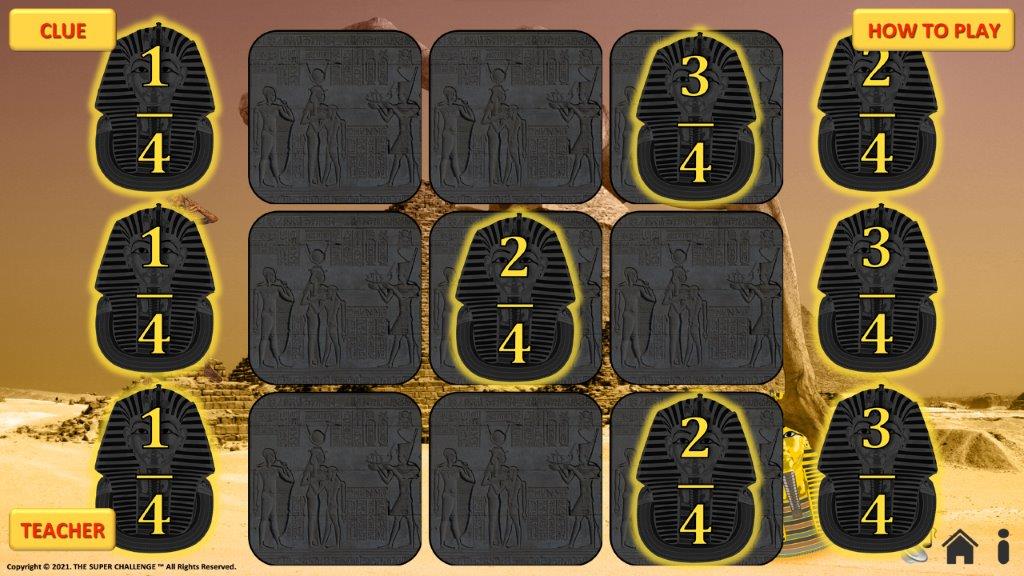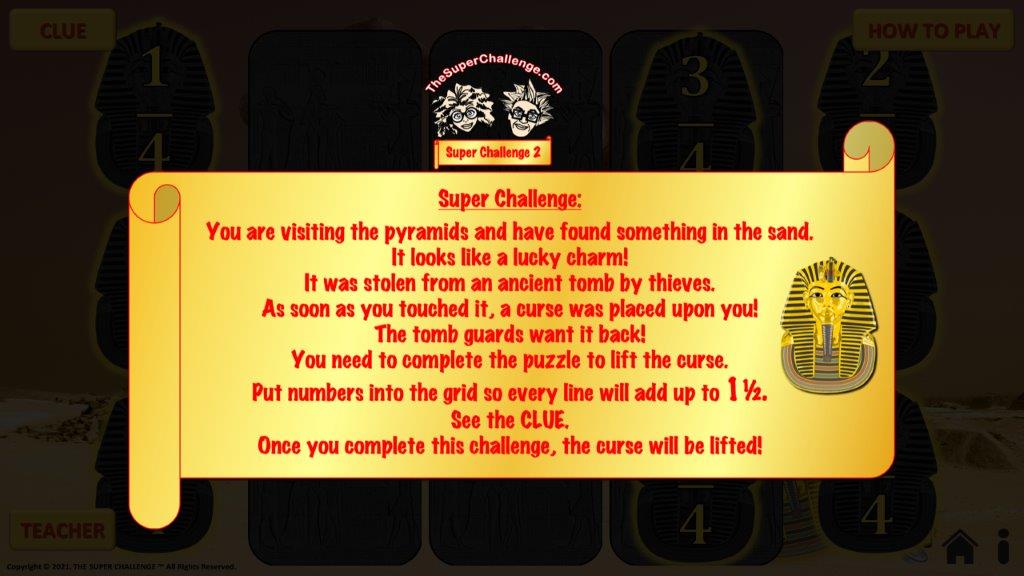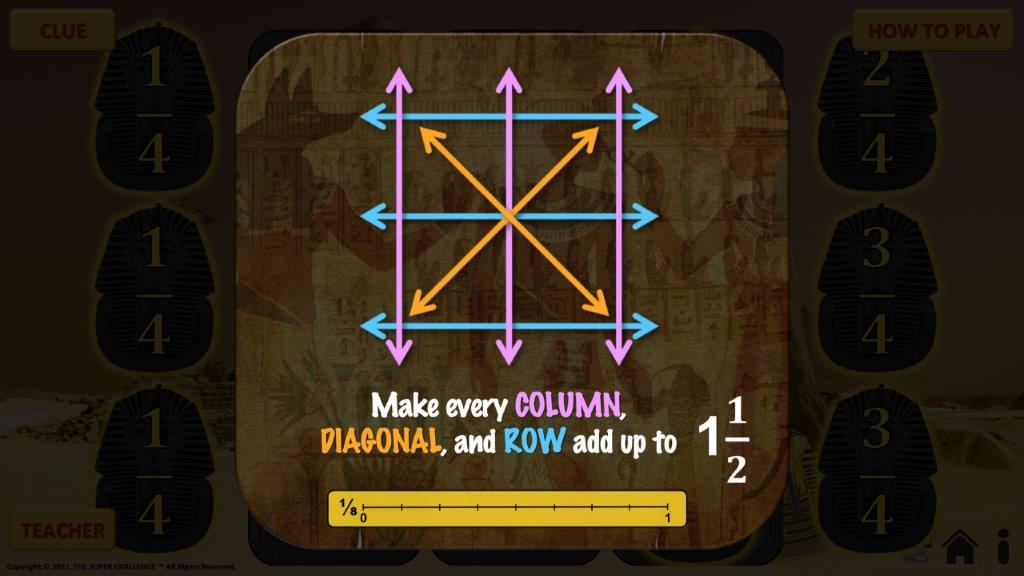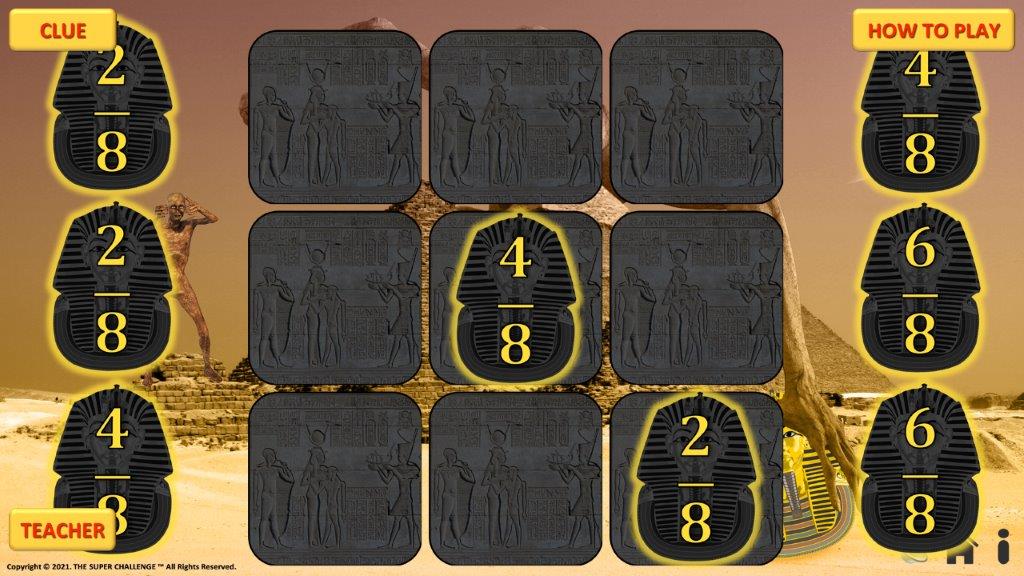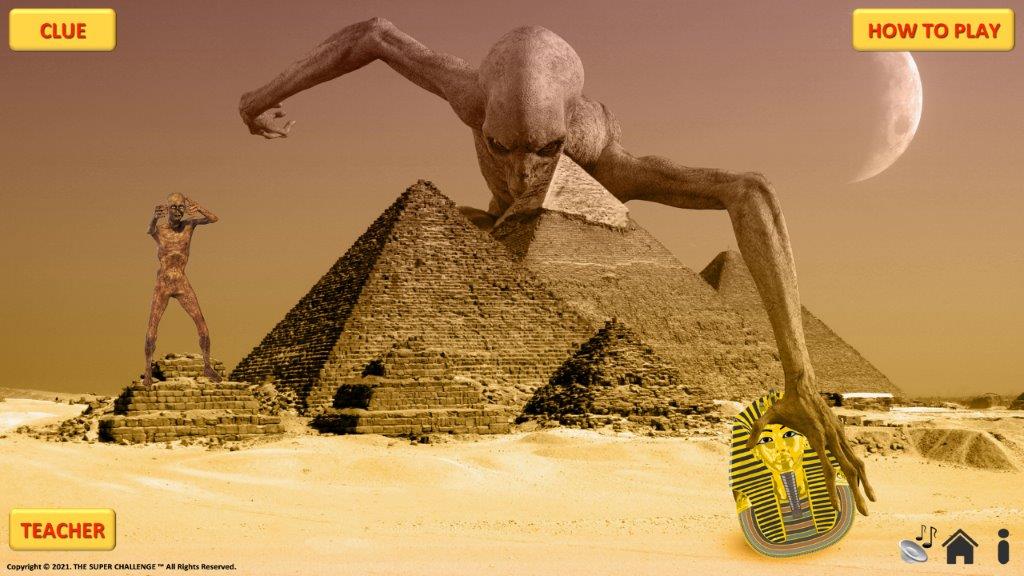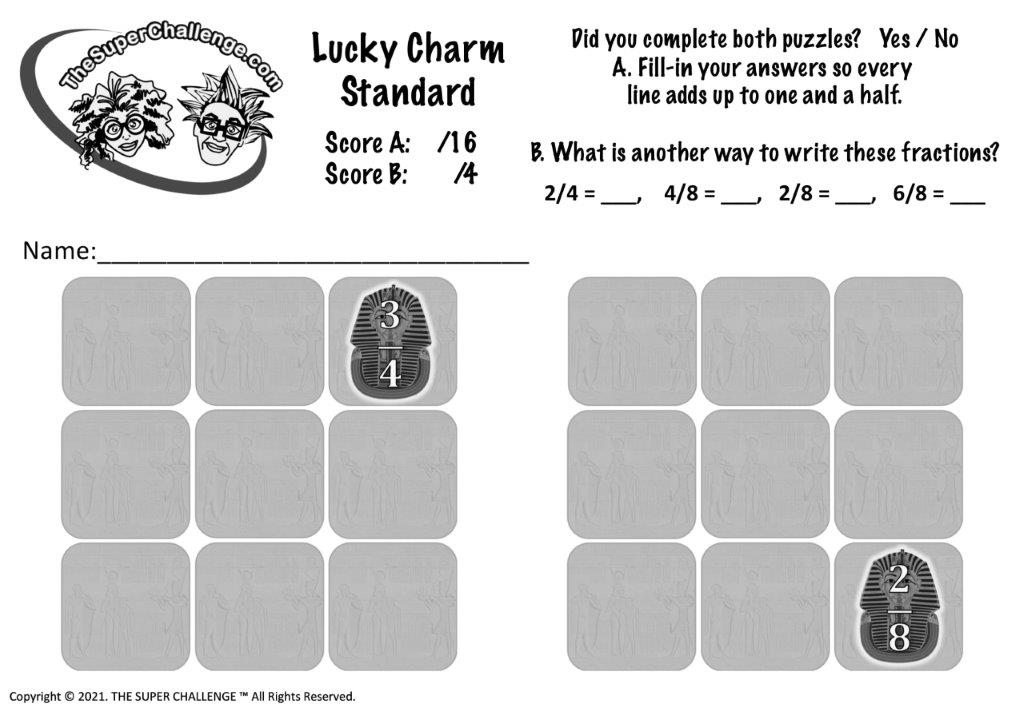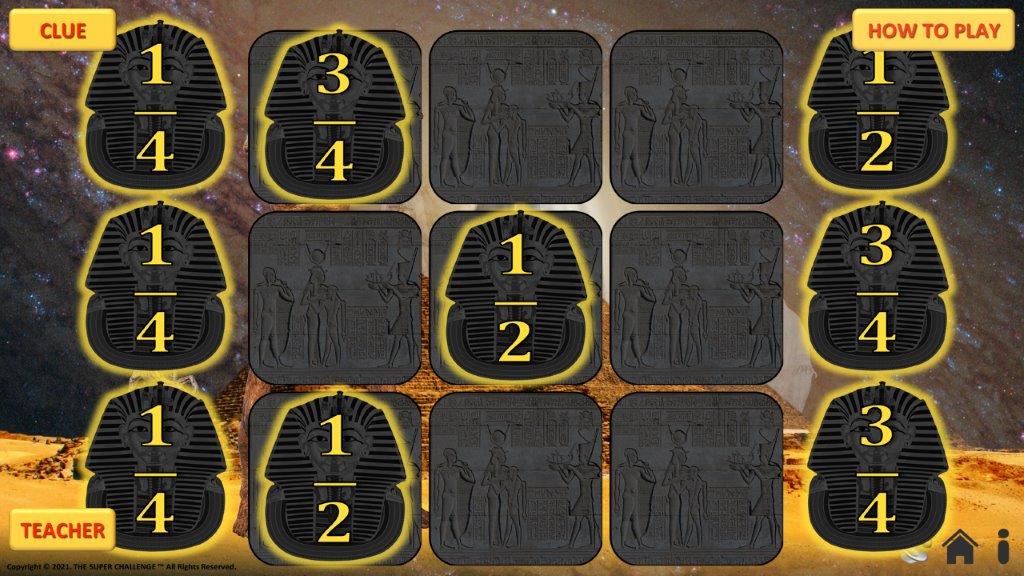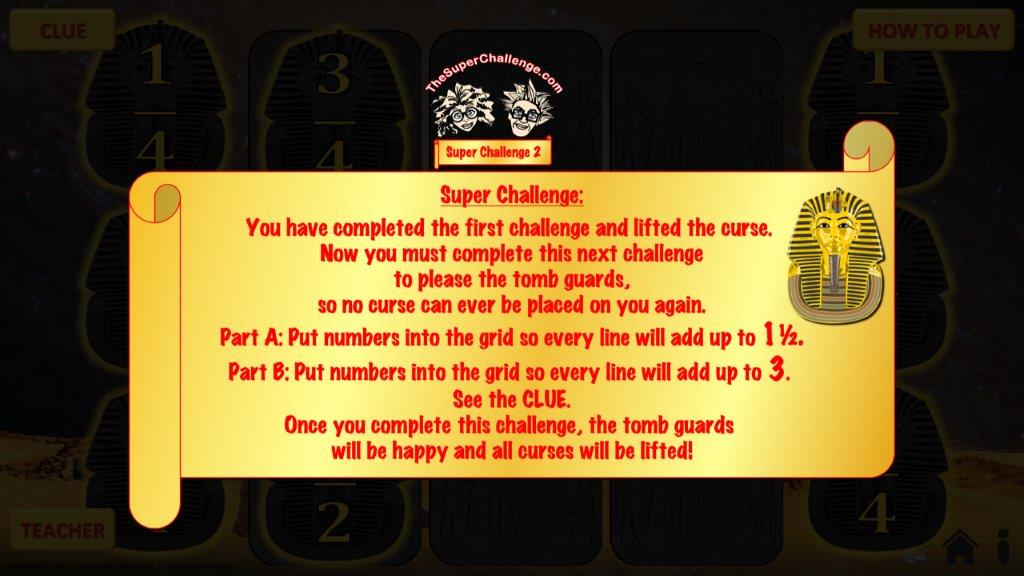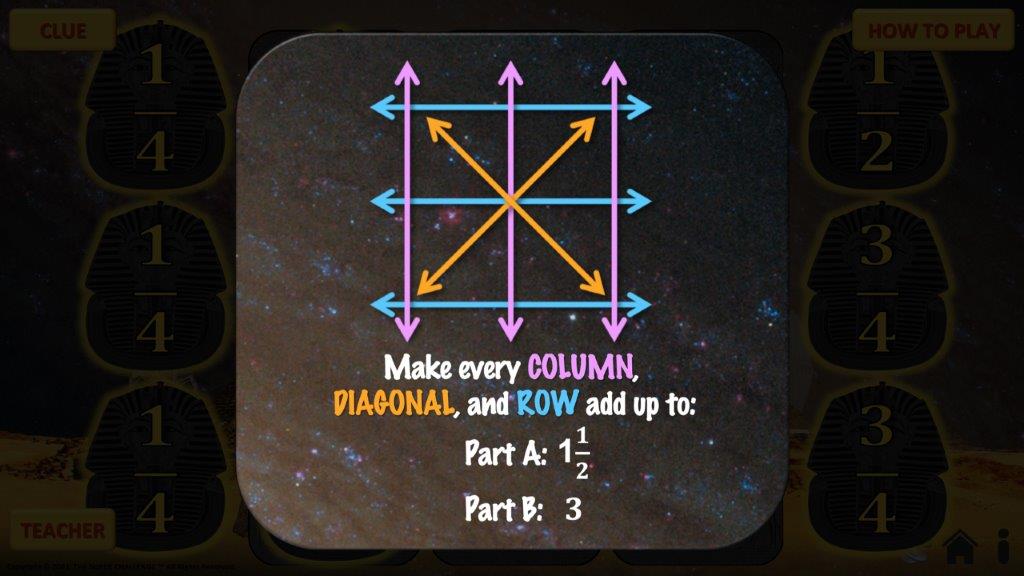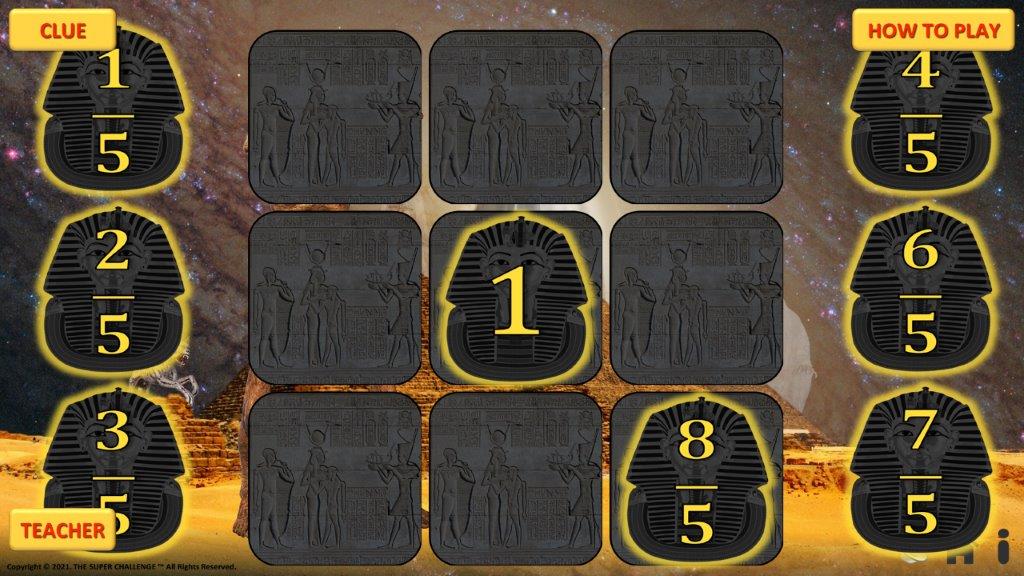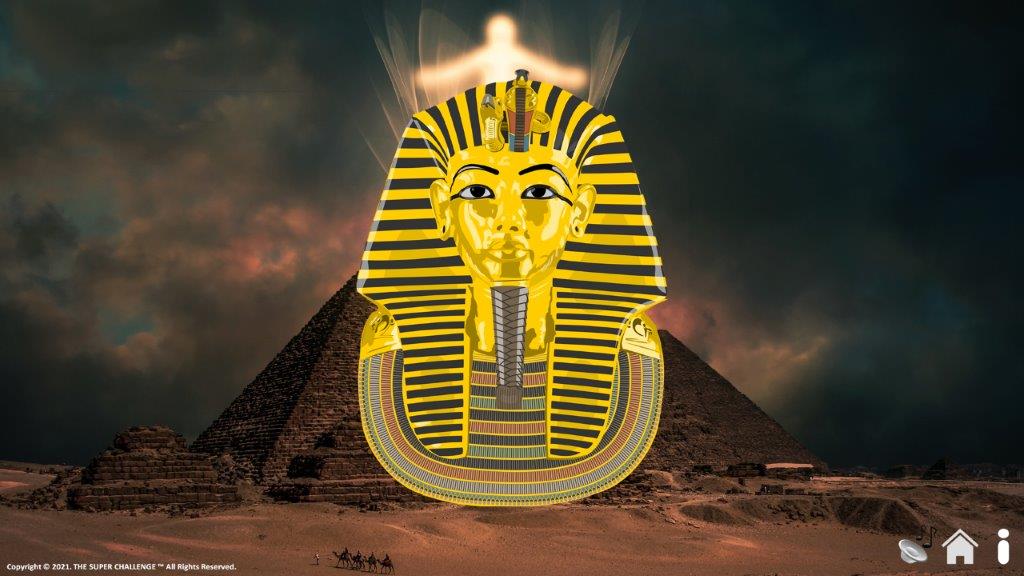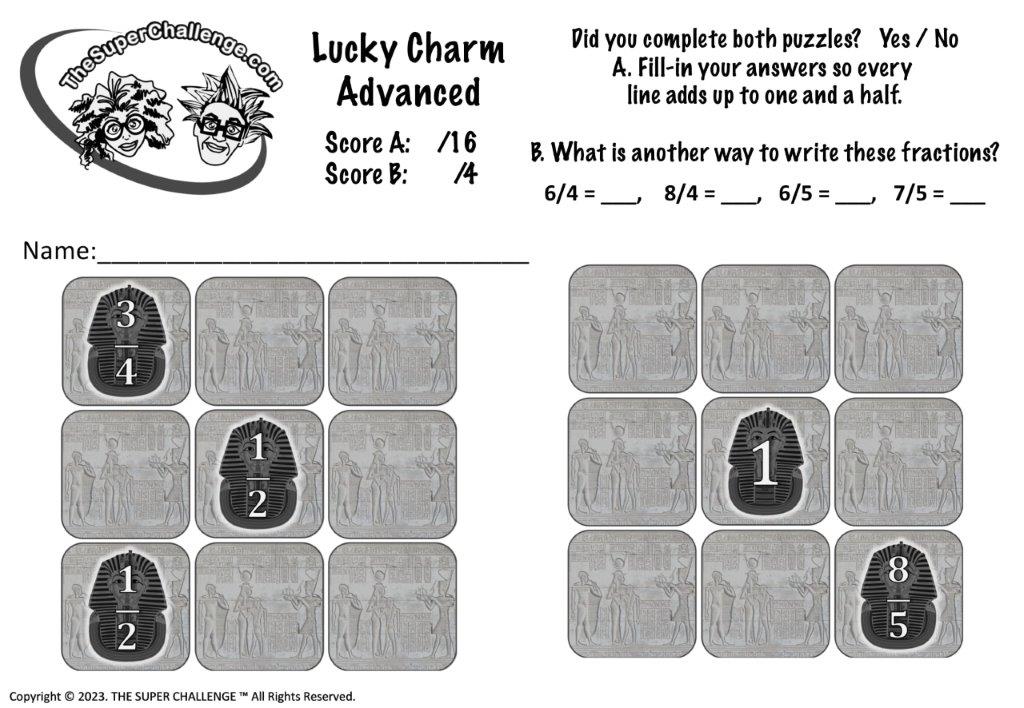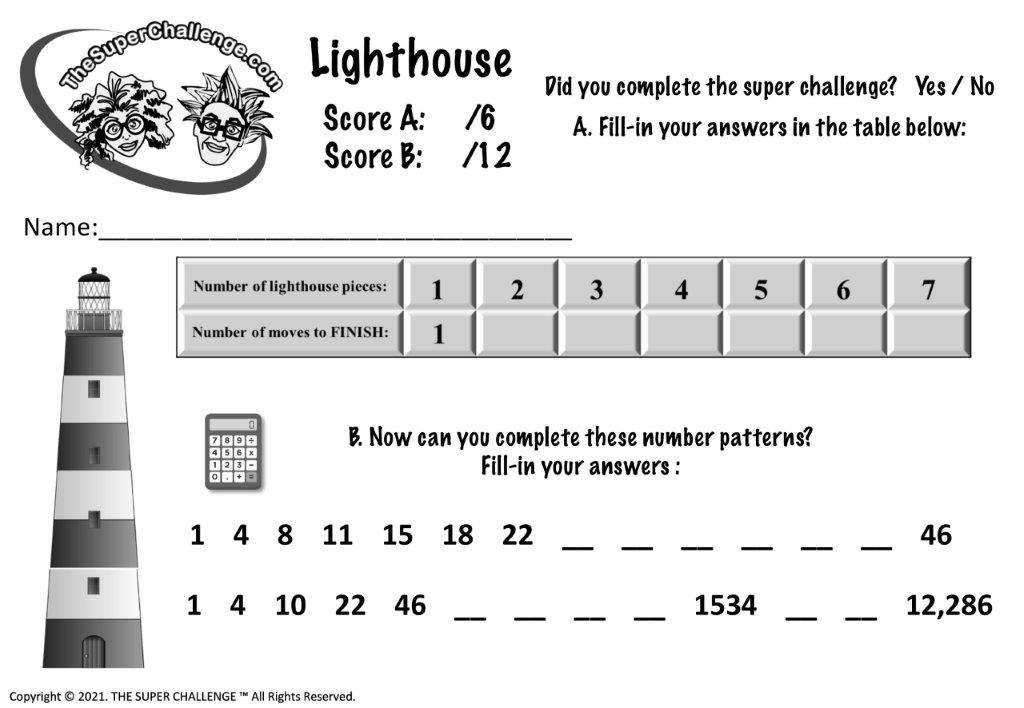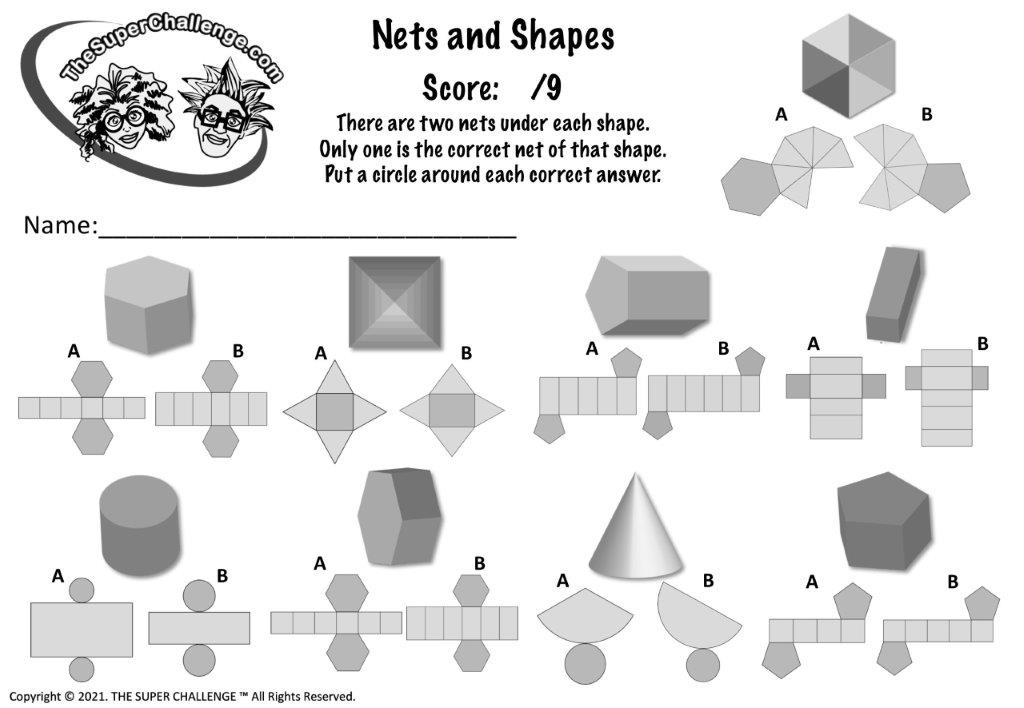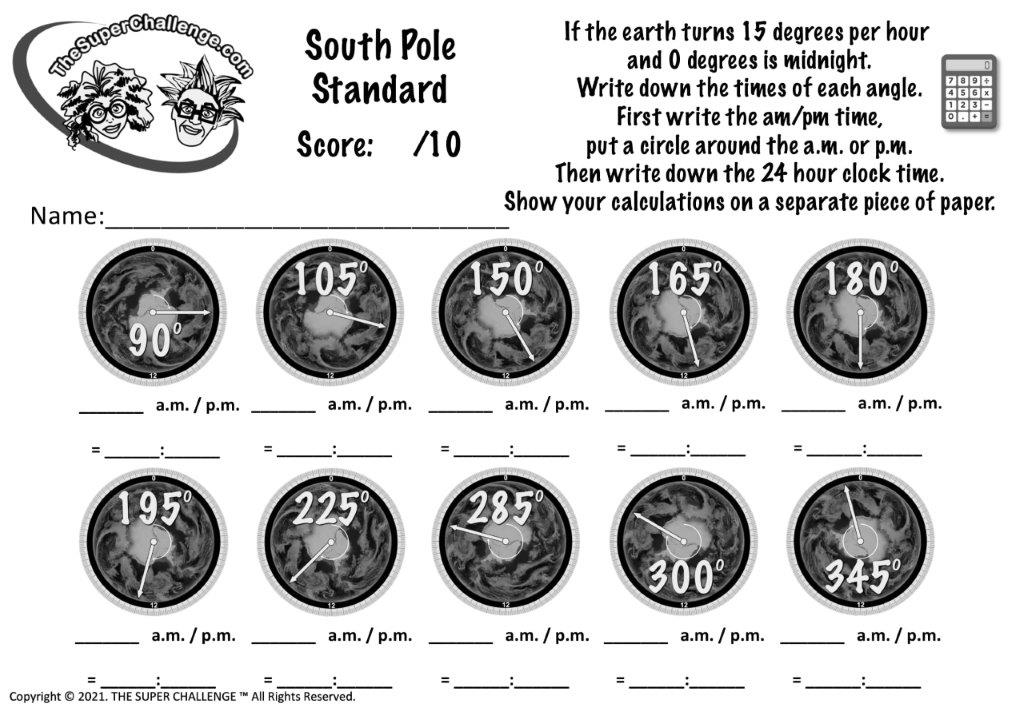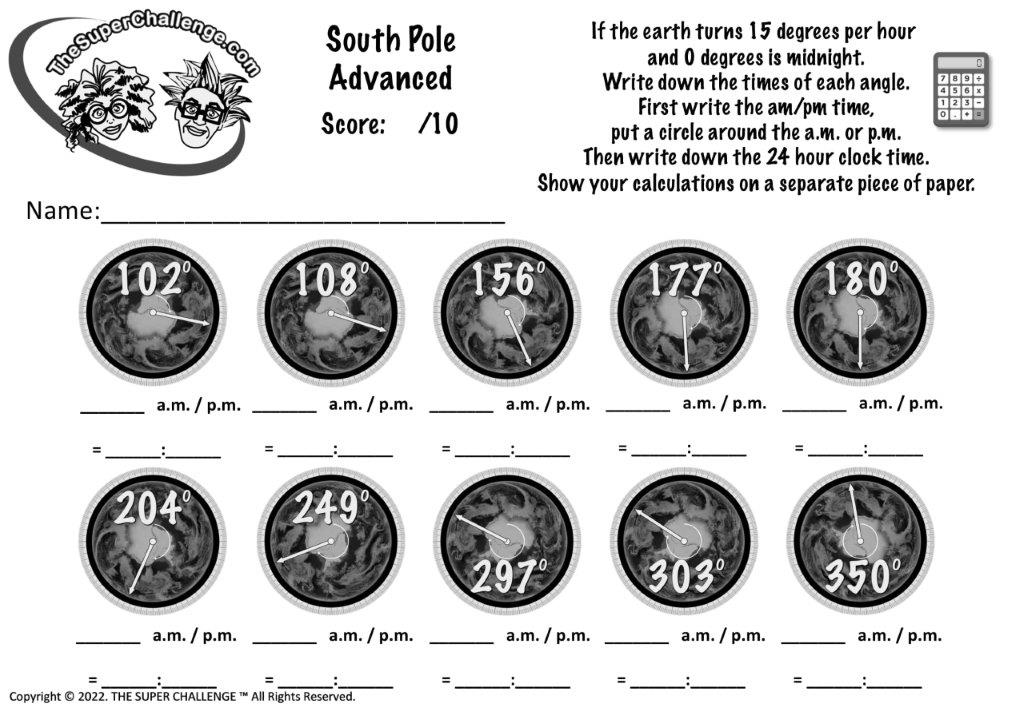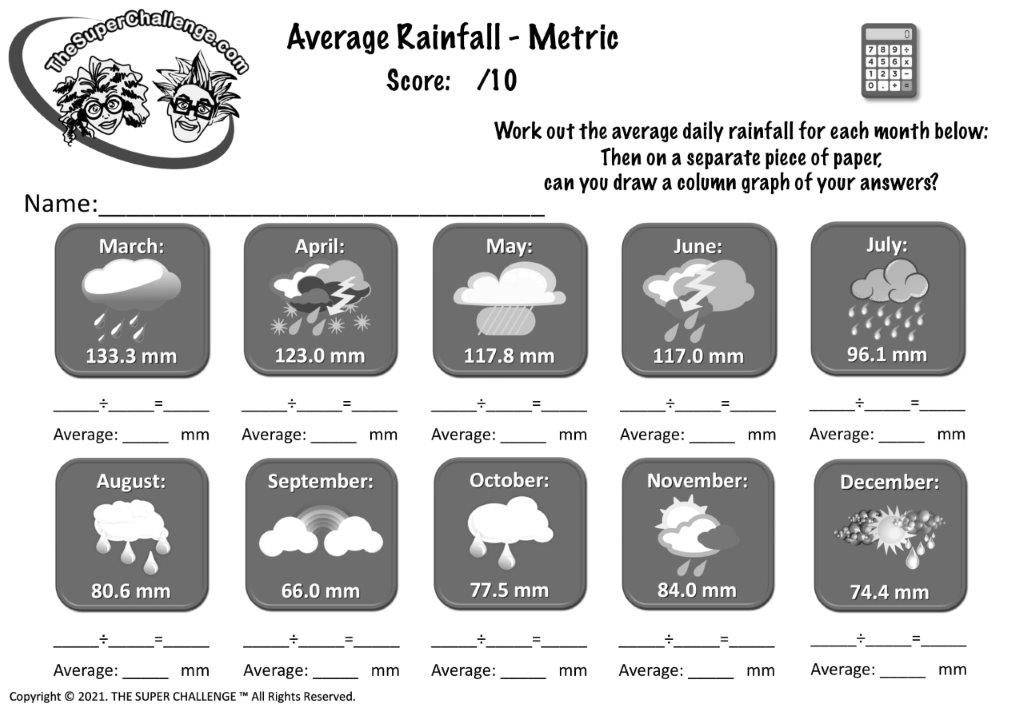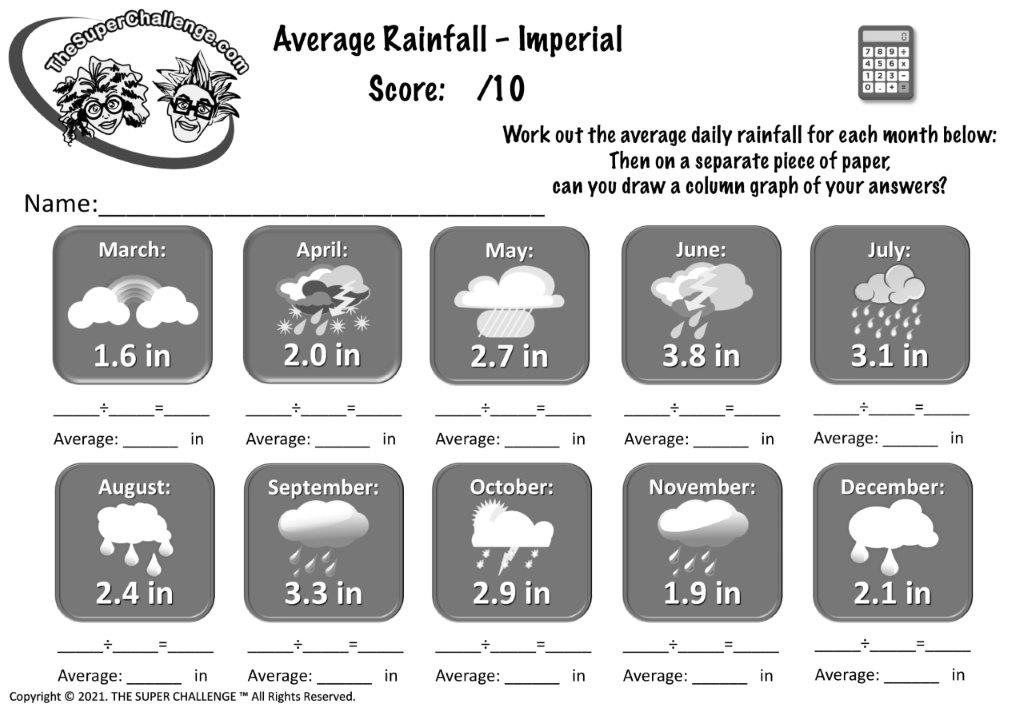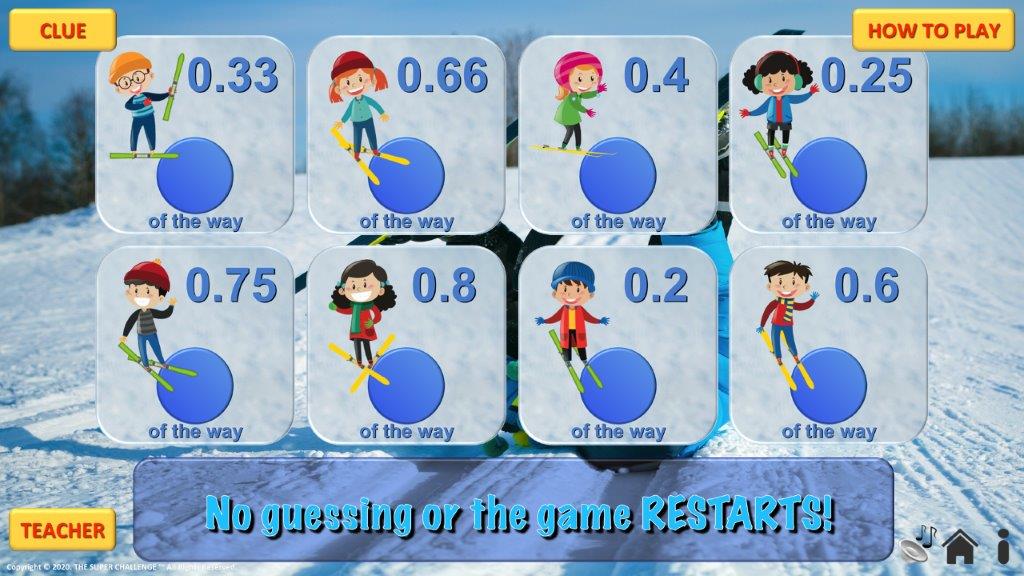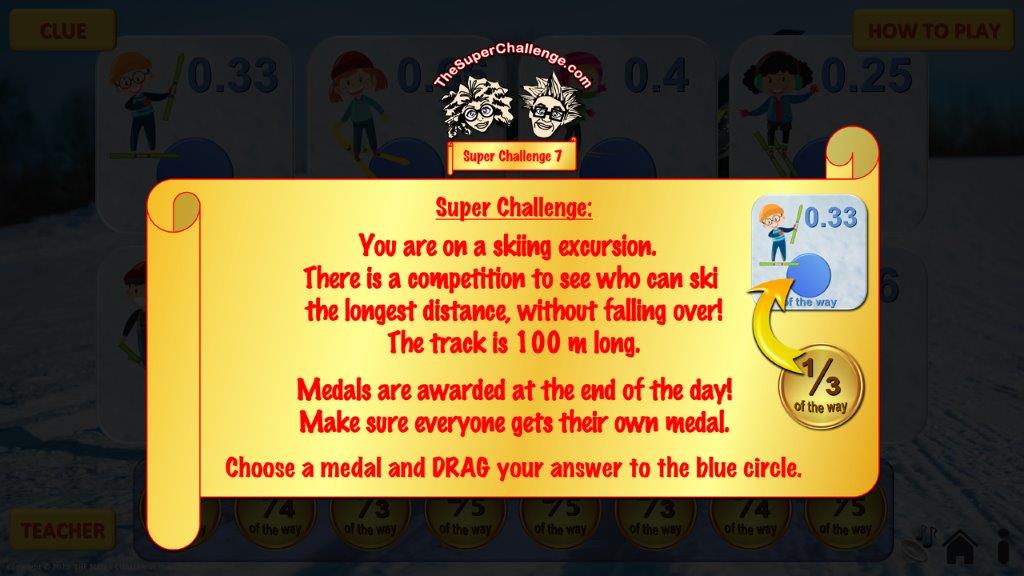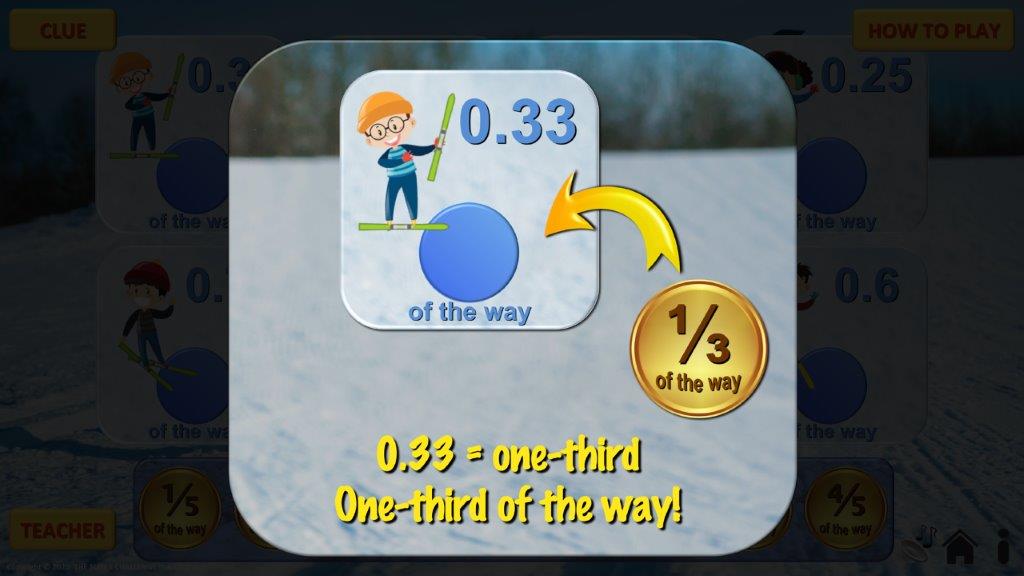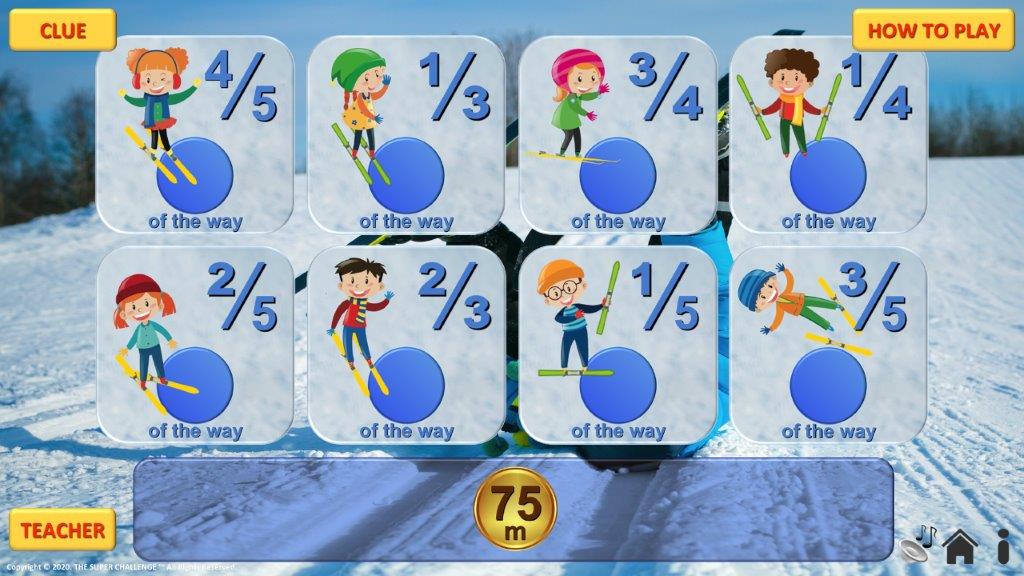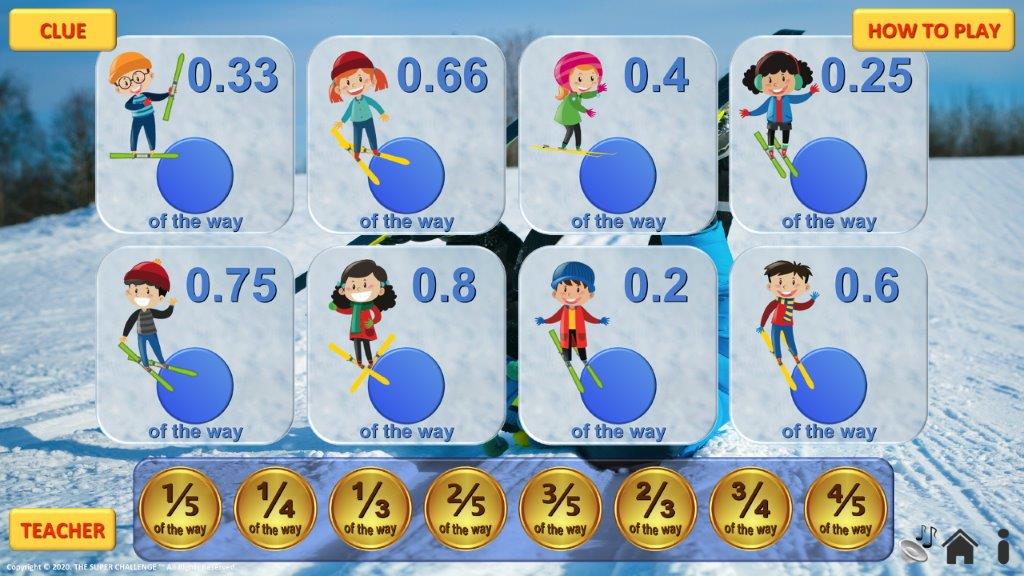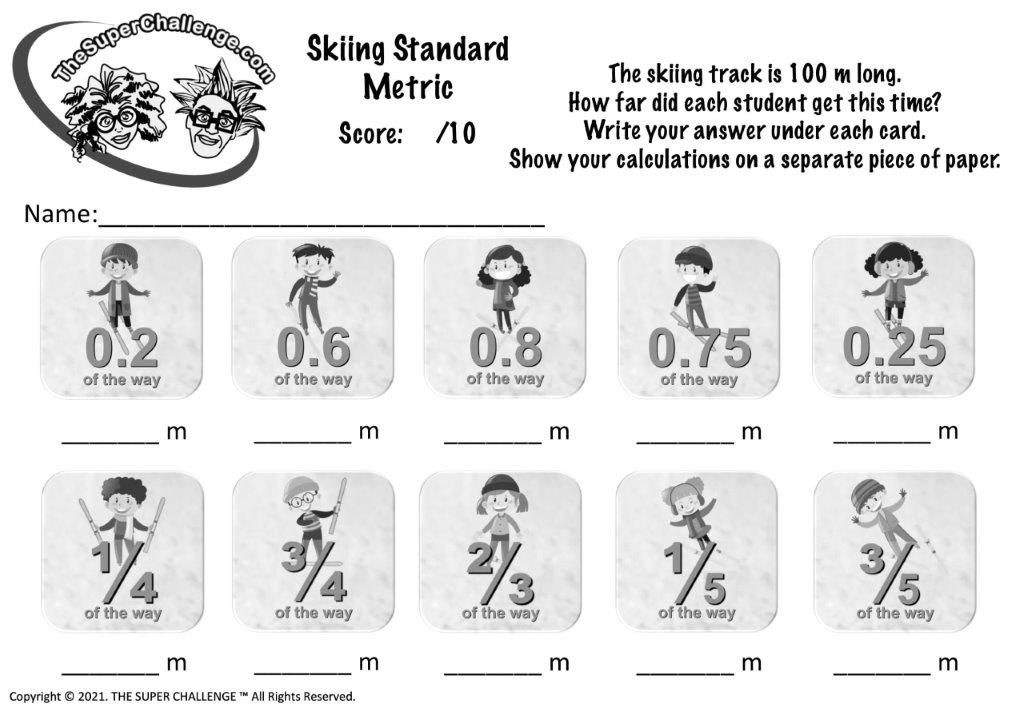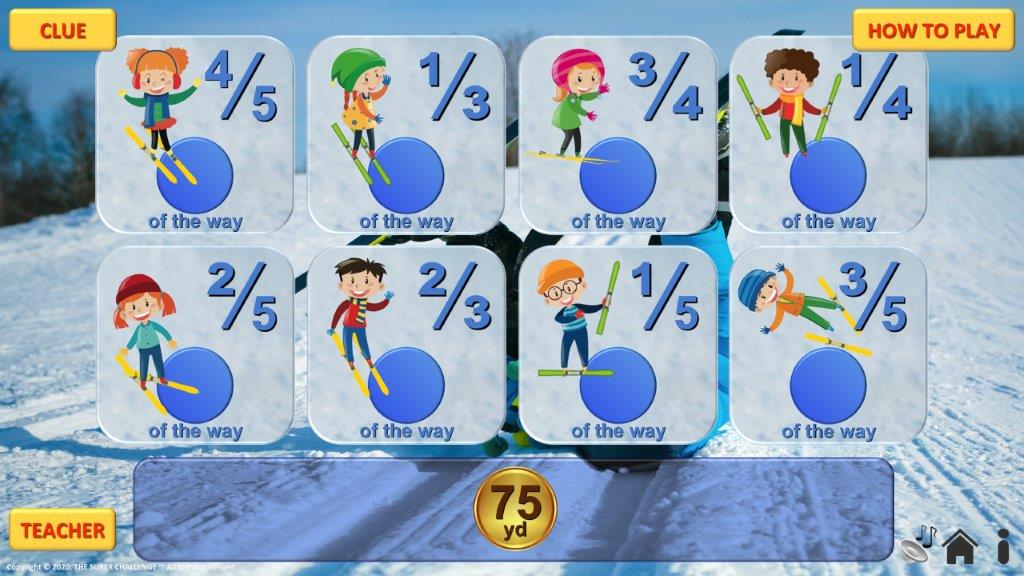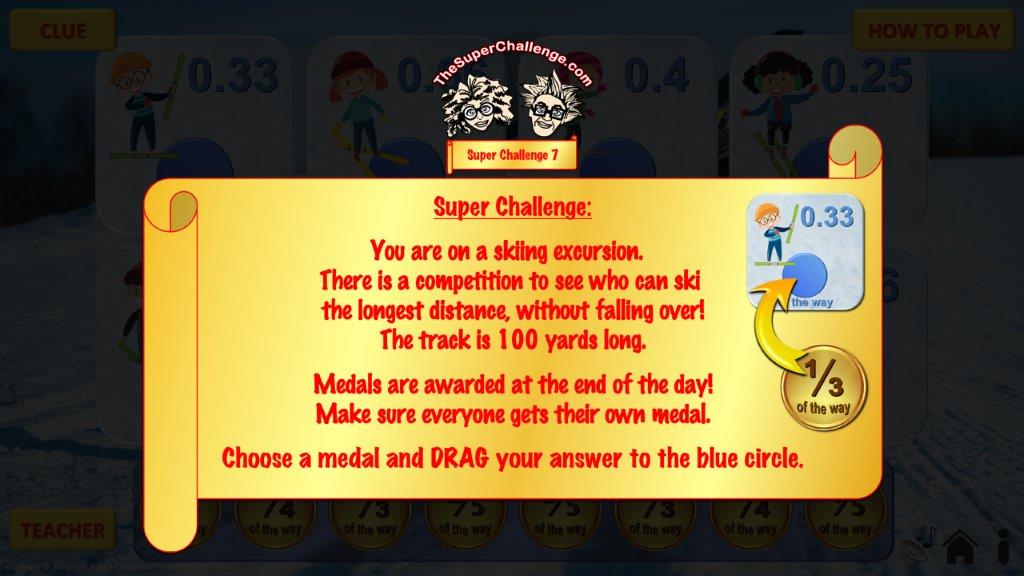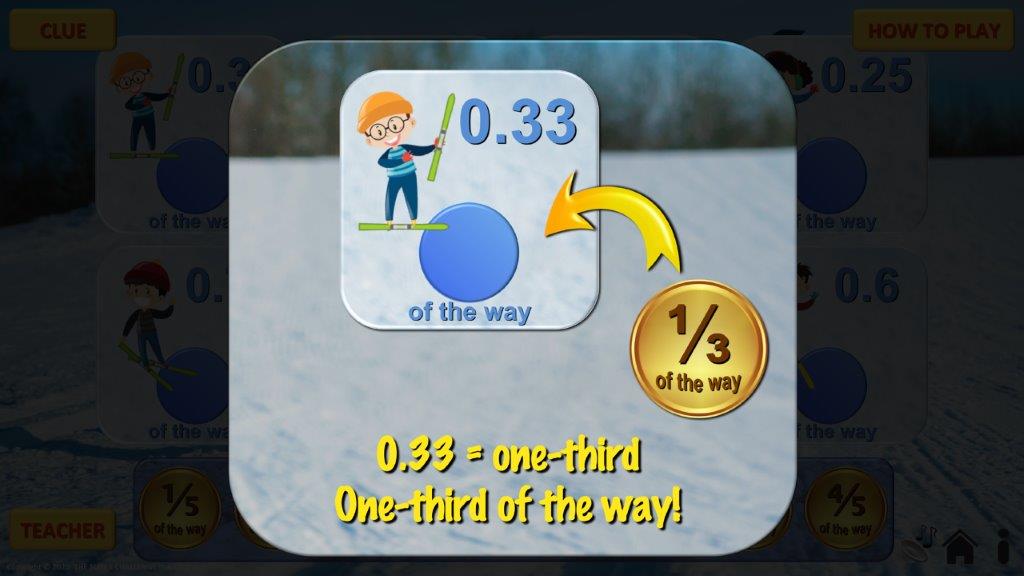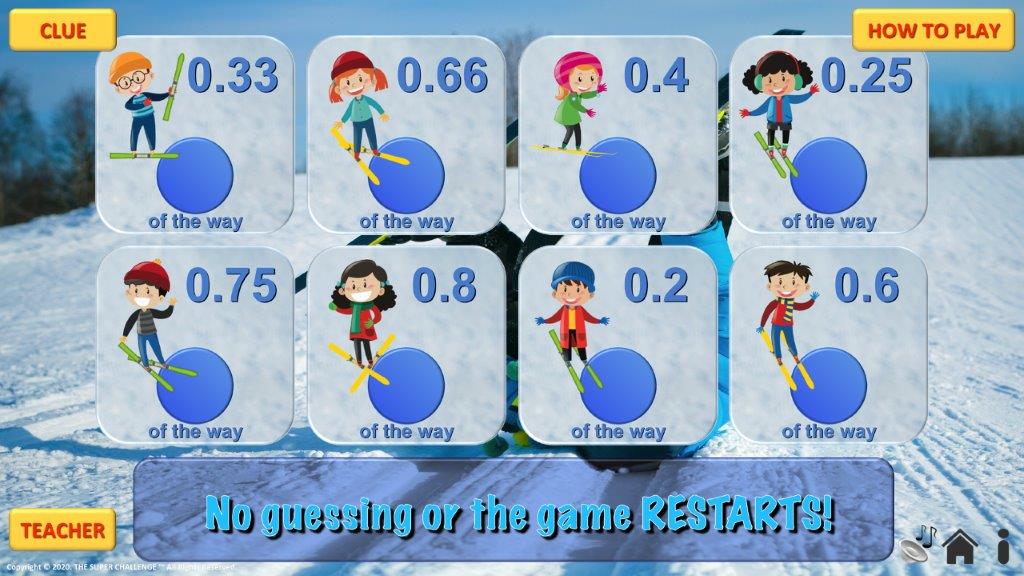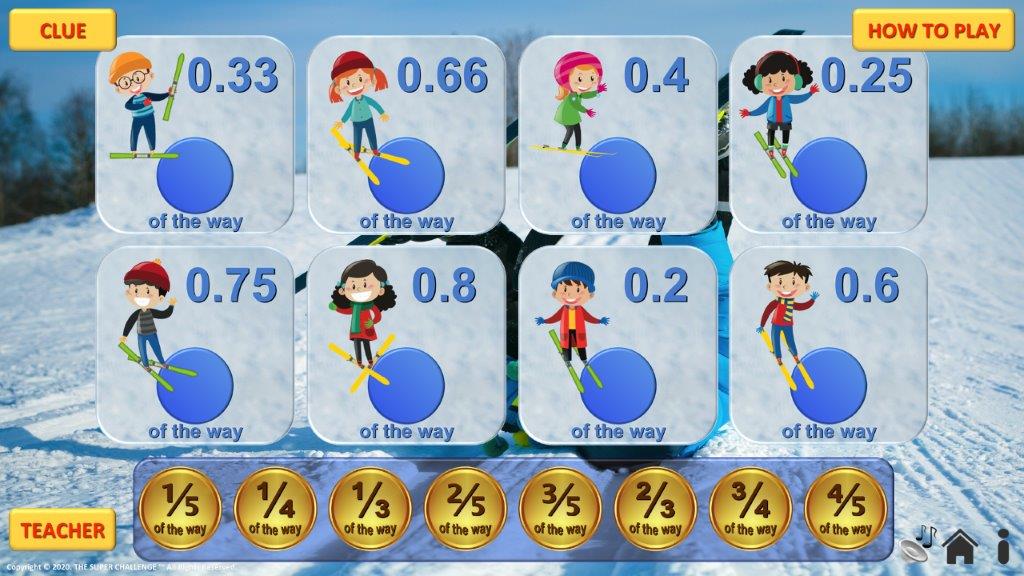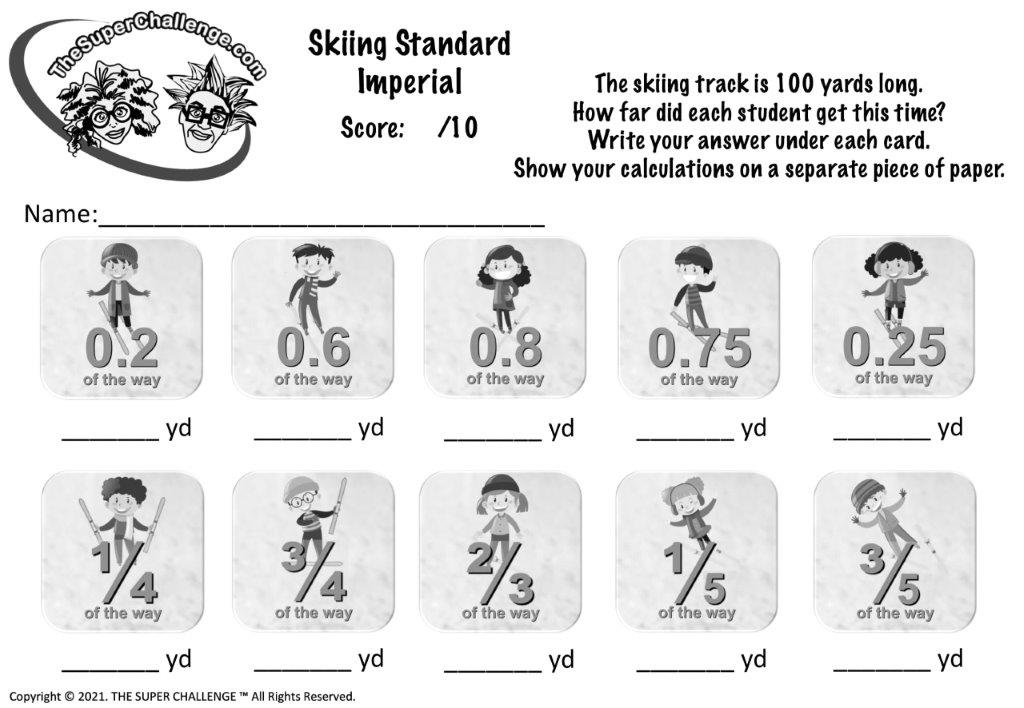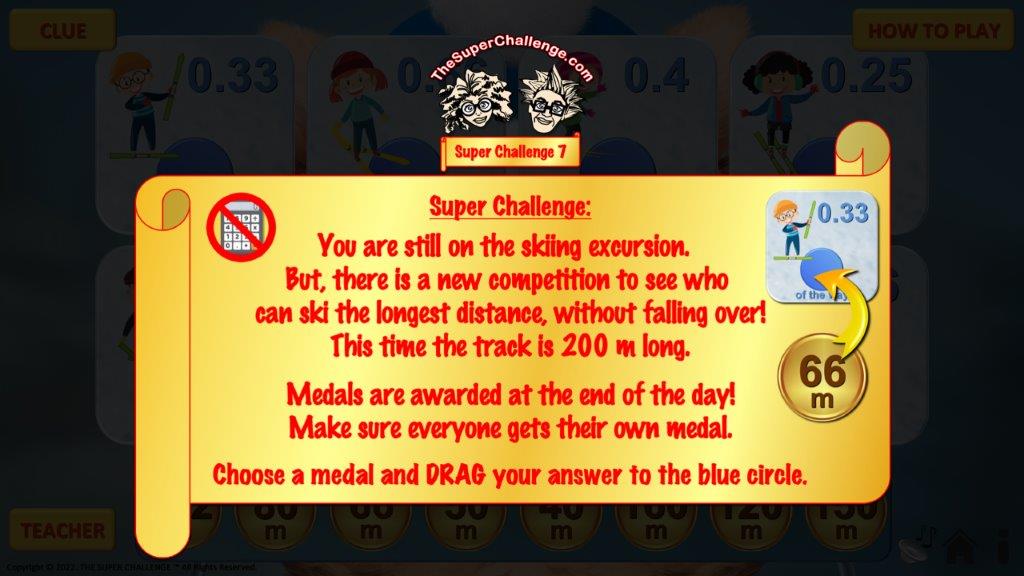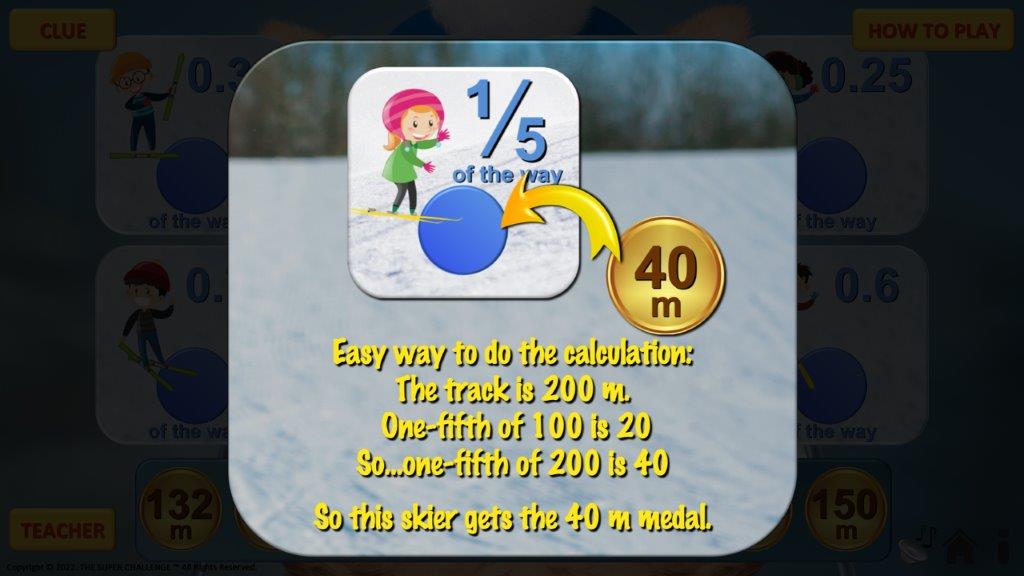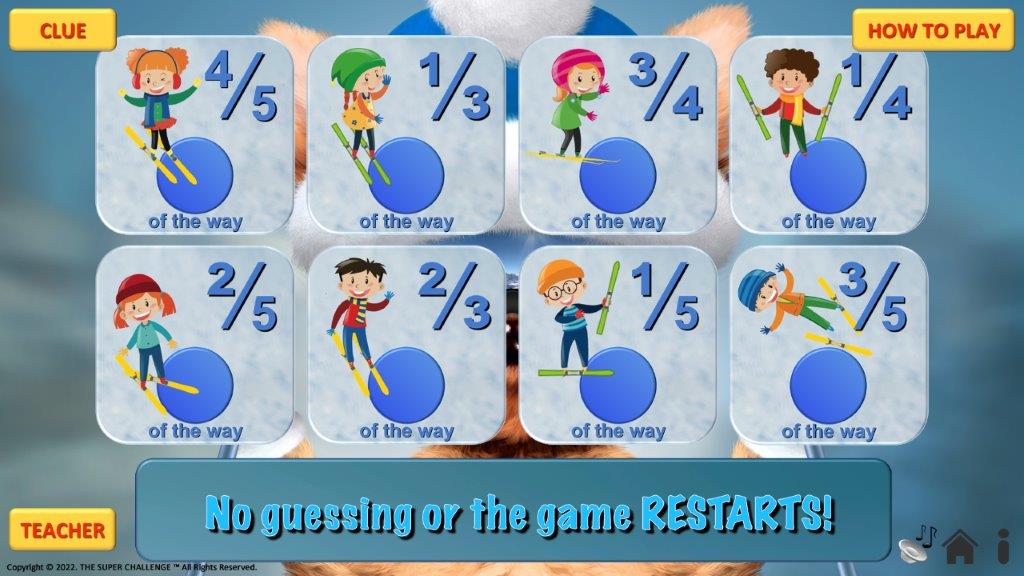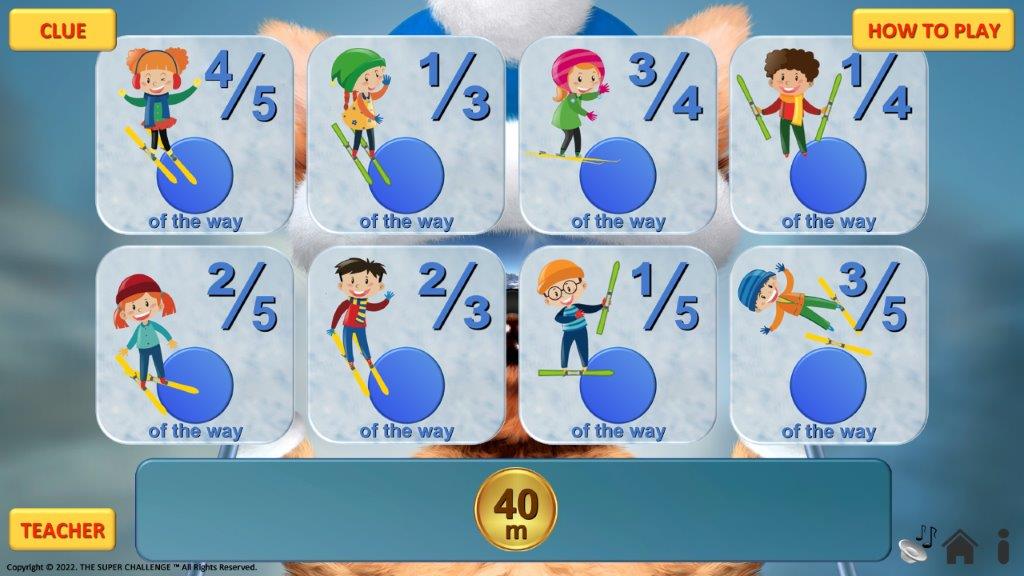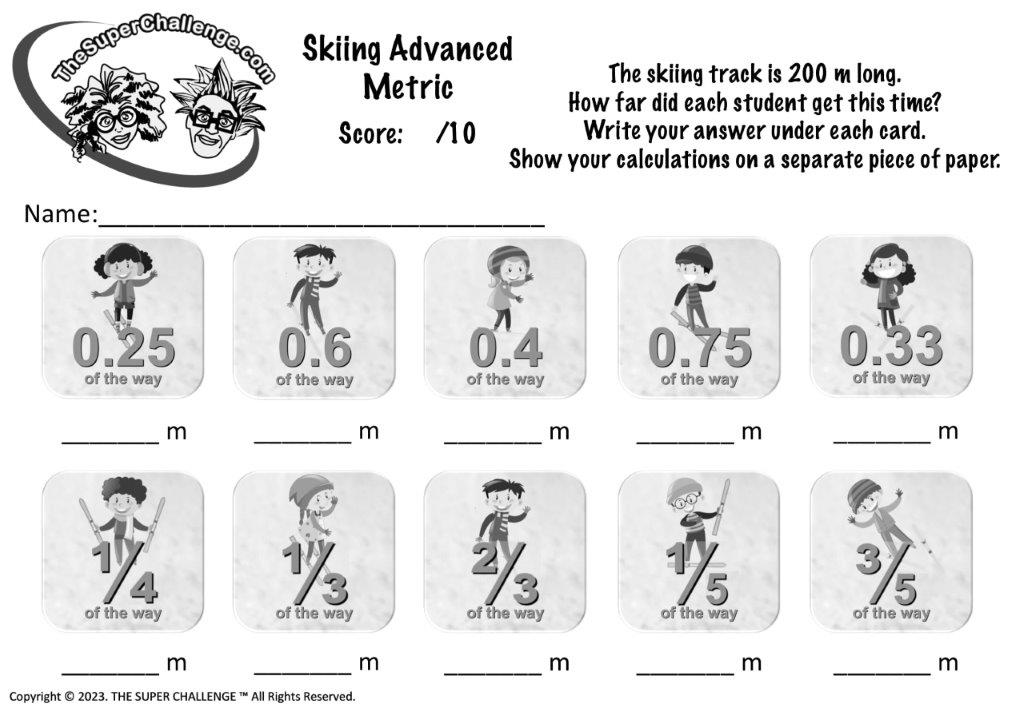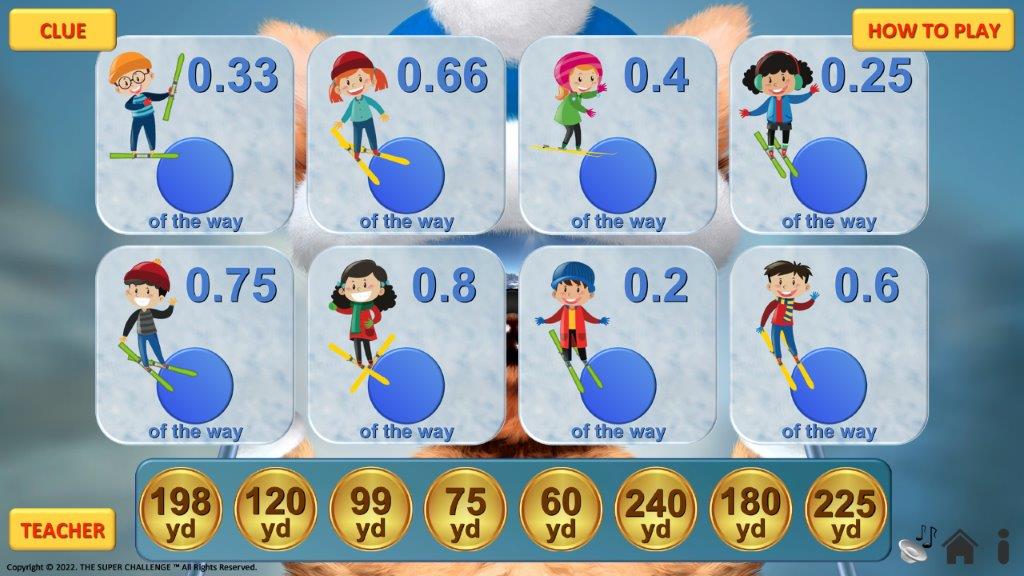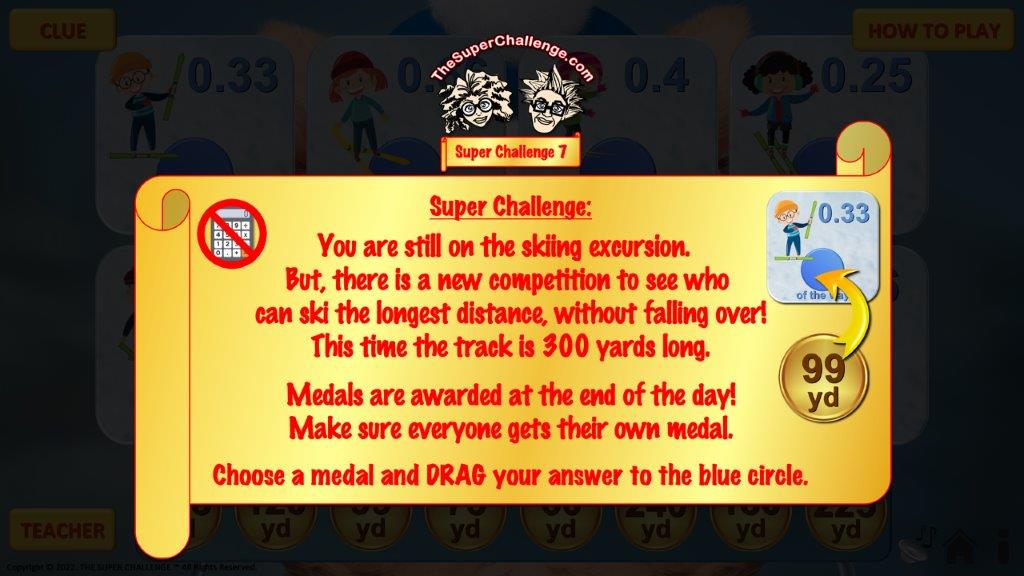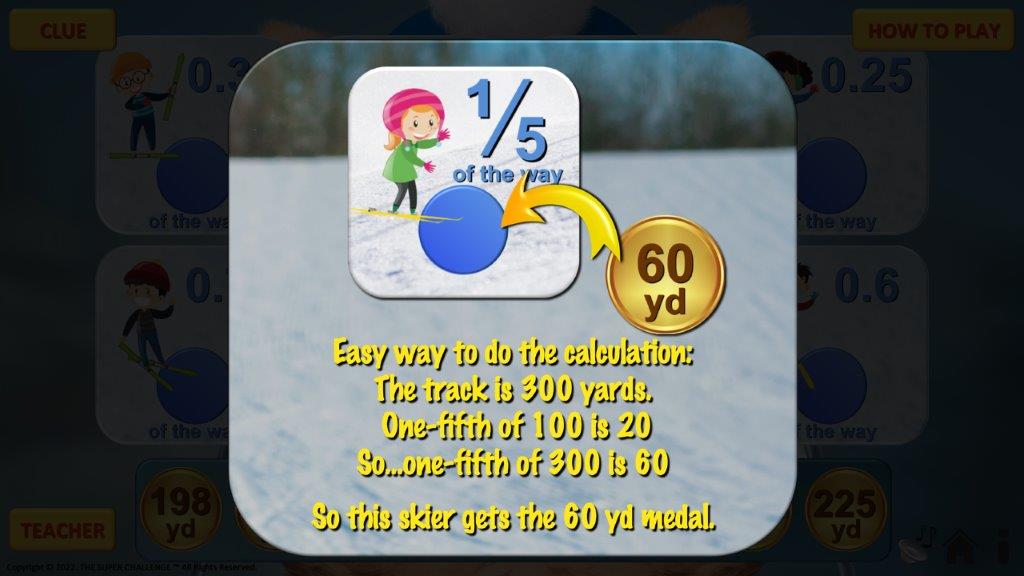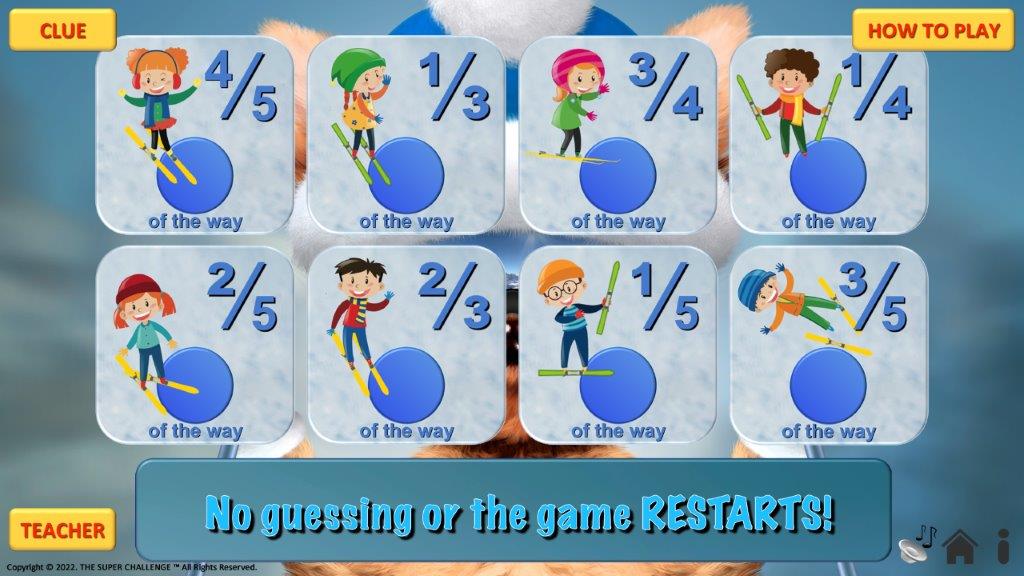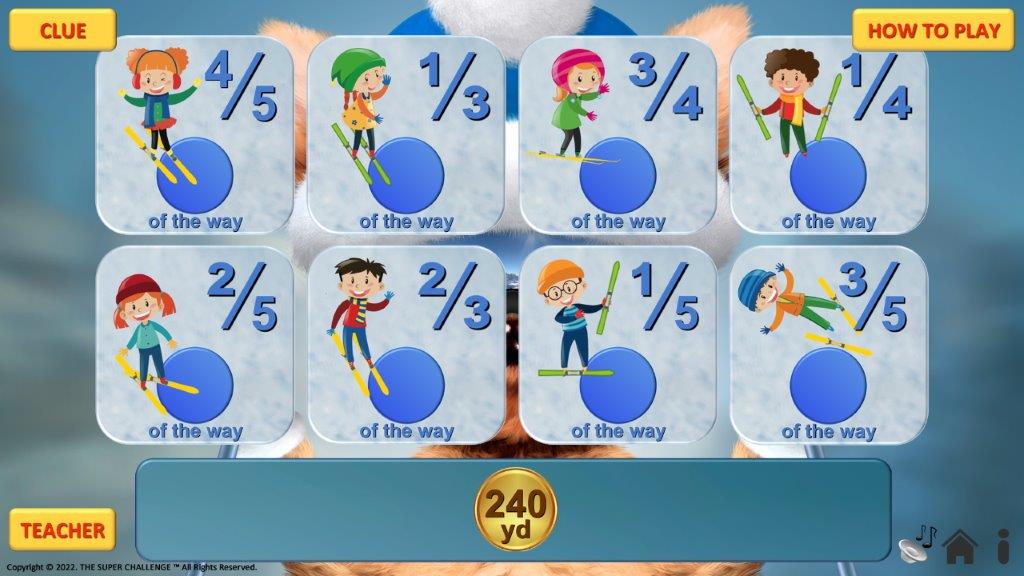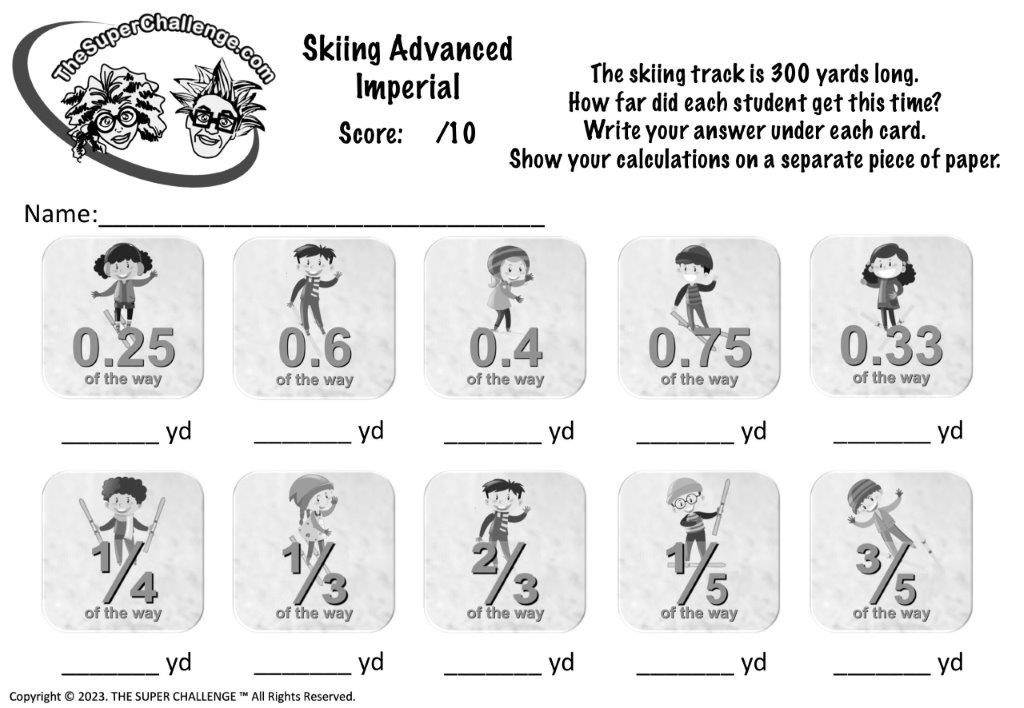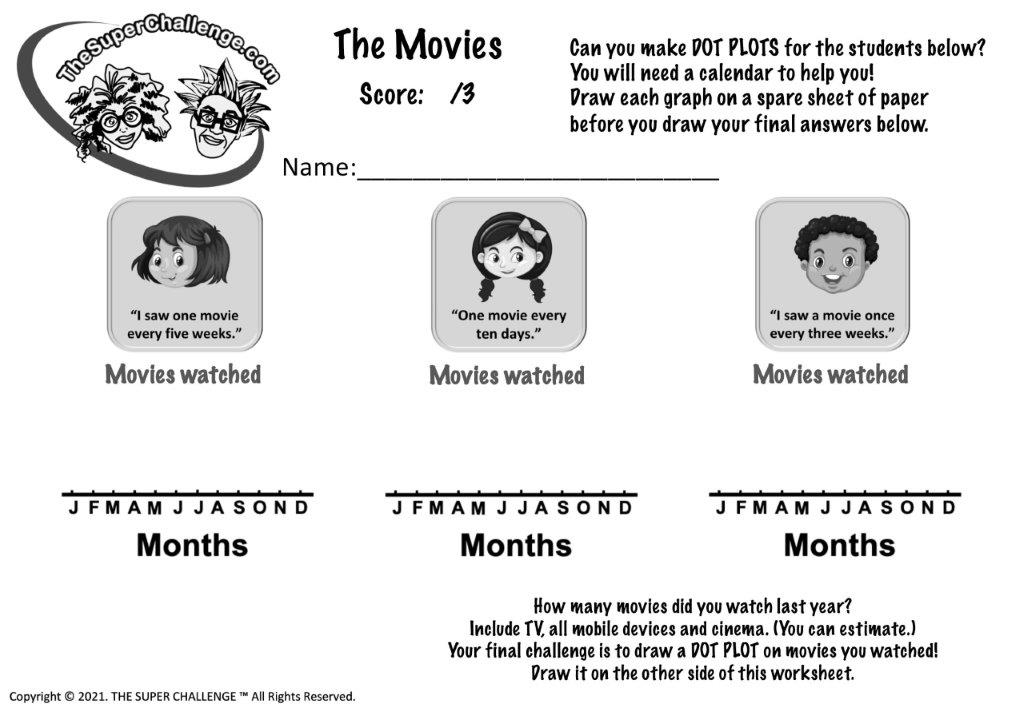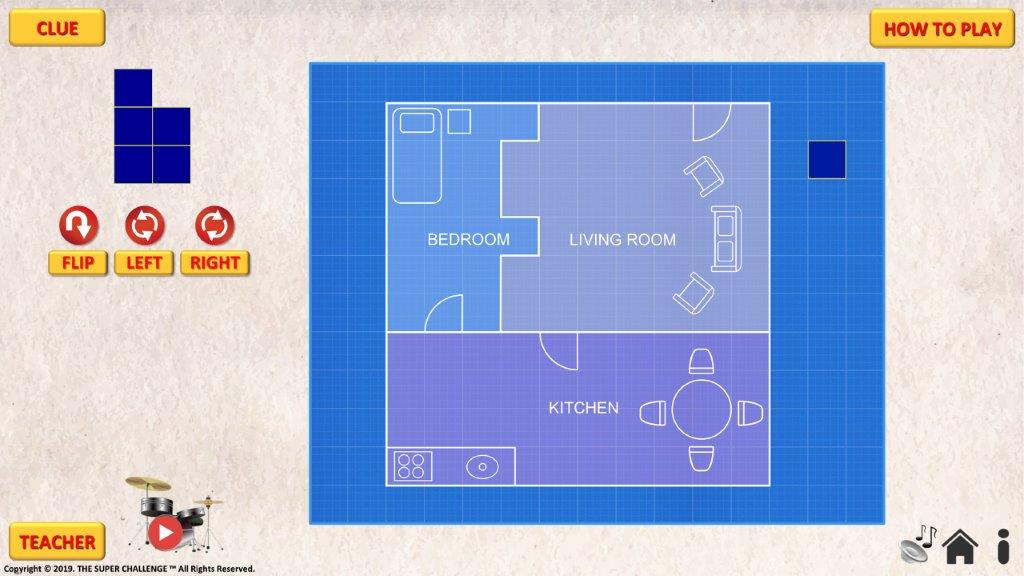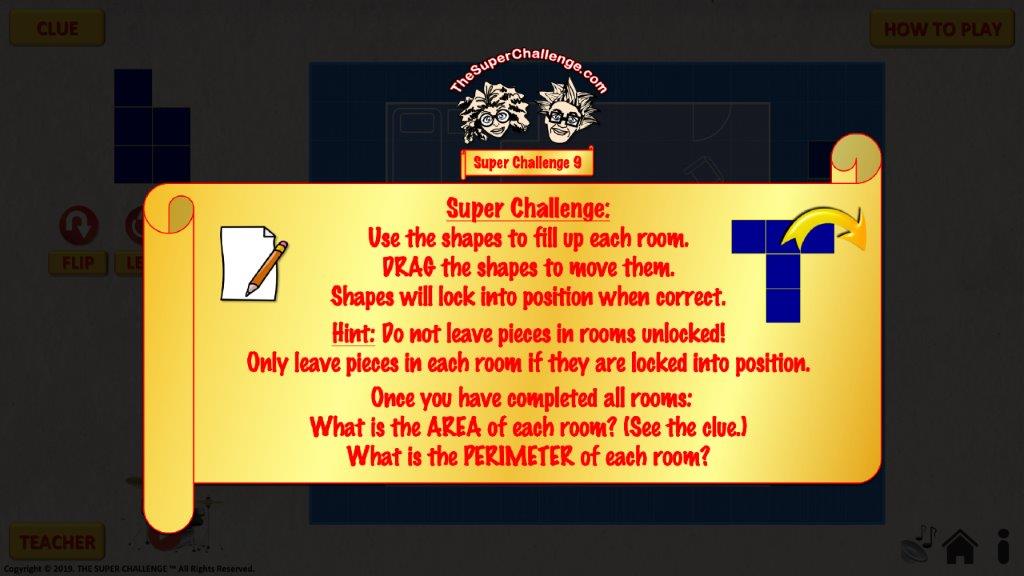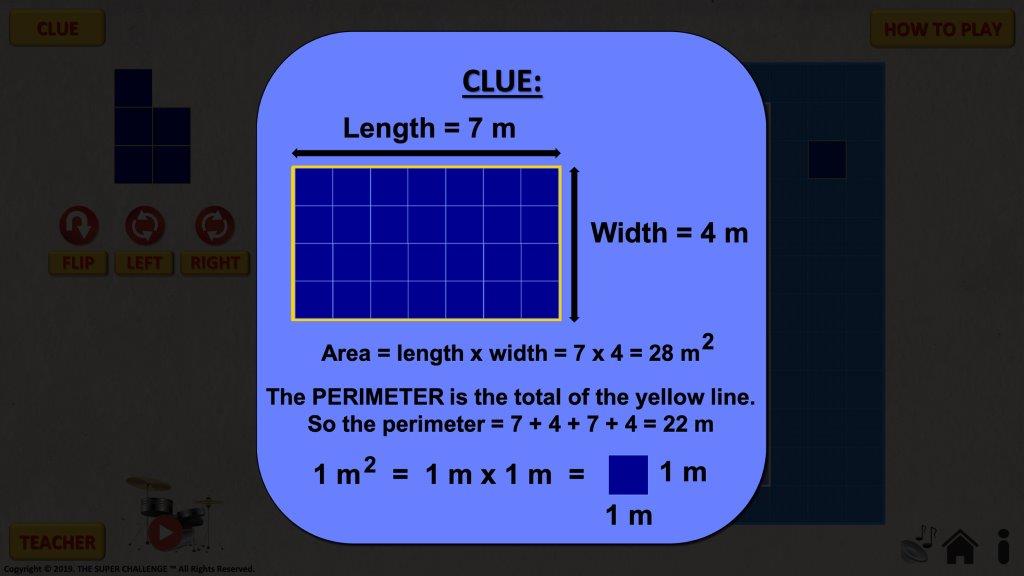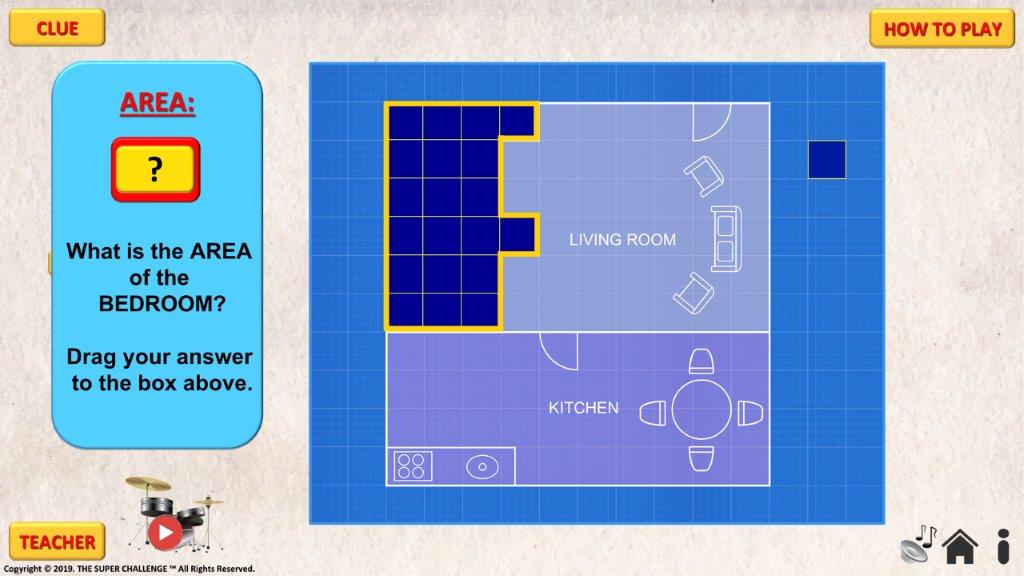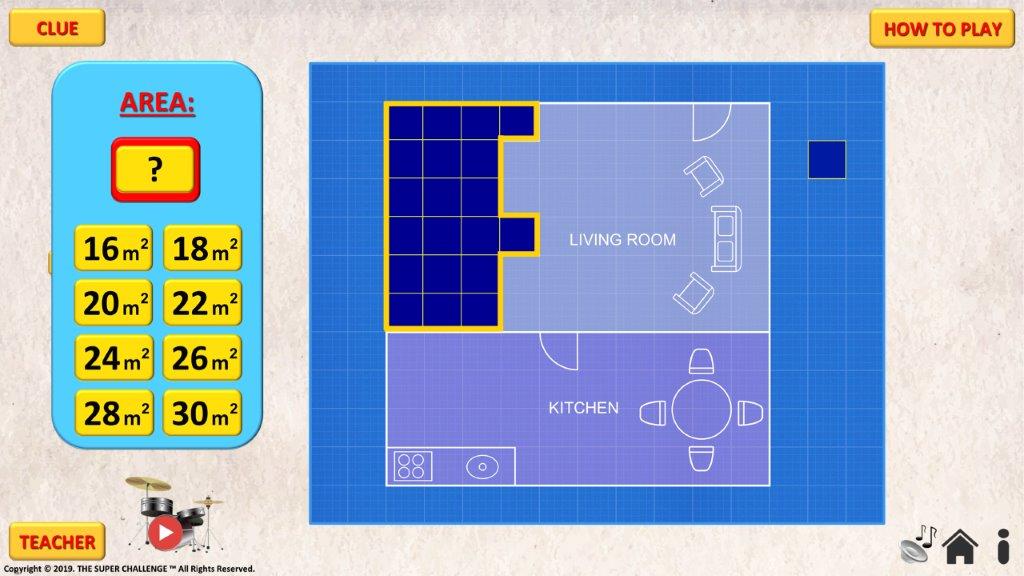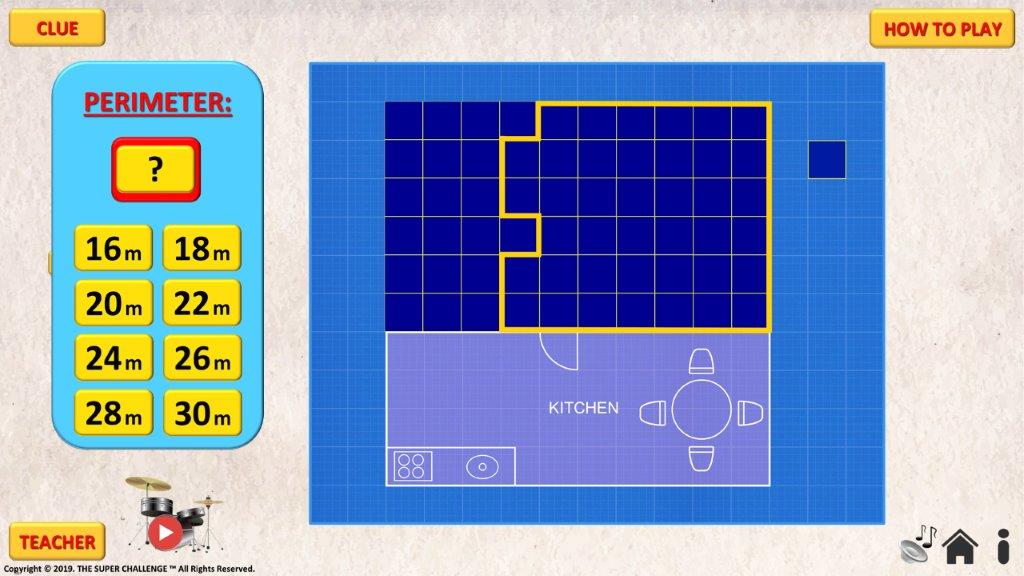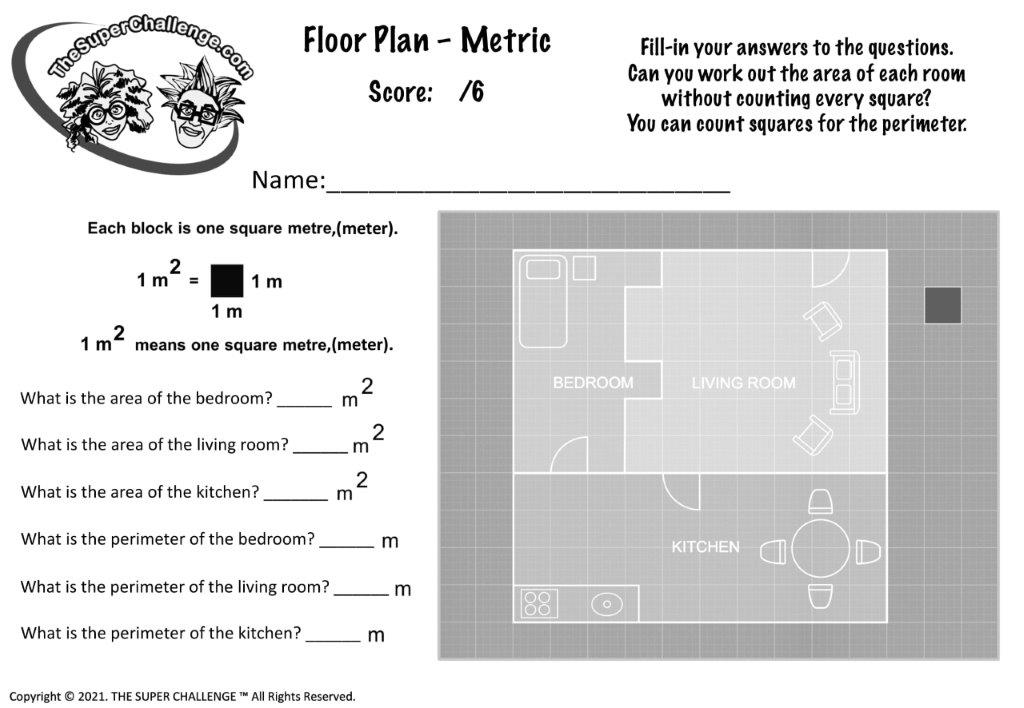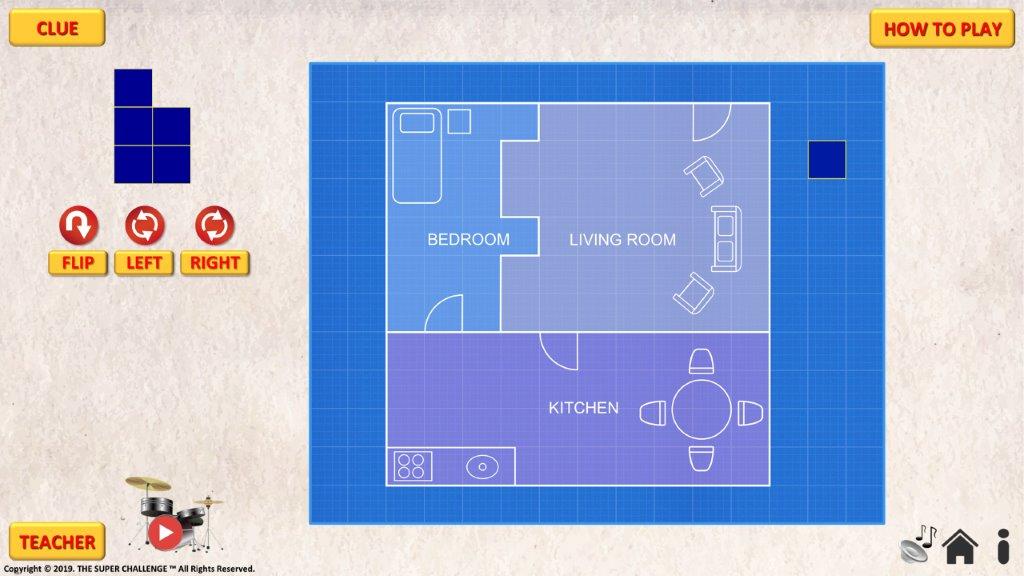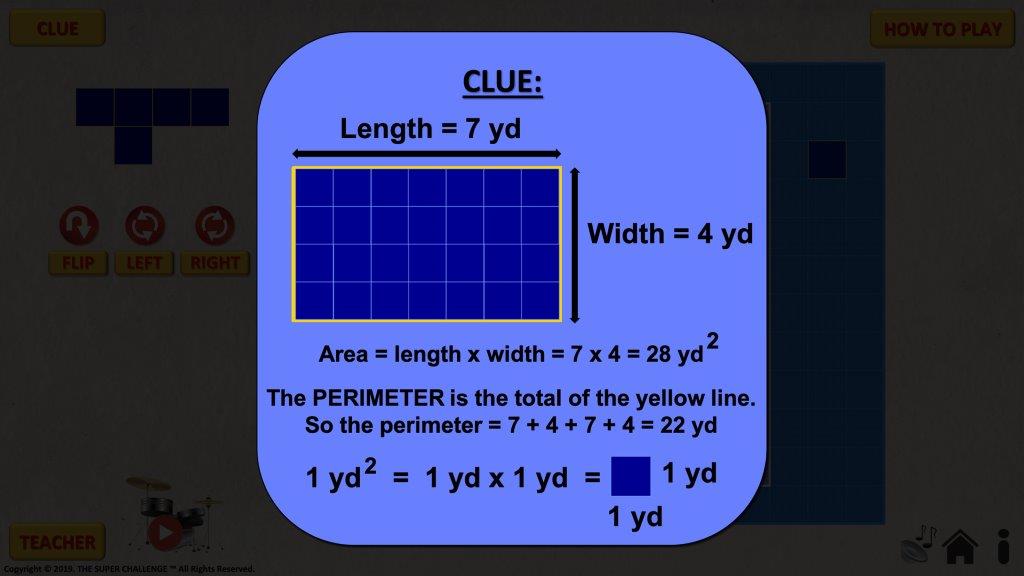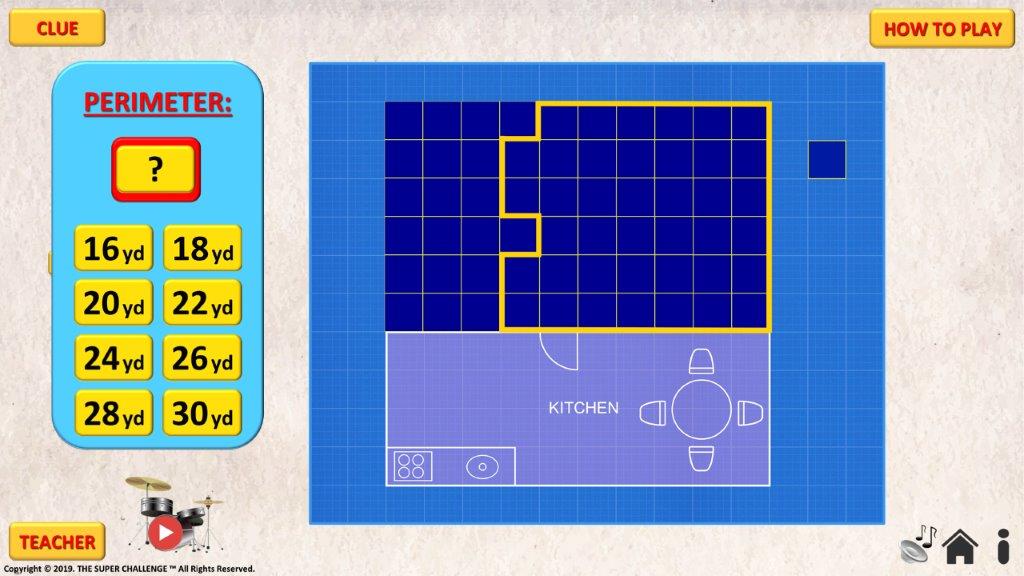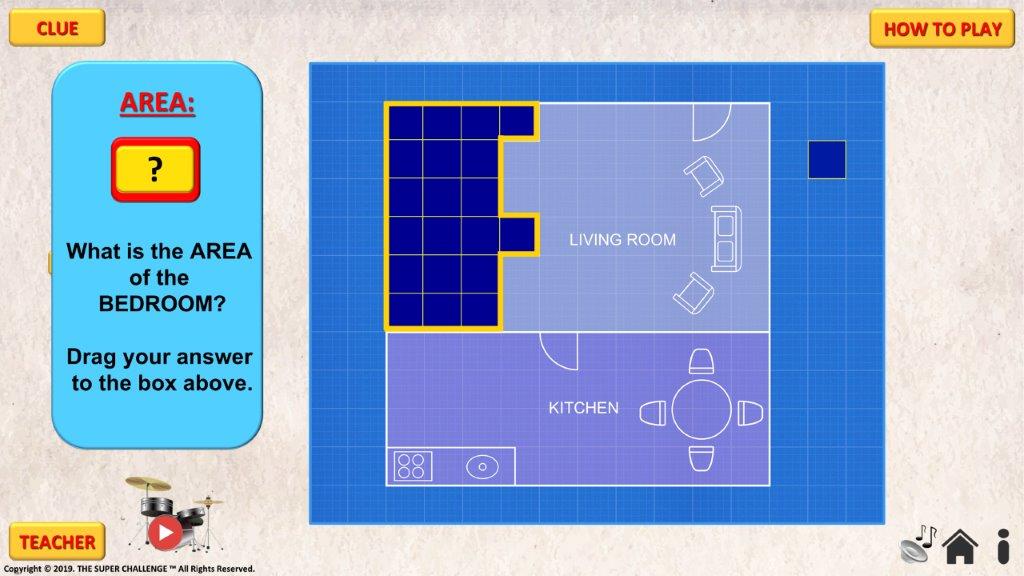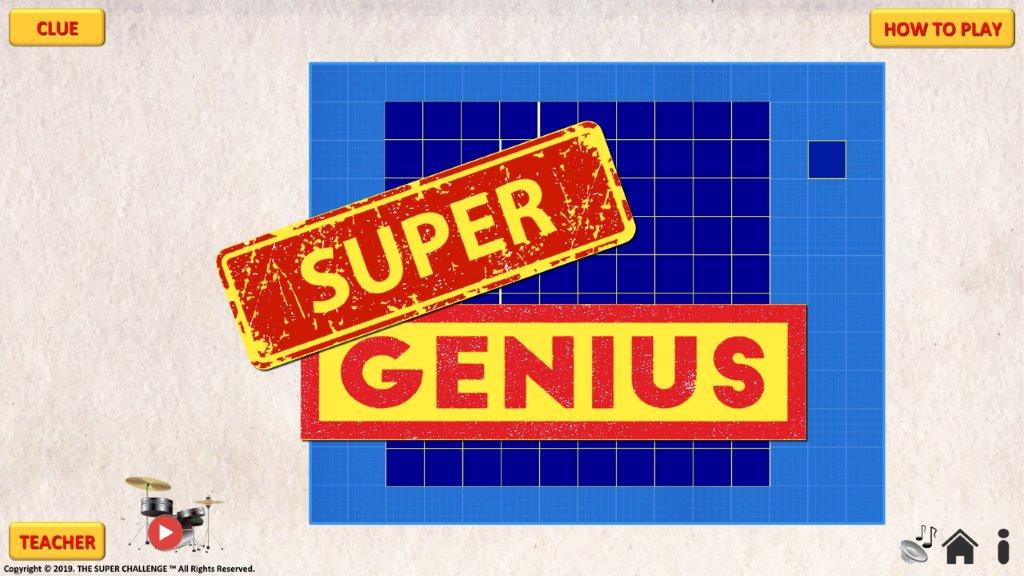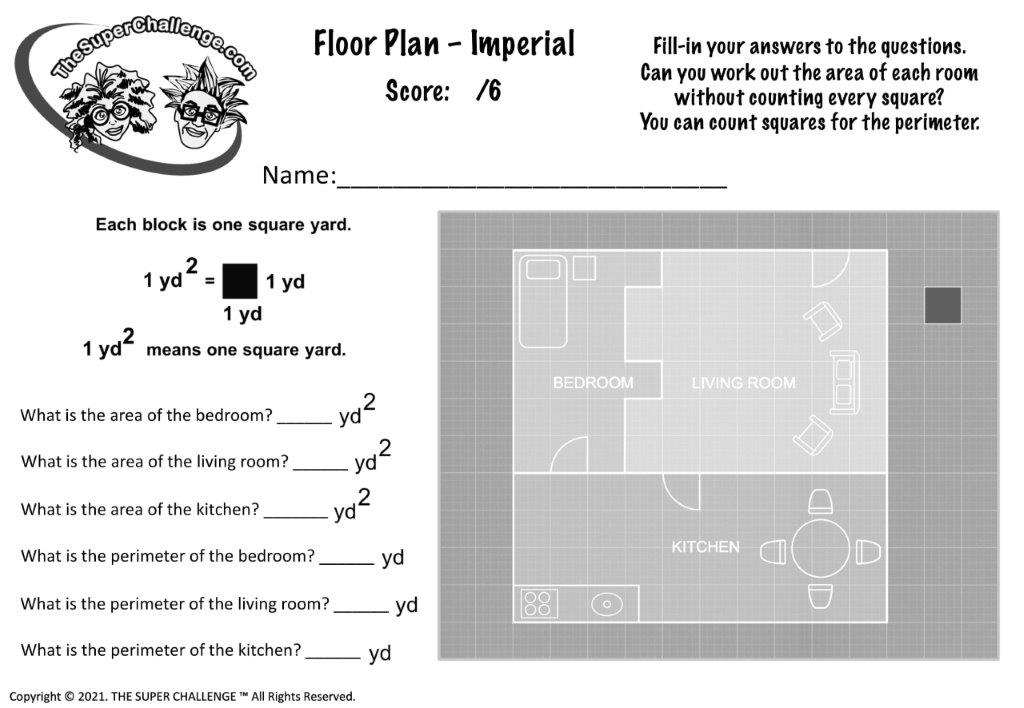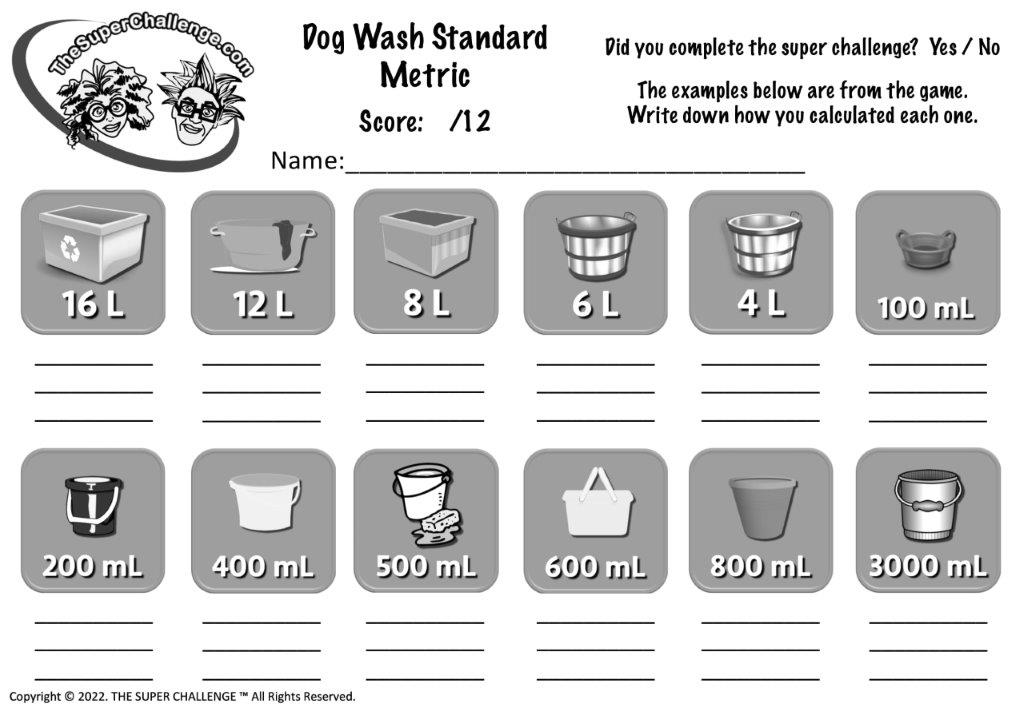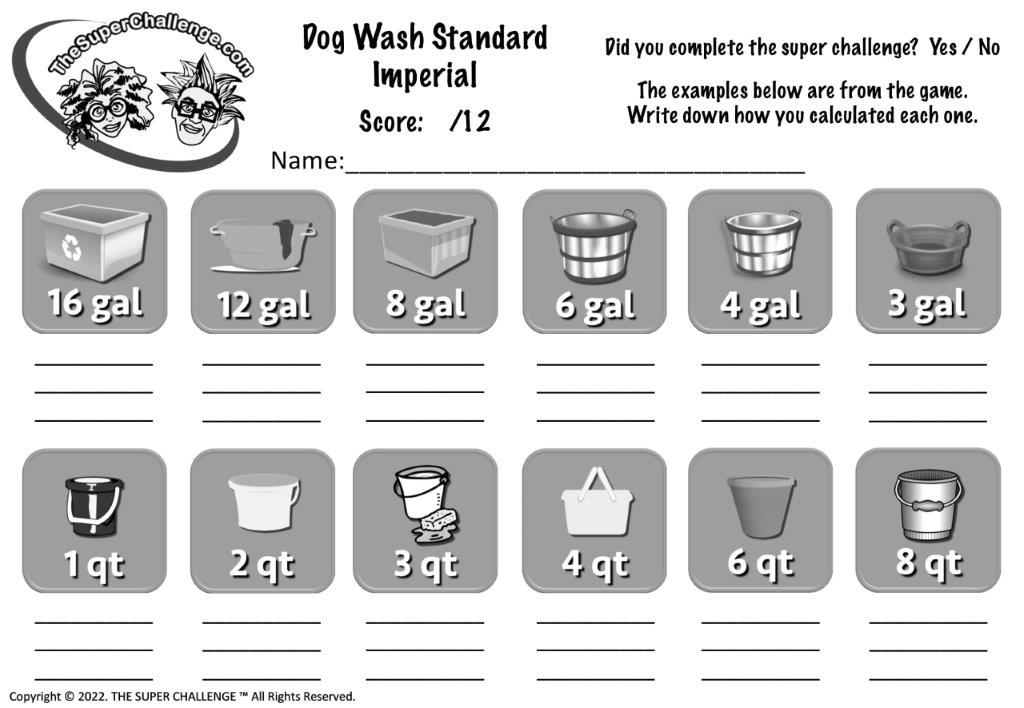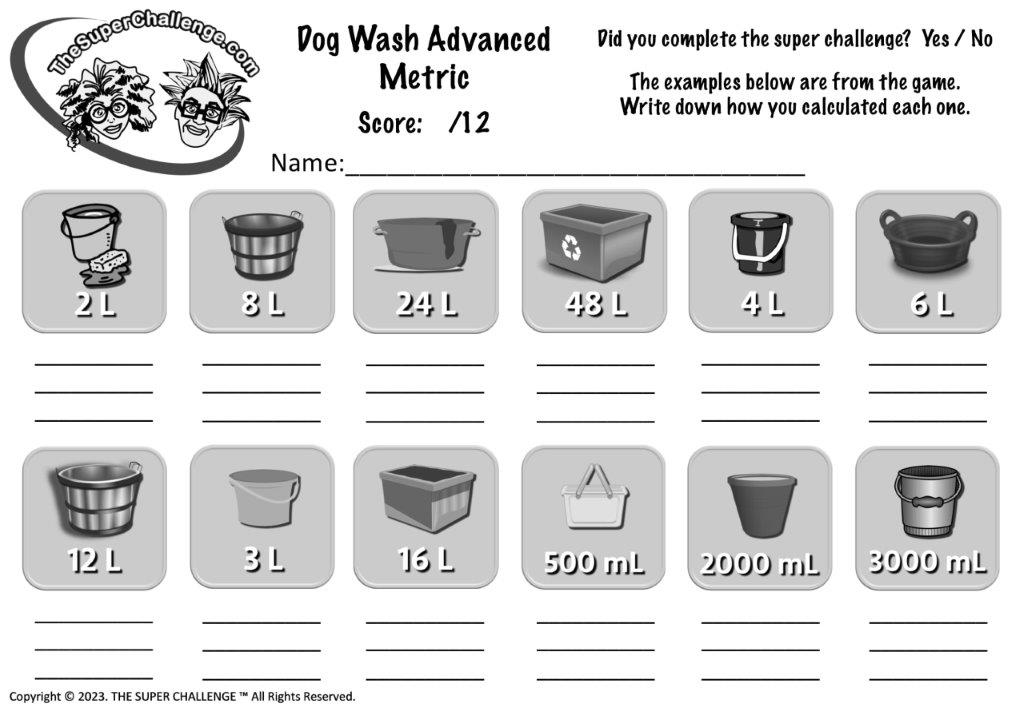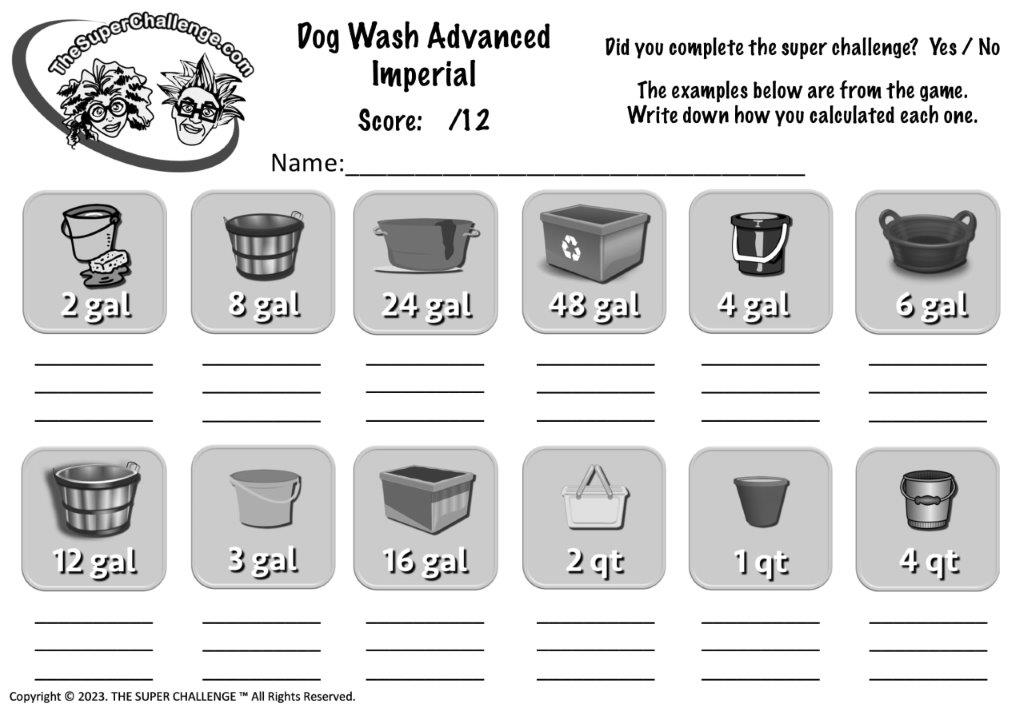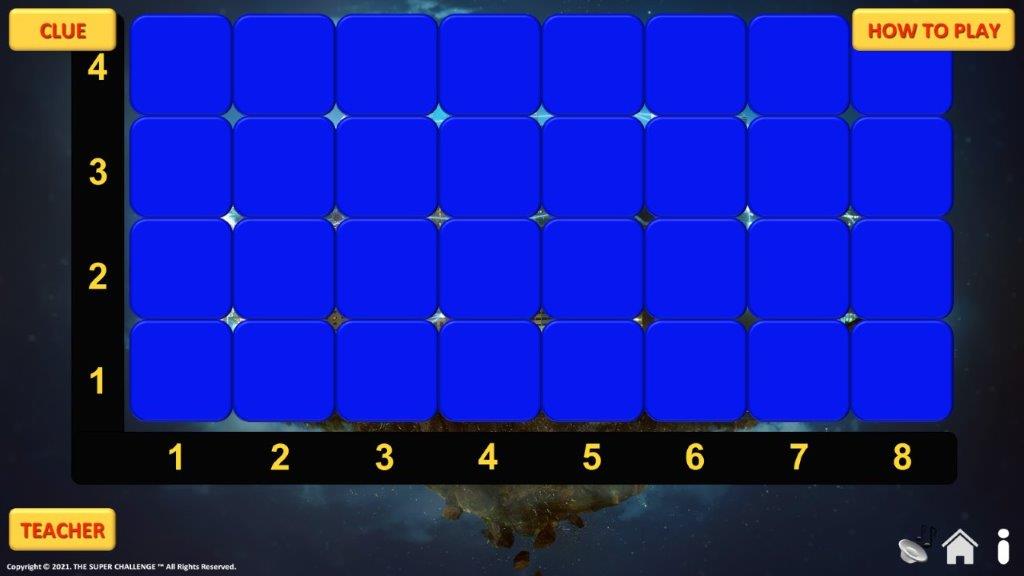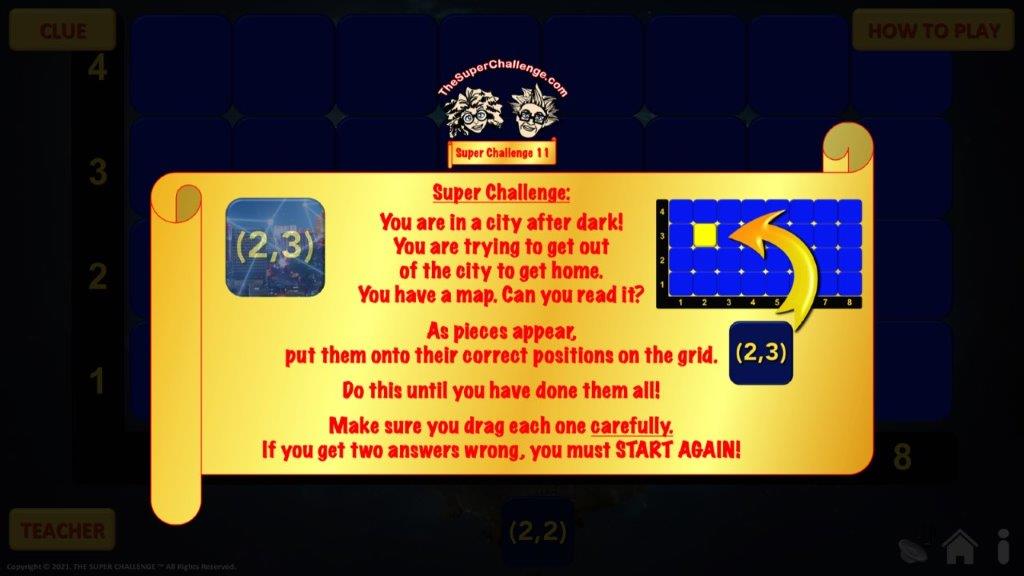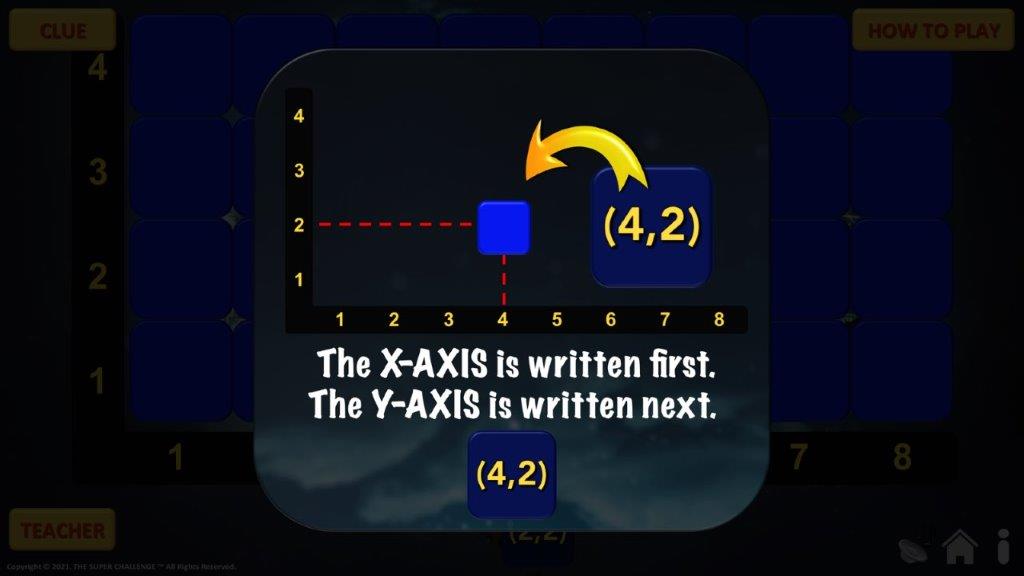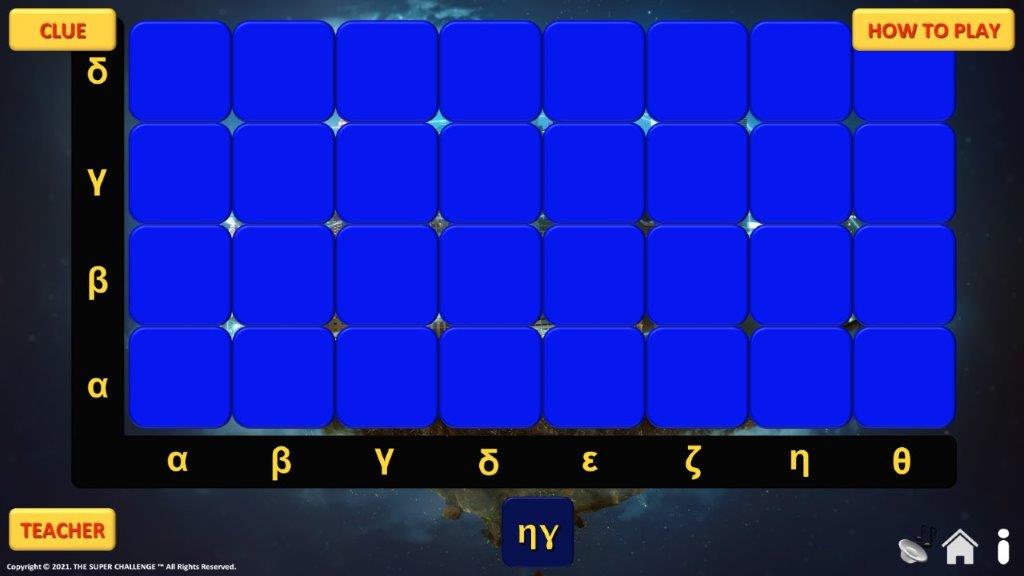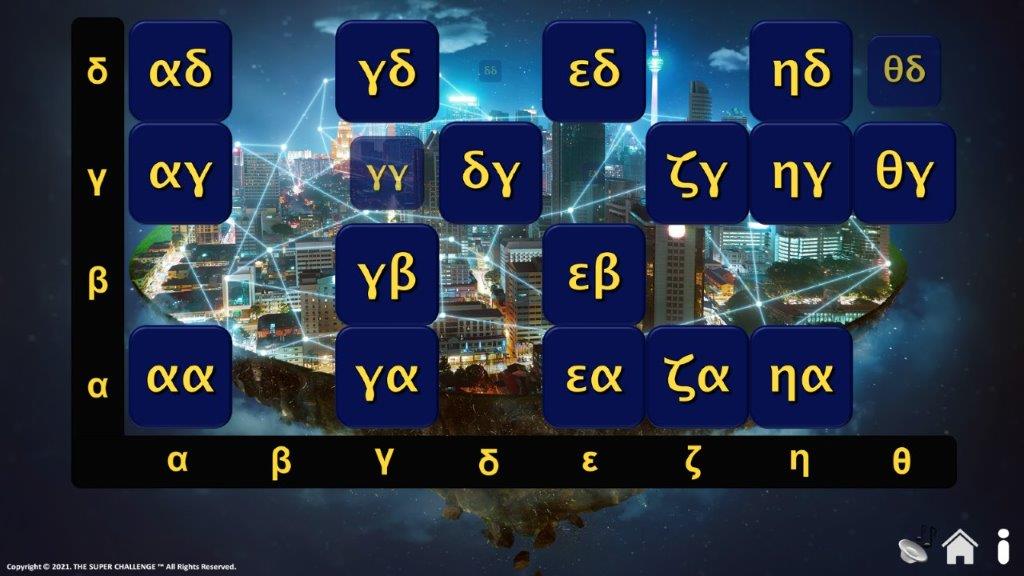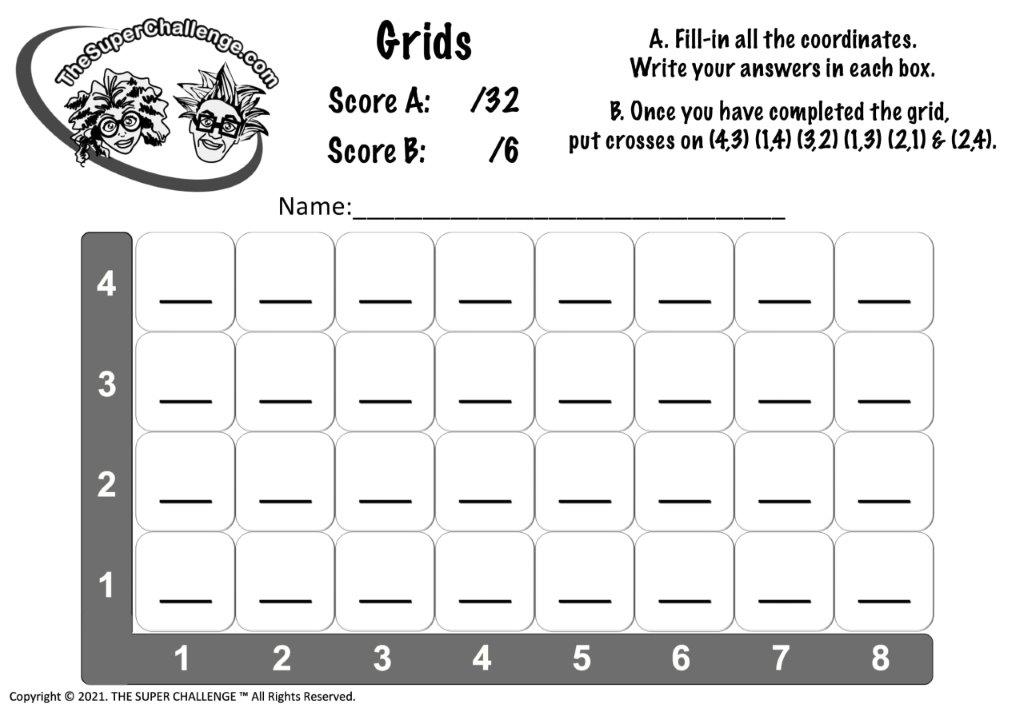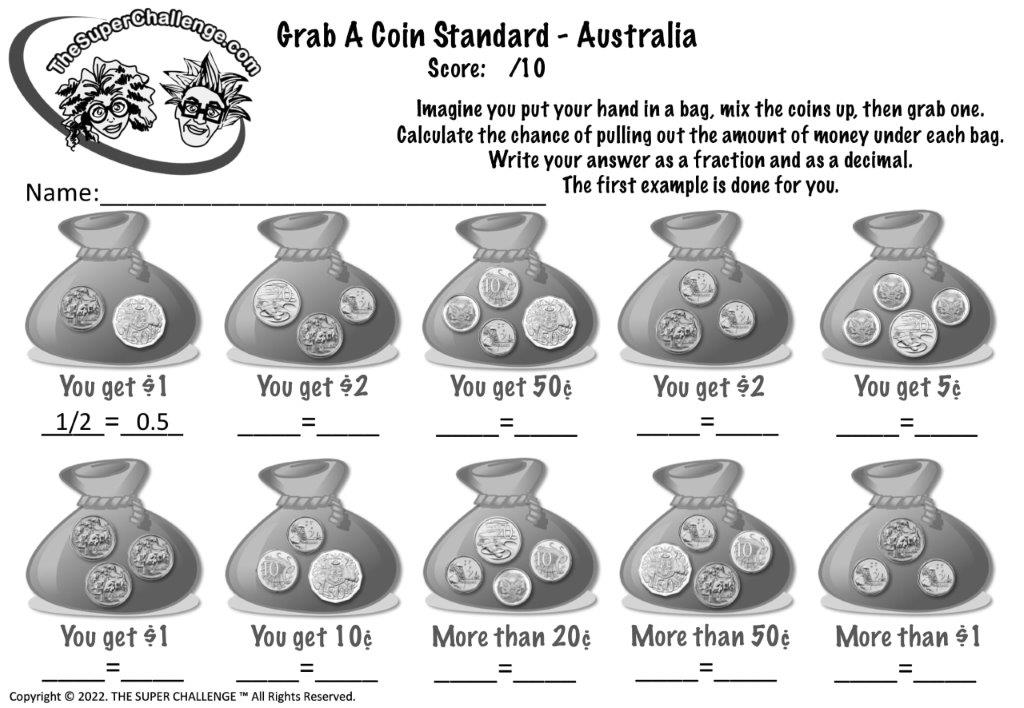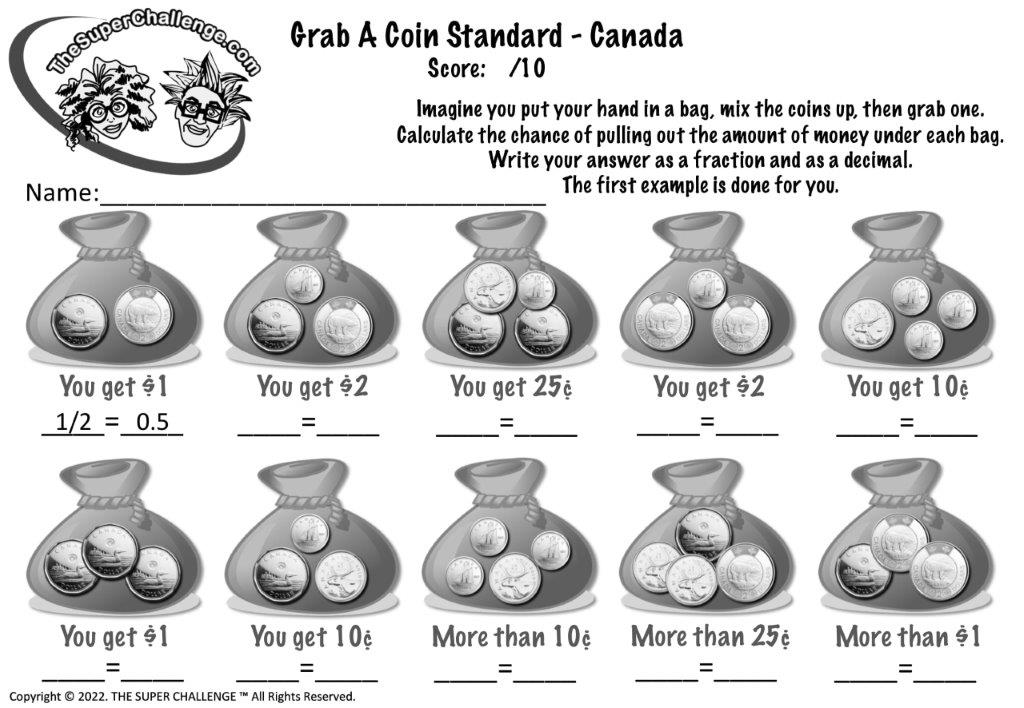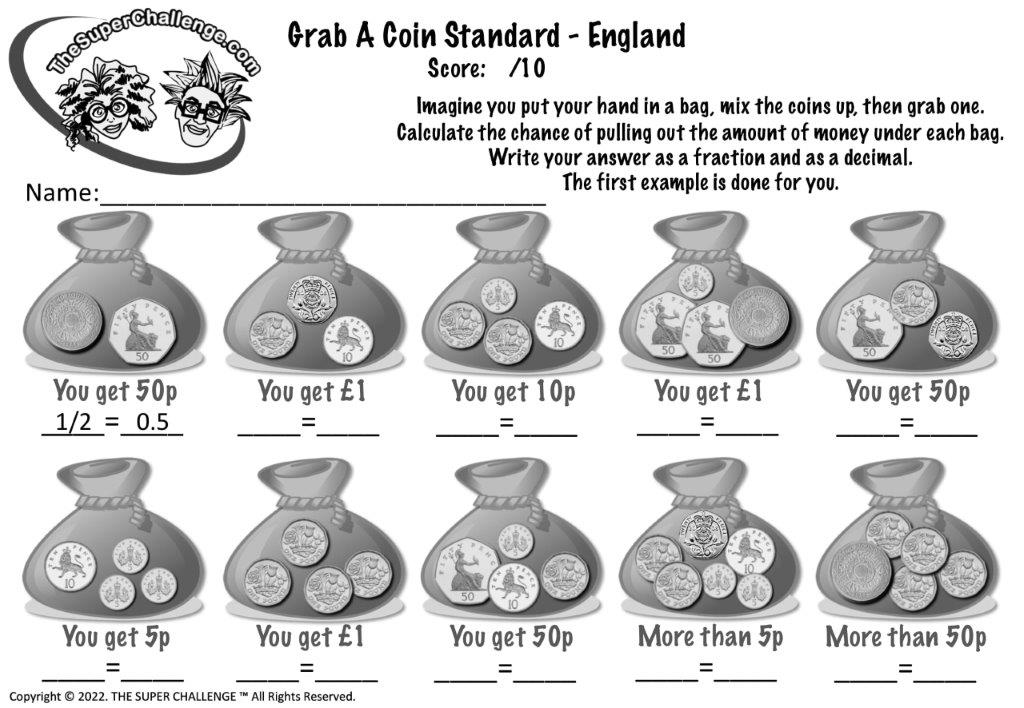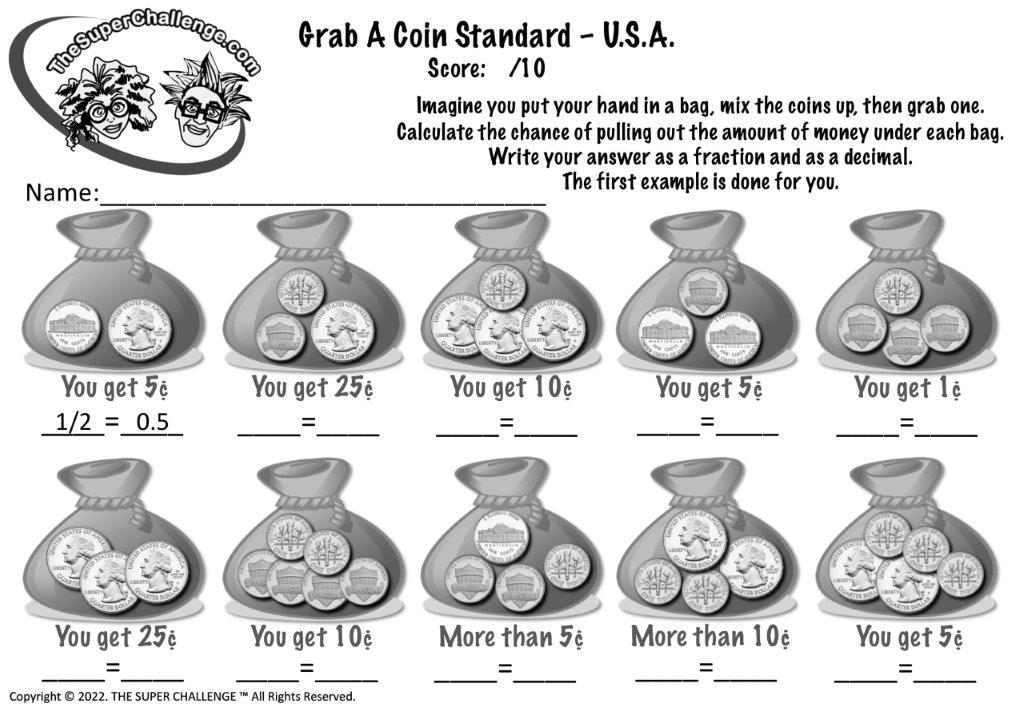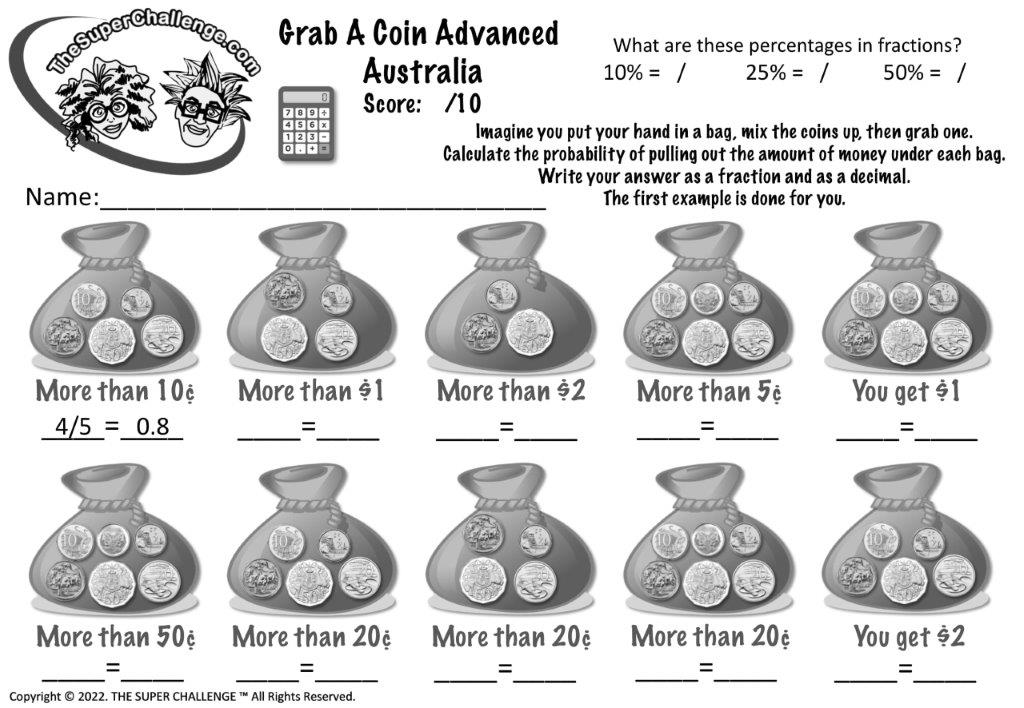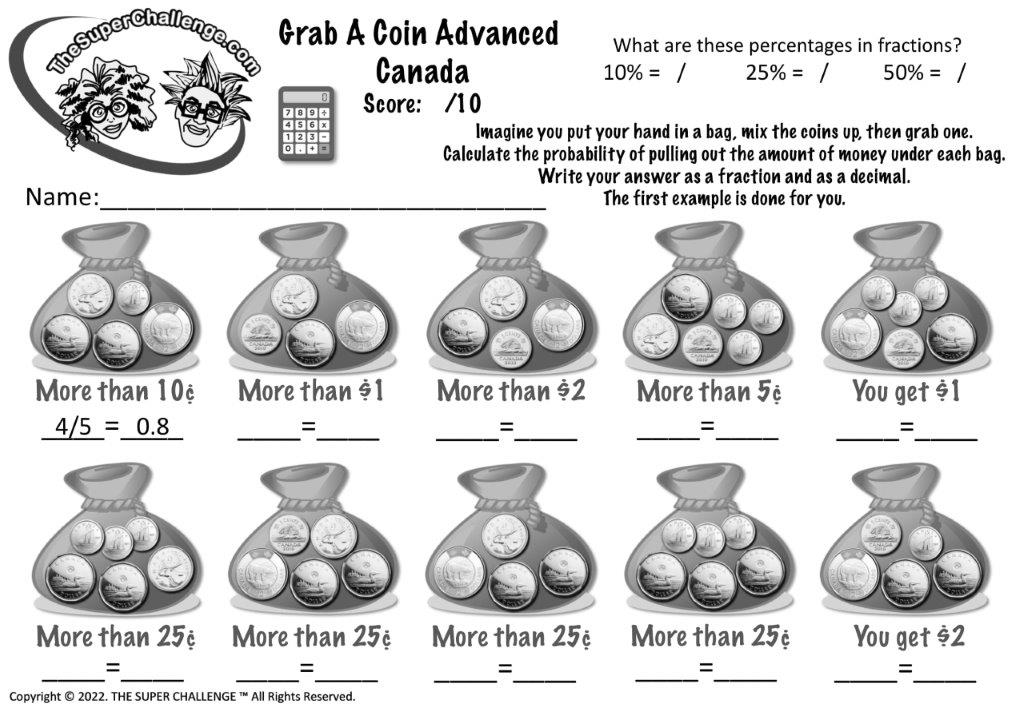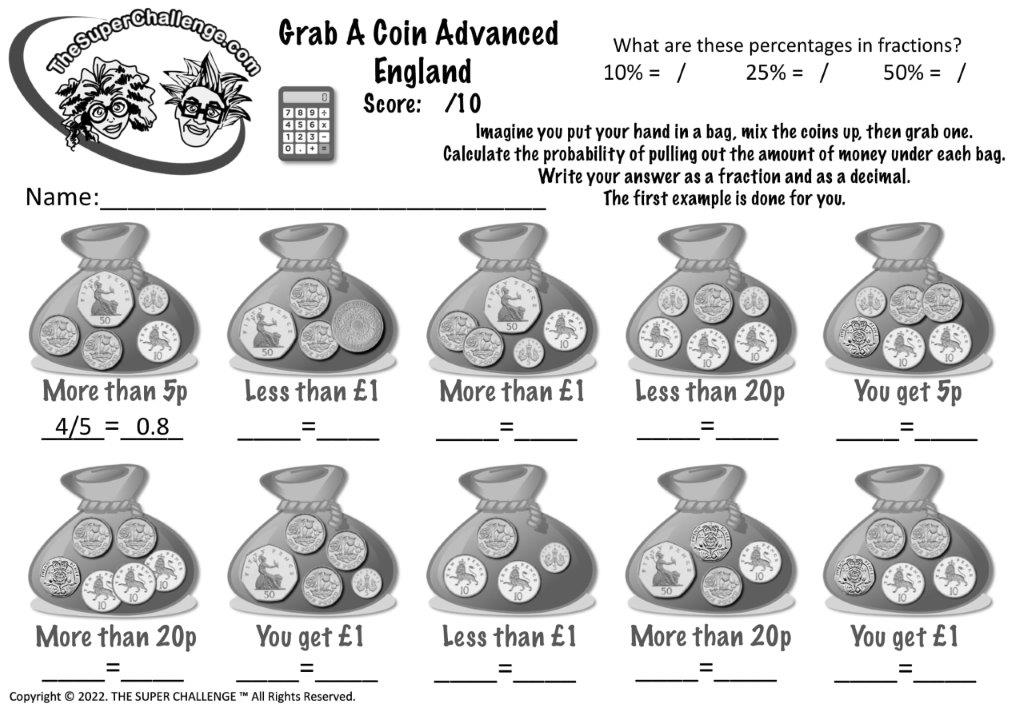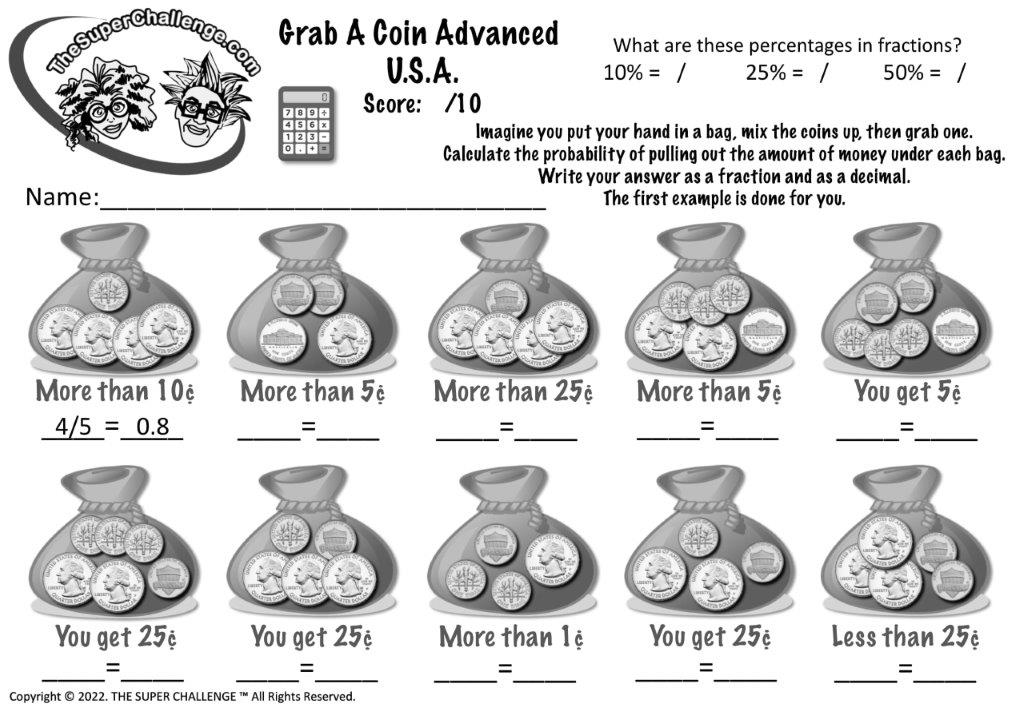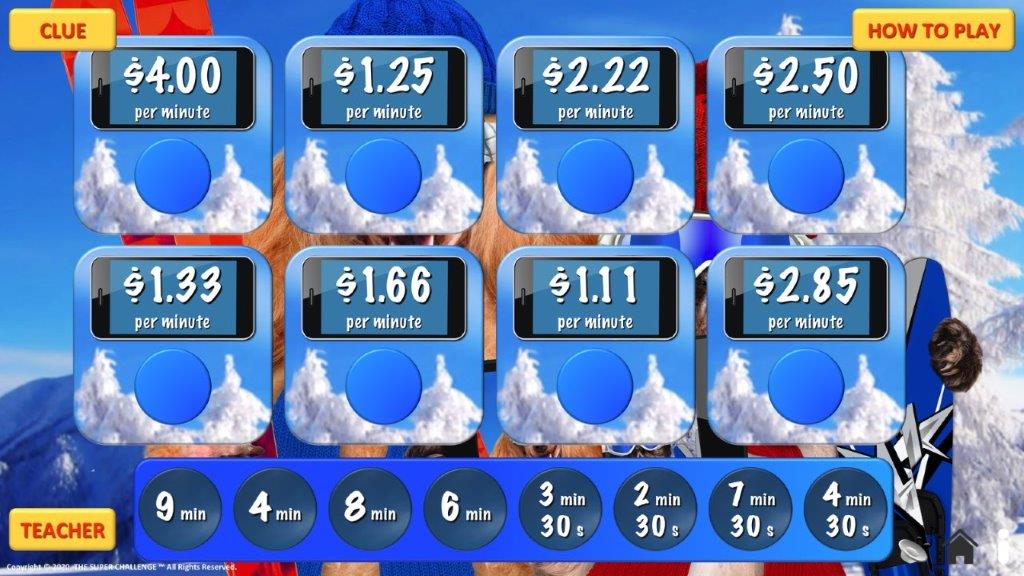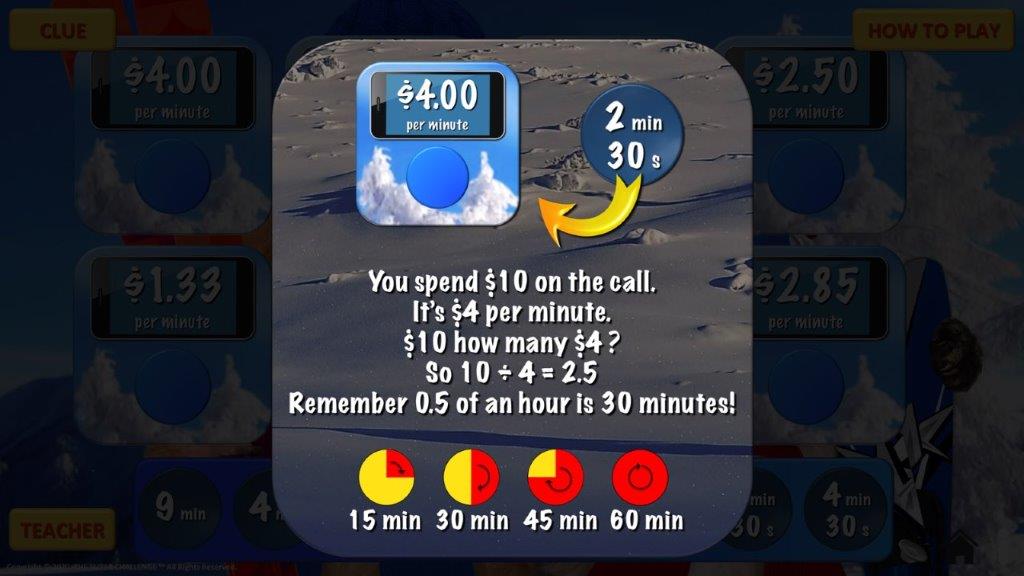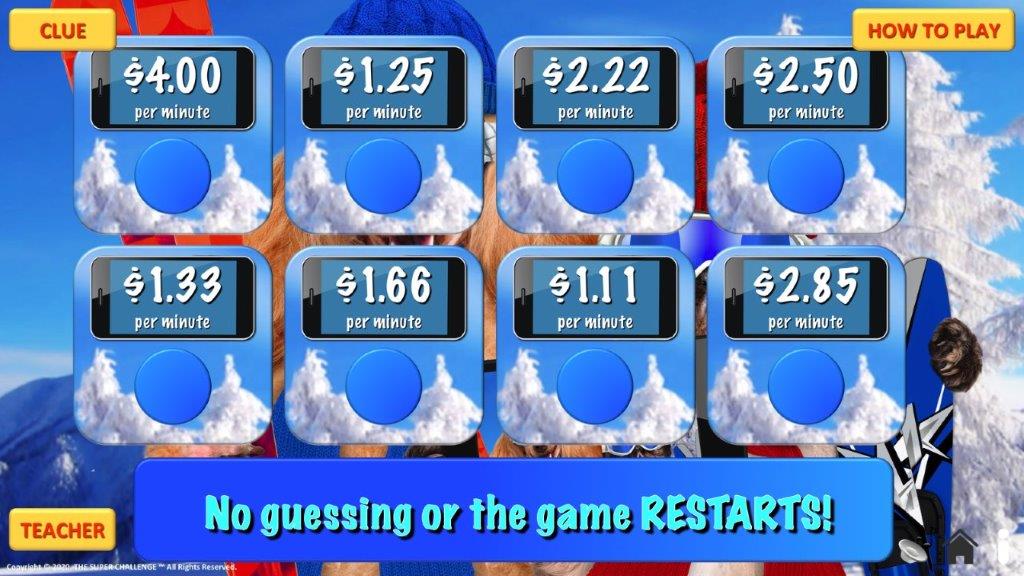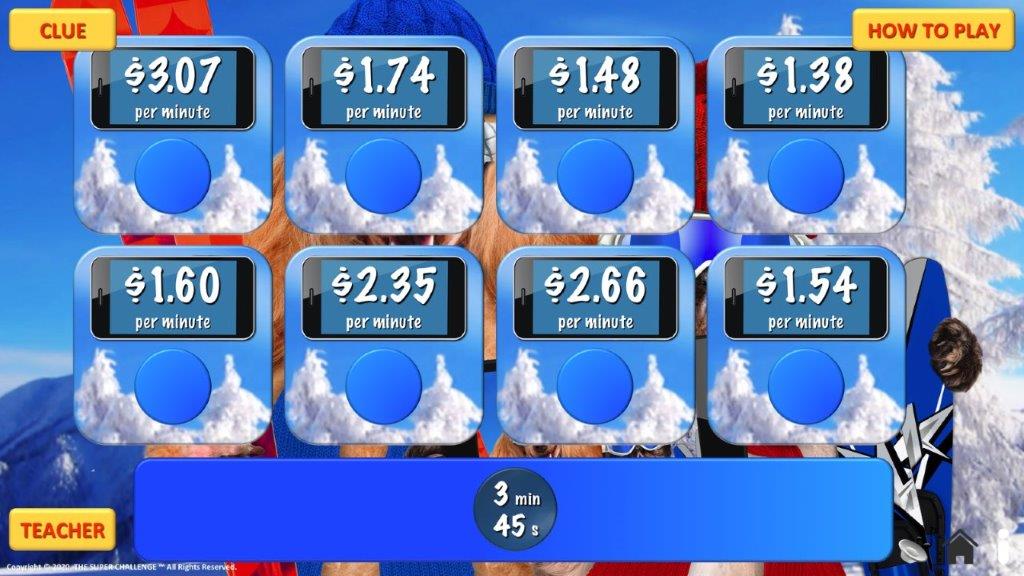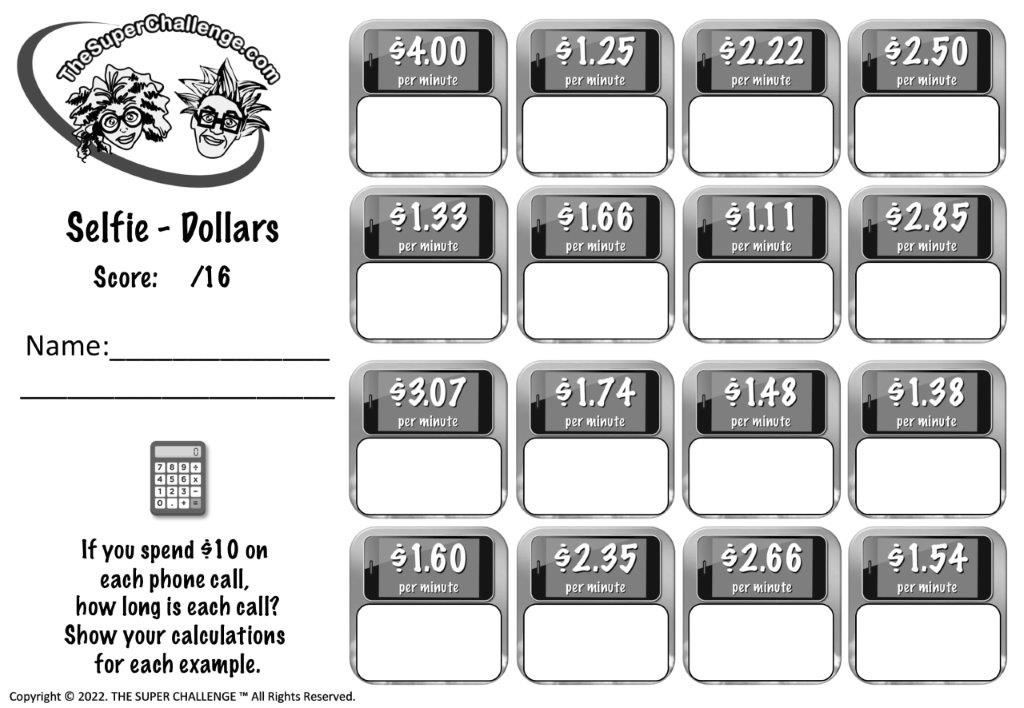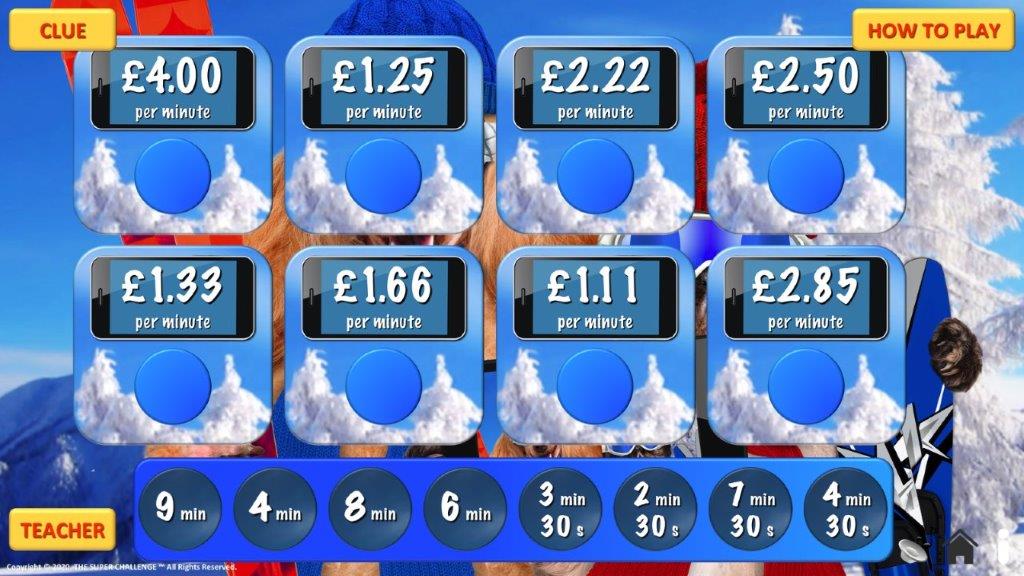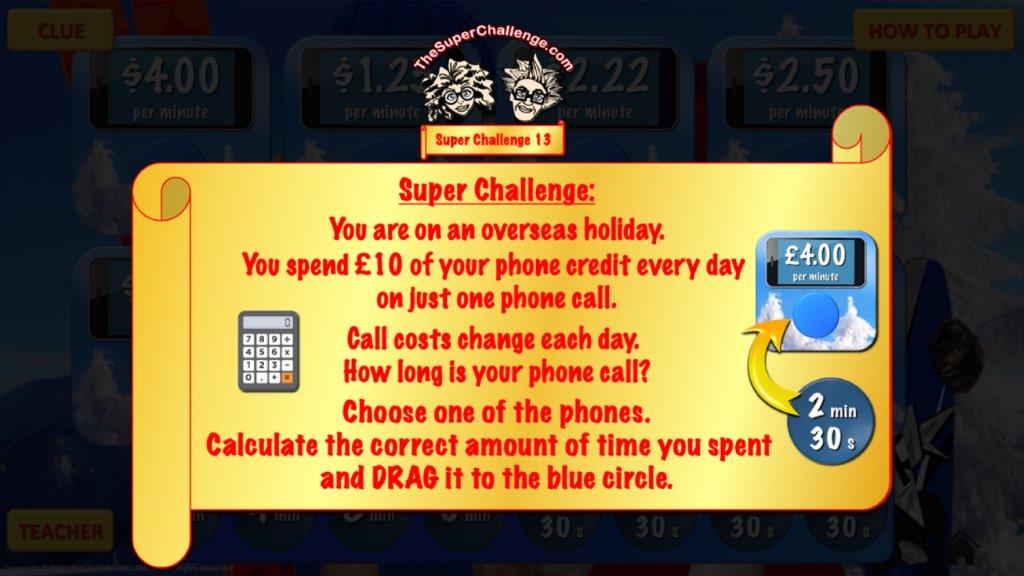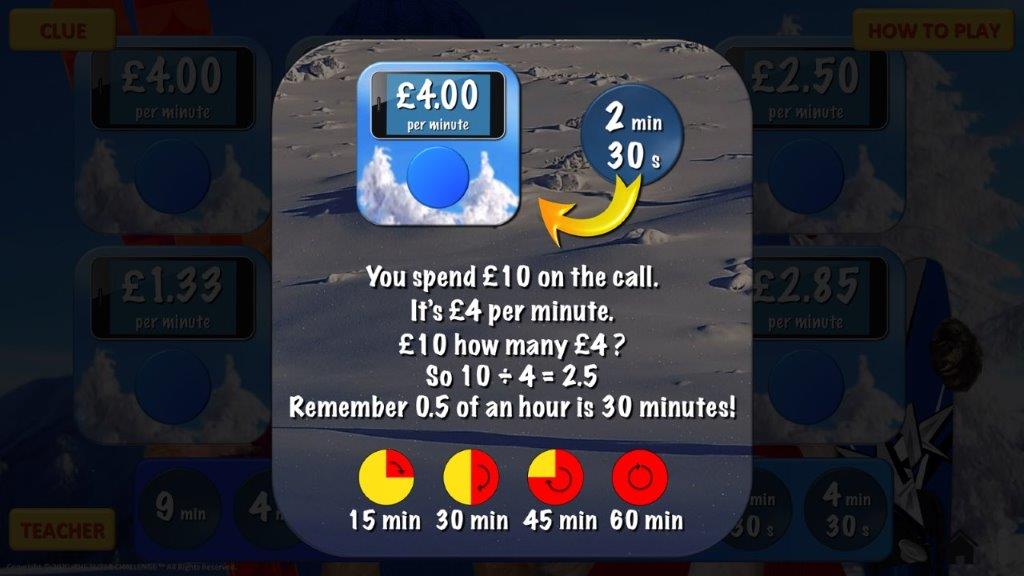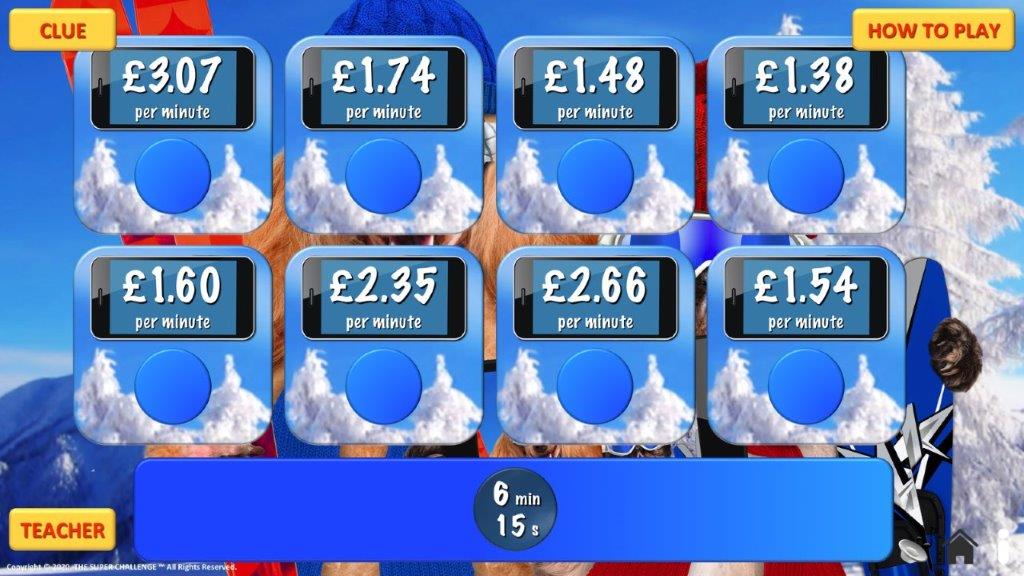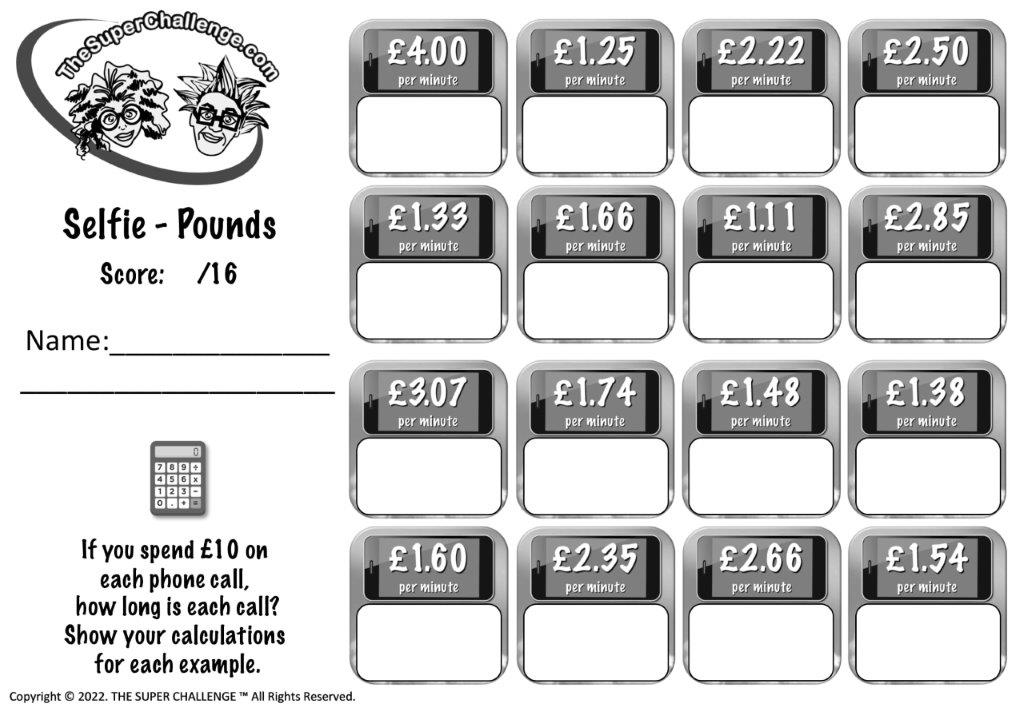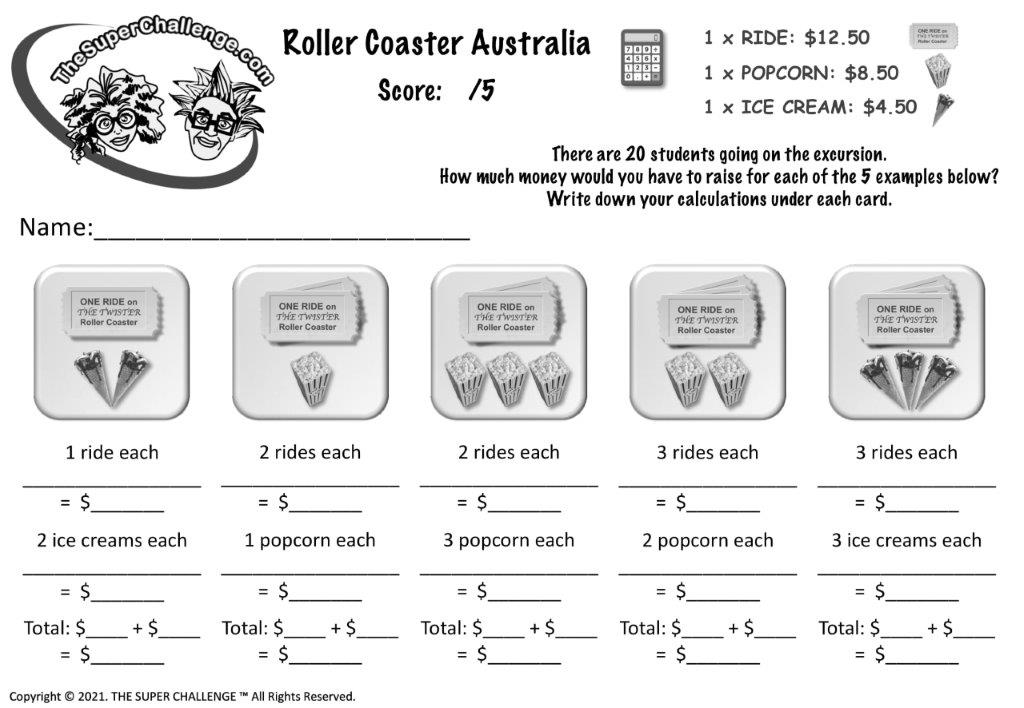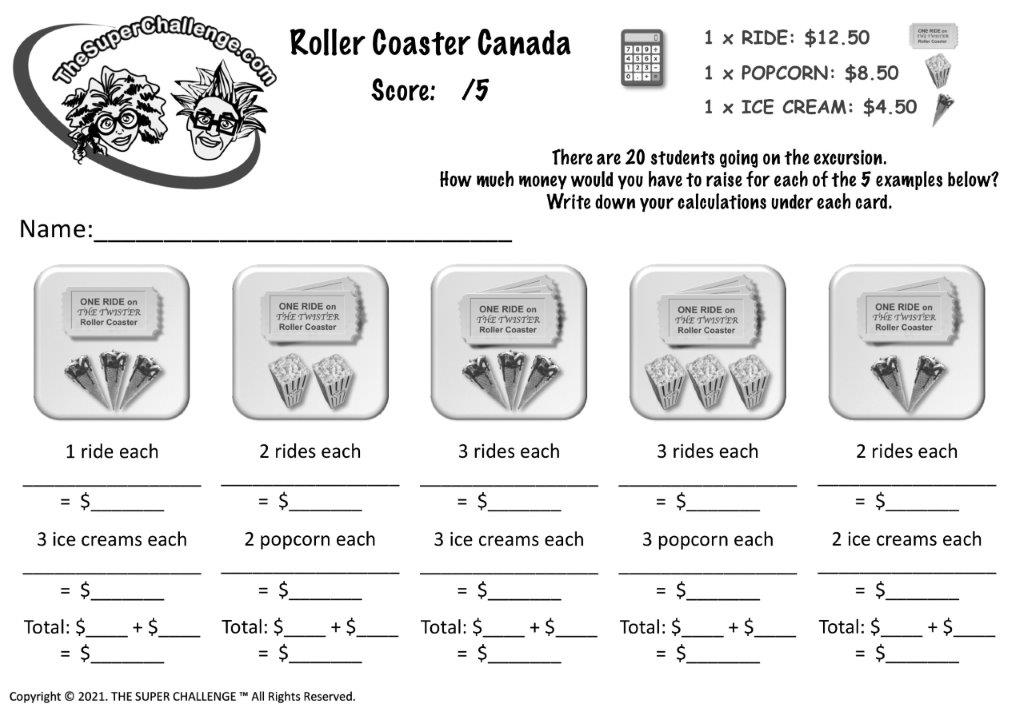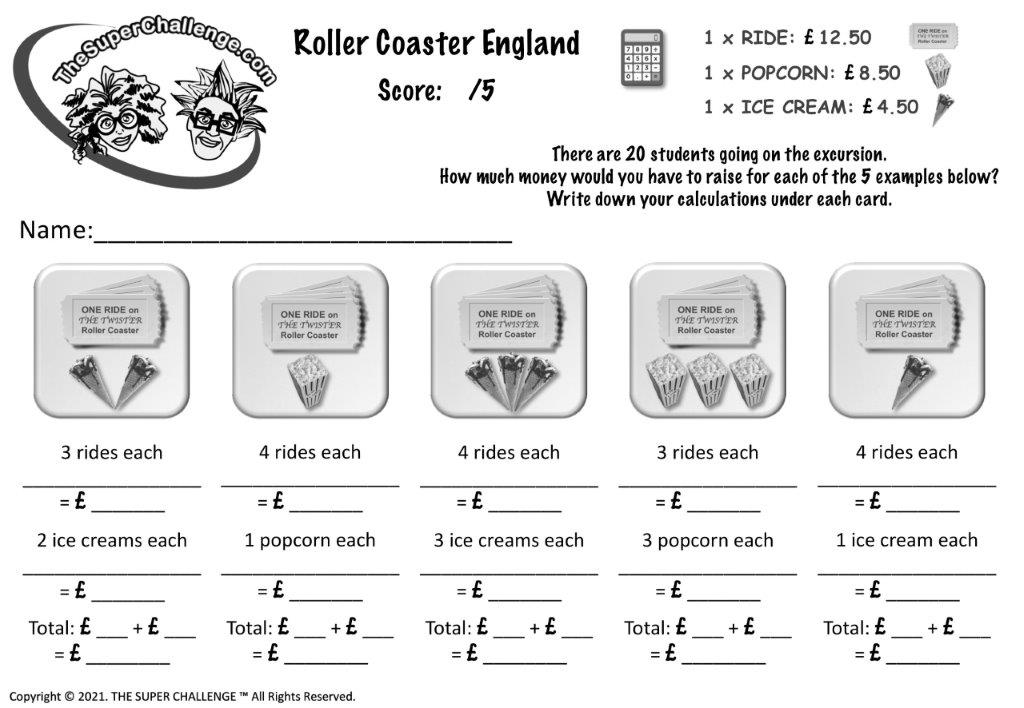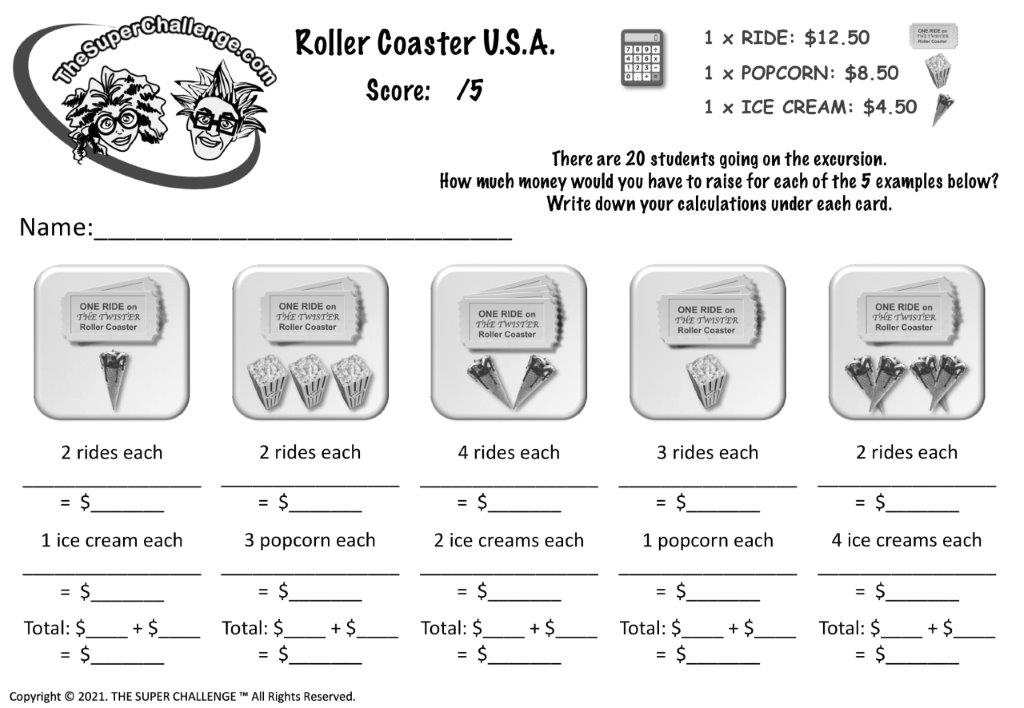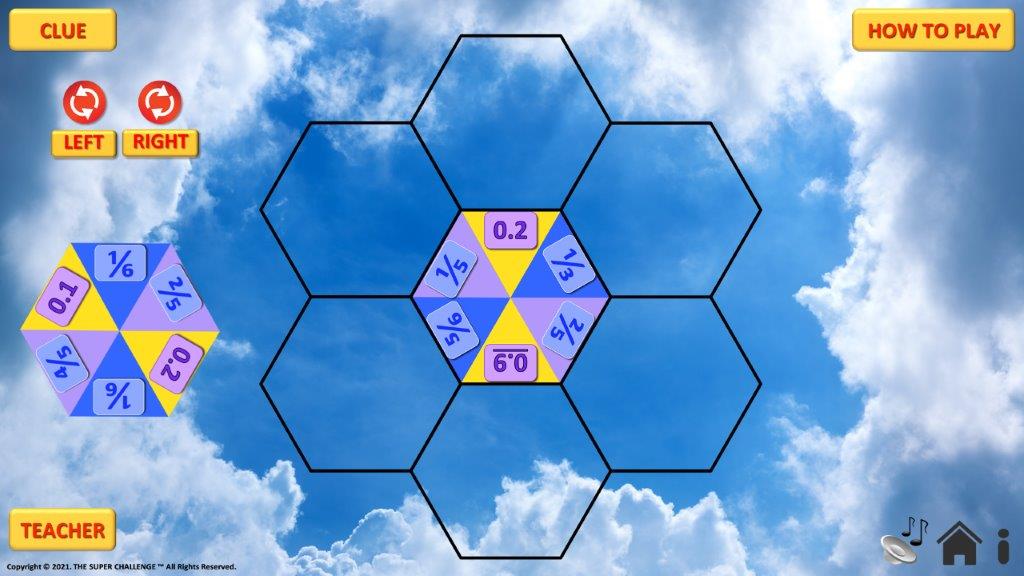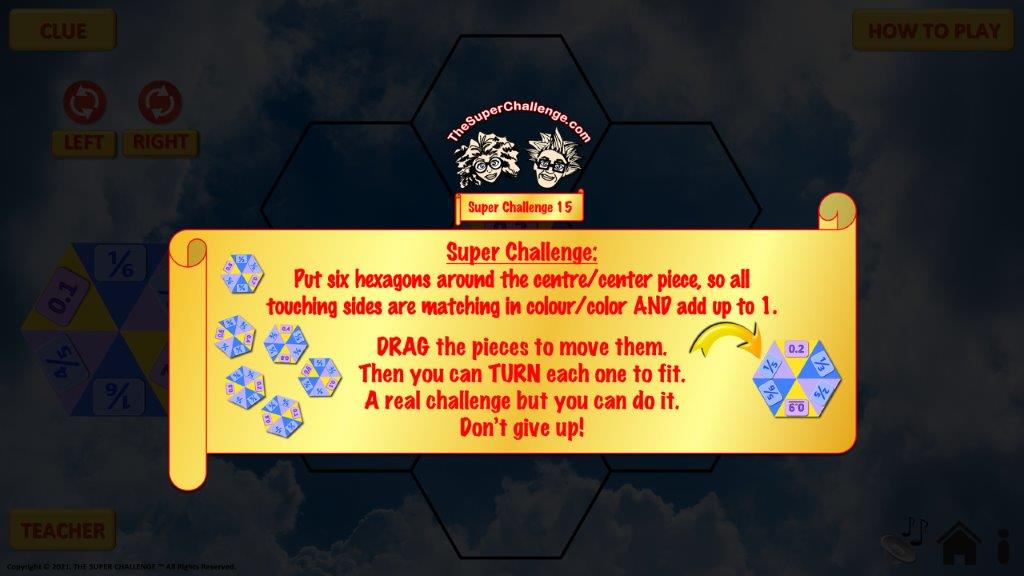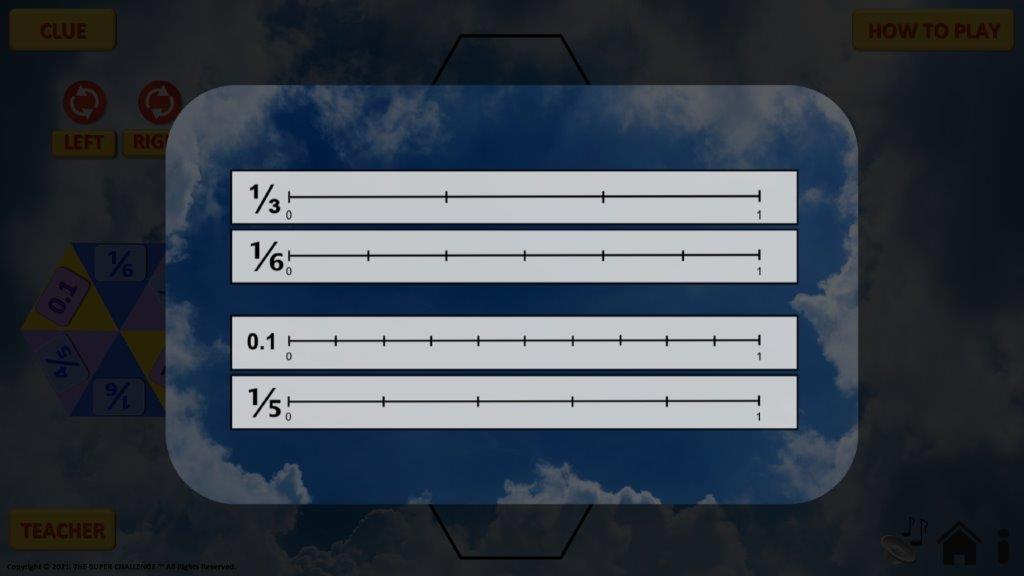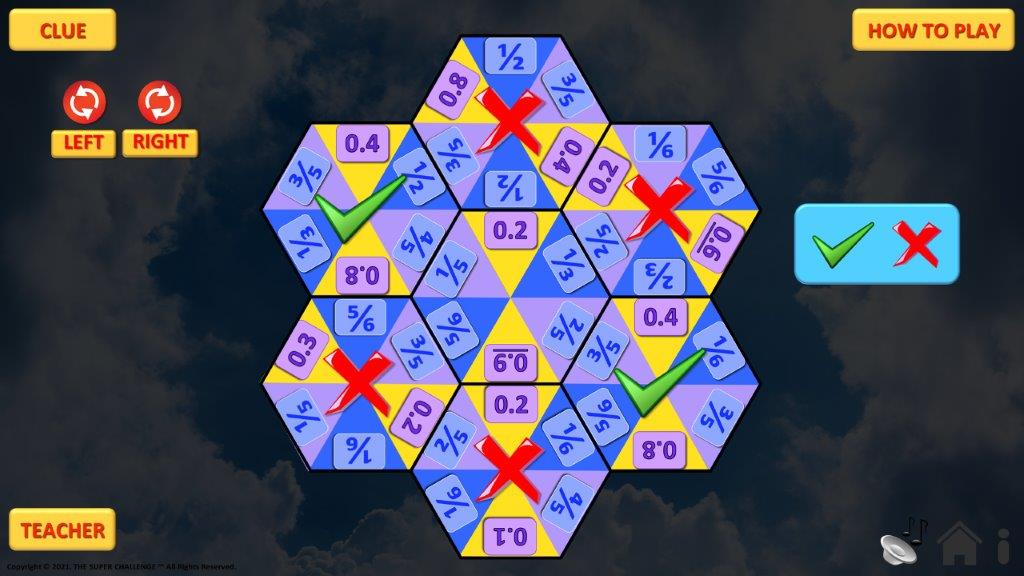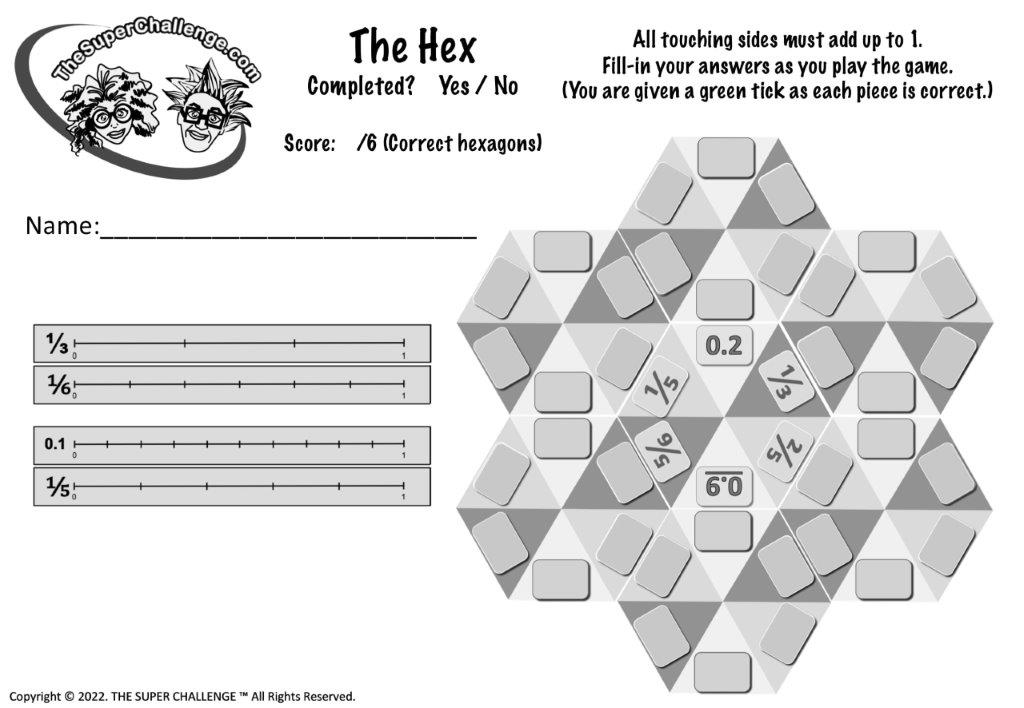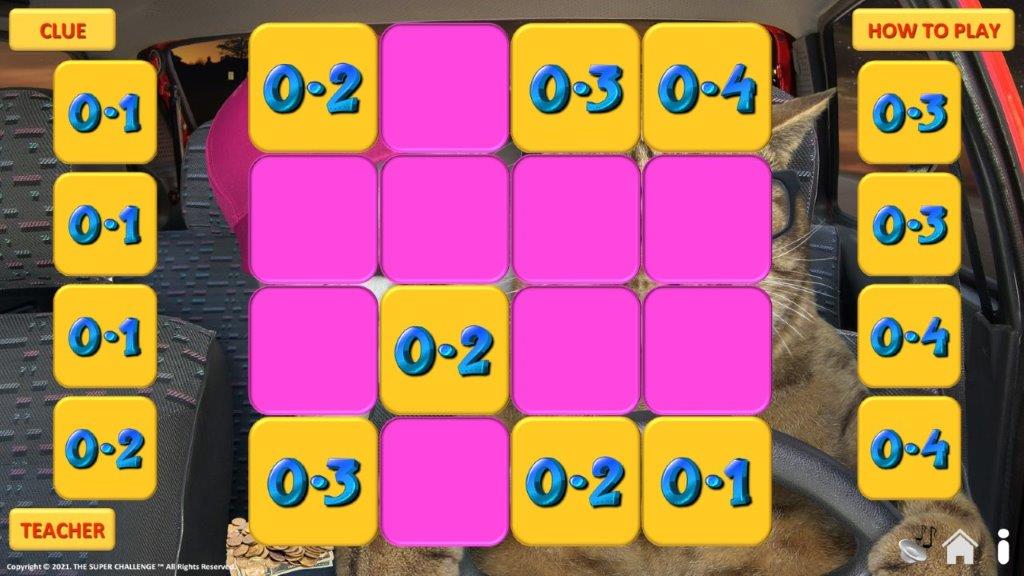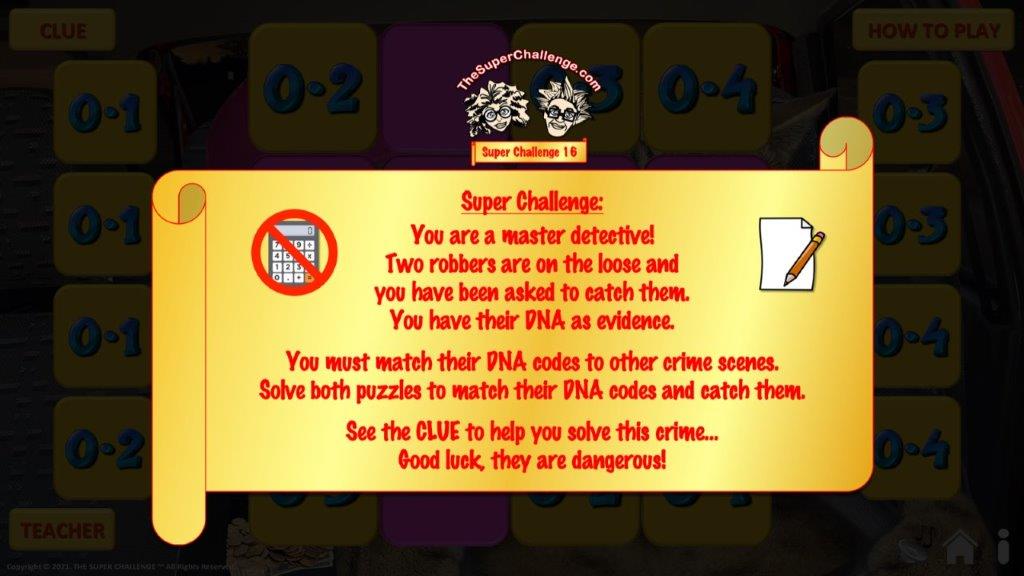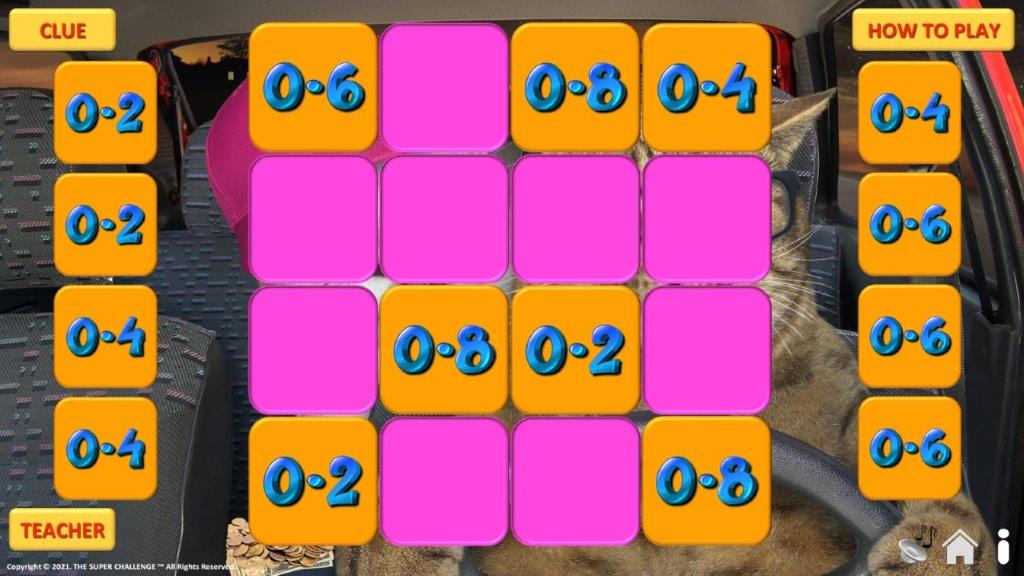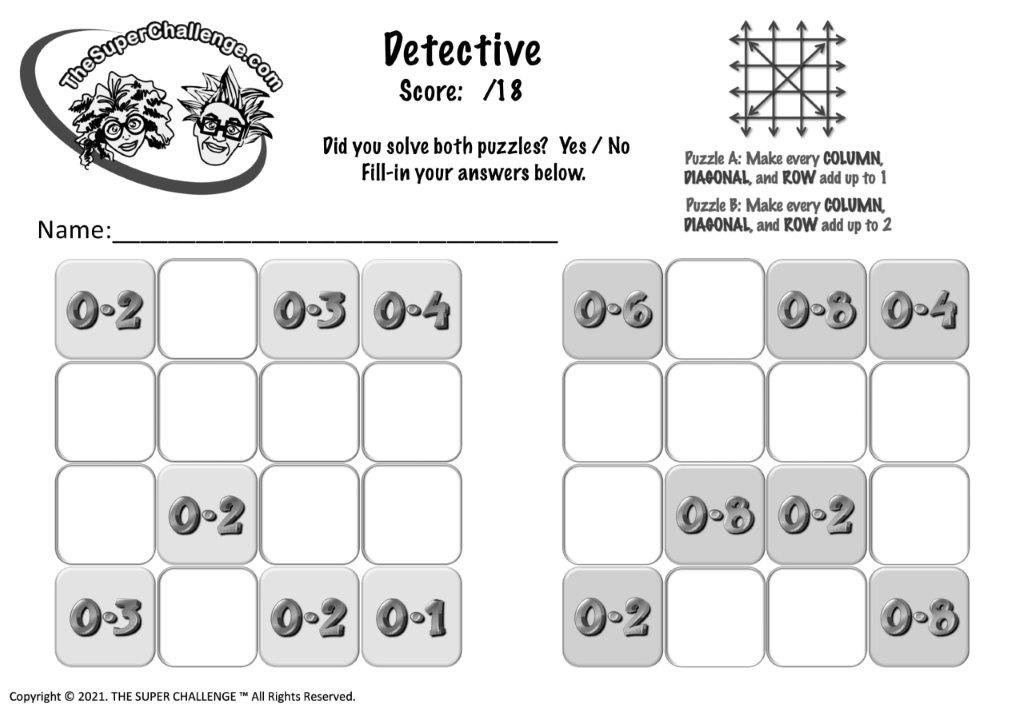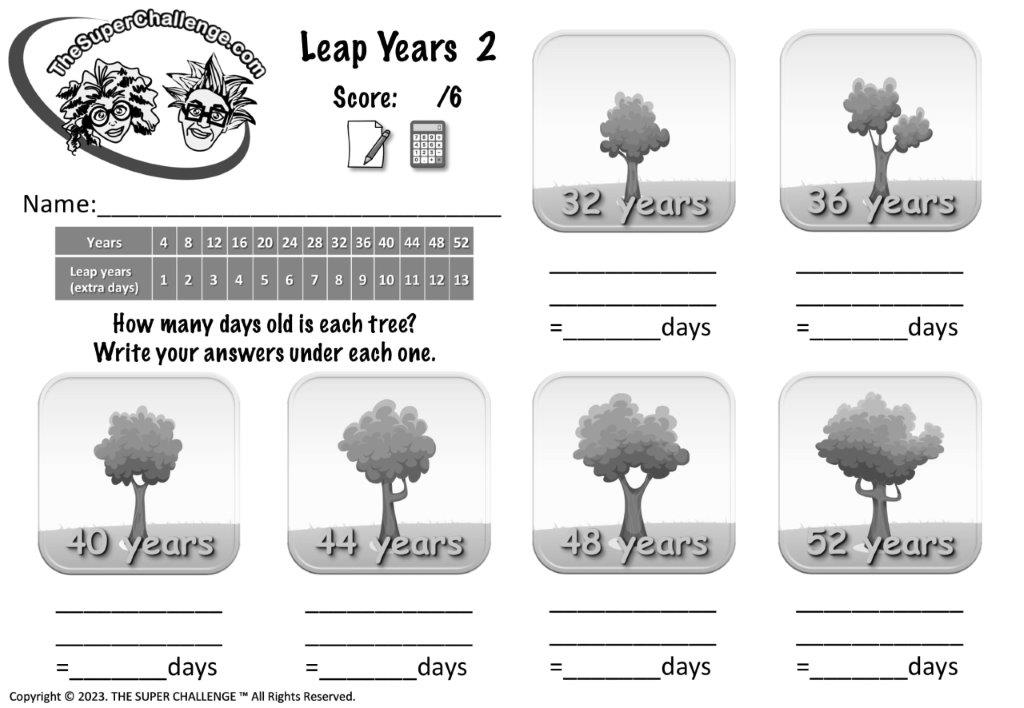YOUR SUPER CHALLENGE:
Your challenge is to complete any 5 games from YOUR grade level. You may do any combination of Mid-level or Advanced level games as long as they are of YOUR grade. A game is only completed when you finish all the questions in the game. You may try some games first to see which ones you would like to play. For games that have different versions, (Standard/Advanced, Money, Metric/Imperial etc), you only need to complete one of the versions. If you do other versions of the same game, it is still counted as only one game.
If you shut the game down, you will have to play from the start again. But if you write down your answers on the worksheet as you play, you can catch up to where you left the game. (The worksheet is optional.)
Once you have fully finished 5 different games, you have completed your challenge and may download your Certificate of Congratulations! But don’t stop there, challenge YOURSELF to see how many more games you can complete!
PARENTS & TUTORS:
The “Advanced Level” games are set at a level students aim to be at by the END of their school year. Also, games are not designed to be played on Safari browsers and may not load. All games may be played on PC’s & laptops; however, some may also be played on tablets, see the listing under each game name.
Warning: Games are not designed to be played using the Safari browsers.
Games should only be played using a web browser such as Chrome, Firefox or Microsoft Edge.
Please open this website using one of these browsers.
It is also advised you have the latest version of the Chrome, Firefox or Microsoft Edge web browsers.
Grade 5 – 6 Explained

SPACE SHUTTLE – STANDARD
GAME PLAYS ON: PC & LAPTOP ONLY
Space Shuttle – Standard - Game Description
Ages: 10 – 11 years old
Suits: Grade 5 students in Australia, Fifth Grade students in the U.S.A. & Canada and Year 6 students in England.
Understanding reflections and rotations of two-dimensional shapes and identifying line and rotational symmetries.
This is an educational mathematics game helping students to understand reflection and rotation. The game is set on the space shuttle while it is orbiting Earth. This is a very exciting and engaging game to play! It is full of space shuttle and outer space sound effects. It has simple and easy to understand examples of refection and clockwise & anticlockwise rotation. It is lots of fun and becomes more and more challenging as it is played.
Designed to suit the Mathematics Curriculums of Australia, Canada, England, and the U.S.A.
Teacher Reference:
(ACMMG114): Describe reflections and rotations of two-dimensional shapes. Identify line and rotational symmetries. (For translations, see the game called TORNADO – Grade 6.)
Ref: Australian Curriculum Mathematics.
How To Play:
You are the pilot of the space shuttle. You have a map and need to follow directions to land. Click on any of the directions. Choose the correct answer, see the CLUE. If you use a pencil and paper, it will help. No guessing! You must get the answer correct on your first or second try, otherwise the GAME STARTS AGAIN! It’s a challenge but you can do it!
Space Shuttle – Standard - Learning Outcomes
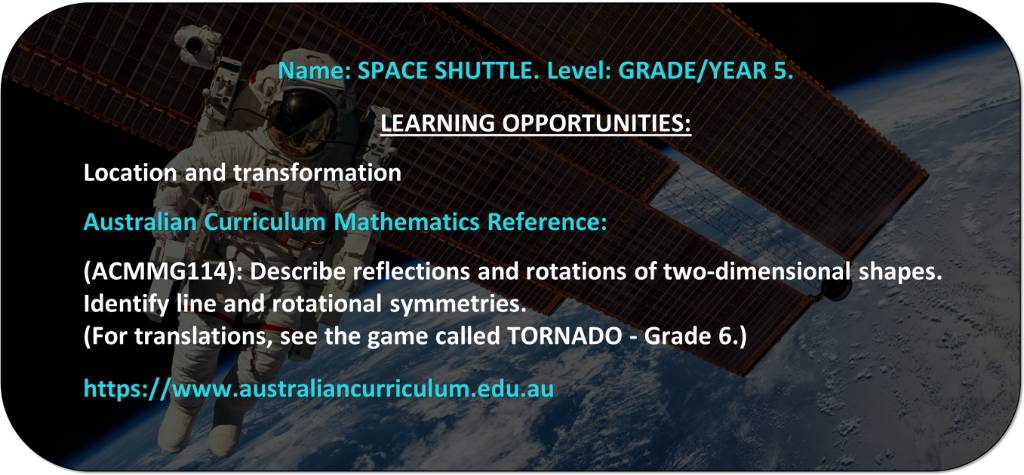
Space Shuttle – Standard - Worksheet
SPACE SHUTTLE – ADVANCED
GAME PLAYS ON: PC & LAPTOP ONLY
Space Shuttle – Advanced - Game Description
Ages: 10 – 11 years old
Suits: Grade 5 students in Australia, Fifth Grade students in the U.S.A. & Canada and Year 6 students in England.
More complex reflections and rotations of two-dimensional shapes and line and rotational symmetries.
This is the more challenging game of the reflection and rotation games for this level. The game is set on the space shuttle while it is orbiting Earth. This is a very exciting and engaging game to play! It is full of space shuttle and outer space sound effects. It has simple and easy to understand examples of refection and clockwise & anticlockwise rotation. It is lots of fun and becomes more and more challenging as it is played.
The game is used by teachers as a good gauge on how well a student grasps these concepts. Designed to suit the Mathematics Curriculums of Australia, Canada, England, and the U.S.A.
Teacher Reference:
(ACMMG114): Describe reflections and rotations of two-dimensional shapes. Identify line and rotational symmetries. (For translations, see the game called TORNADO – Grade 6.)
Ref: Australian Curriculum Mathematics.
How To Play:
You are now an experienced pilot on the space shuttle. You have been promoted to commander and are following directions to land. Click on any of the directions and choose the correct answer. If you use a pencil and paper, it will help! You must get the answer correct on your first or second try, otherwise, the shuttle may crash, and the GAME WILL START AGAIN!
Space Shuttle – Advanced - Learning Outcomes
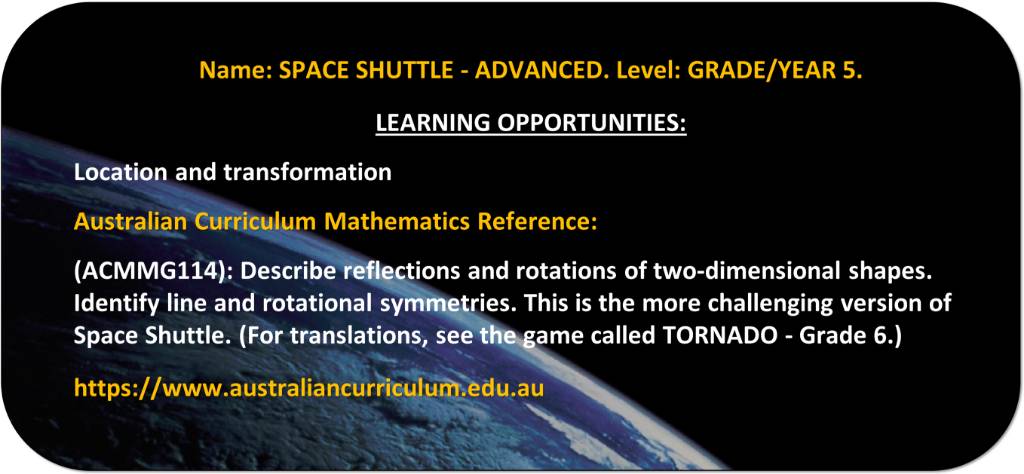
Space Shuttle – Advanced - Worksheet
LUCKY CHARM – STANDARD
GAME PLAYS ON: PC, LAPTOP & TABLET
Lucky Charm – Standard - Game Description
Ages: 10 – 11 years old
Suits: Grade 5 students in Australia, Fifth Grade students in the U.S.A. & Canada and Year 6 students in England.
Learning how to solve problems involving addition and subtraction of fractions with the same denominator. This game includes the fractions of quarters and eighths.
This game helps students learn to add and subtract fractions. When first played, this can be a challenging game for students. However, once they play this game a few times, they very quickly grasp this concept.
Set in Egypt with sounds of spells and mummies, it is a very engaging and fun game to play. Students will often play this game over and over cementing their understanding of addition with fractions. The game is designed to suit the Mathematics Curriculums of Australia, Canada, England, and the U.S.A.
Teacher References:
(ACMNA103): Solve problems involving addition and subtraction of fractions with the same denominator.
(ACMNA102): Compare and order common unit fractions and locate and represent them on a number line. Identifying the connection between the order of unit fractions and their denominators.
Ref: Australian Curriculum Mathematics.
How To Play:
You are visiting the pyramids and have found something in the sand. It looks like a lucky charm, but it was stolen from an ancient tomb by thieves. As soon as you touched it, a curse was placed upon you! Now, the tomb guards want the charm back! You need to complete the puzzle to lift the curse. Put numbers into the grid so every line will add up to one and one-half. See the clue if you need help. Good luck!
Lucky Charm – Standard - Learning Outcomes
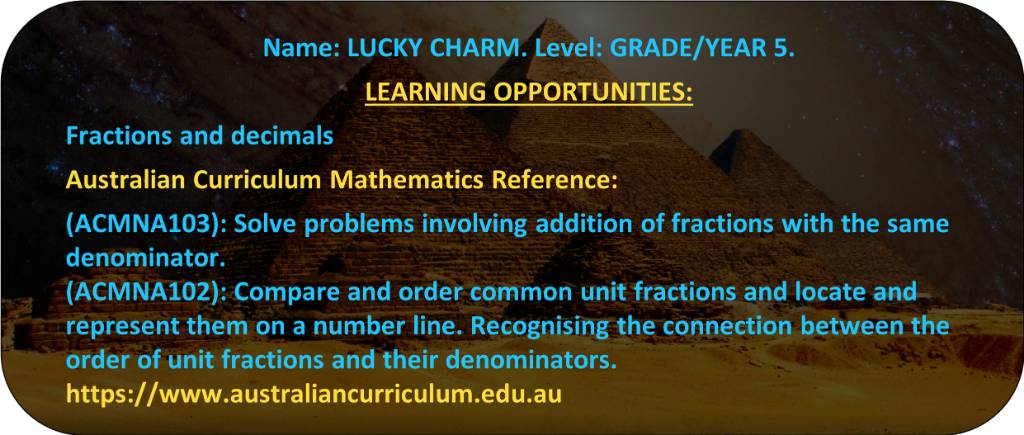
Lucky Charm – Standard - Worksheet
LUCKY CHARM – ADVANCED
GAME PLAYS ON: PC, LAPTOP & TABLET
Lucky Charm – Advanced - Game Description
Ages: 10 – 11 years old
Suits: Grade 5 students in Australia, Fifth Grade students in the U.S.A. & Canada and Year 6 students in England.
Solving more complex problems involving addition and subtraction of fractions with the same denominators.
This game helps students learn to add and subtract fractions. It is the slightly more challenging version of the Luck Charm Standard game. It includes the fractions of halves, quarters, fifths, and eighths and introduces equivalent fractions.
Set in Egypt with sounds of spells and mummies, it is a very engaging and fun game to play. Students will often play this game over and over cementing their understanding of addition with fractions. The game is designed to suit the Mathematics Curriculums of Australia, Canada, England, and the U.S.A.
Teacher References:
(ACMNA103): Solve problems involving addition and subtraction of fractions with the same denominator.
(ACMNA102): Compare and order common unit fractions and locate and represent them on a number line. Identifying the connection between the order of unit fractions and their denominators.
Ref: Australian Curriculum Mathematics.
How To Play:
You have completed the first challenge and lifted the curse.
Now you must complete this next challenge to please the tomb guards, so no curse can ever be placed on you again. Part A: Put numbers into the grid so every line will add up to 1½. Part B: Put numbers into the grid so every line will add up to 3. Once you complete this challenge, the tomb guards will be happy, and all curses will be lifted! Good luck!
Lucky Charm – Advanced - Learning Outcomes
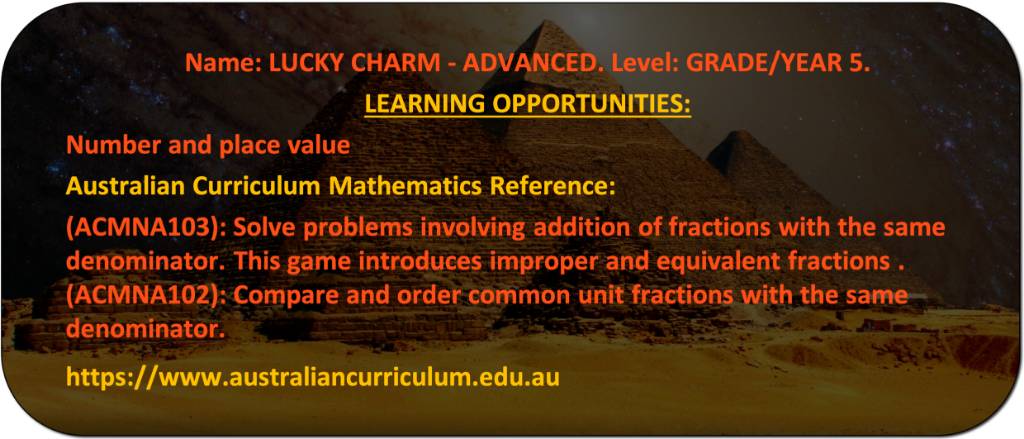
Lucky Charm – Advanced - Worksheet
LIGHTHOUSE
GAME PLAYS ON: PC & LAPTOP ONLY
Lighthouse - Game Description
Ages: 10 – 11 years old
Suits: Grade 5 students in Australia, Fifth Grade students in the U.S.A. & Canada and Year 6 students in England.
Understanding number patterns and sequences. Describe, continue, and create patterns with whole numbers resulting from addition and subtraction.
Helping students learn about and understand number patterns. It is an excellent introduction for students to learn that numbers can come in patterns and sequences. The game is very engaging for both students and teachers.
Students must move lighthouses from a starting point to a finish point. Lighthouses then come in 2, 3 and 4 pieces. The game becomes more and more challenging as it’s played. Students are then asked to find the number pattern resulting from; number of pieces vs the number of moves needed. The game is filled with stormy sound effects and is lots of fun to play. It is designed to suit the Mathematics Curriculums of Australia, Canada, England and the U.S.A.
Teacher Reference:
(ACMNA107): Describe, continue, and create patterns with whole numbers resulting from addition and subtraction.
Ref: Australian Curriculum Mathematics.
How To Play:
Can you move each lighthouse from the START to the FINISH?
Move the top piece to any other position. Keep moving pieces until the lighthouse is remade at the FINISH. What is the least amount of moves it takes to get each lighthouse from the START to the FINISH? Can you find a NUMBER PATTERN? Use the NUMBER PATTERN to find the answers to 5, 6 & 7 on the table.
It’s a super challenge, but you can do it!
Lighthouse - Learning Outcomes

Lighthouse - Worksheet
NETS AND SHAPES
GAME PLAYS ON: PC & LAPTOP ONLY
Nets and Shapes - Game Description
Ages: 10 – 11 years old
Suits: Grade 5 students in Australia, Fifth Grade students in the U.S.A. & Canada and Year 6 students in England.
Connecting nets to three-dimensional objects.
This mathematics game helps students learn about nets of three-dimensional objects. It is an excellent introduction of “nets’ for students.
This game is also culturally educational as it is set in Egypt with Middle Eastern sound effects and music. The game is lots of fun and becomes more and more challenging as it is played. It is also a good gauge for teachers to see how well a student grasps the concept. Designed to suit the Mathematics Curriculums of Australia, Canada, England and the U.S.A.
Teacher Reference:
(ACMMG111): Connect three-dimensional objects with their nets and other two-dimensional representations.
Ref: Australian Curriculum Mathematics.
How To Play:
You are traveling by night through Egypt on a camel. You stop in amazement at the pyramids and wonder, how did they make them? They knew all about shapes and nets! Do you know your 3D shapes? Test yourself. Click on a SHAPE. Choose the correct NET. (A NET can be folded to make a 3D shape.) Then DRAG it to the SHAPE to see if you are correct. Are you ready for the adventure to Egypt?
Nets and Shapes - Learning Outcomes

Nets and Shapes - Worksheet
SOUTH POLE – STANDARD
GAME PLAYS ON: PC & LAPTOP ONLY
South Pole – Standard - Game Description
Ages: 10 – 11 years old
Suits: Grade 5 students in Australia, Fifth Grade students in the U.S.A. & Canada and Year 6 students in England.
Convert between 12- and 24-hour time systems.
This mathematics game helps students understand the 12- and 24-hour time systems. Using the rotation of the Earth as the example, this is an excellent way for students to understand the 24-hour system. The game makes it easy for students to grasp the concept and to convert from 12- to 24-hour systems. It also has a double benefit as it helps student understand angles and rotation. The game is very engaging and includes sound effects of outer space. It is lots of fun and becomes more and more challenging as it is played.
This is the first and easier game of two, time system games for this level. The more challenging version is called, South Pole – Advanced. It is designed to suit the Mathematics Curriculums of Australia, Canada, England, and the U.S.A.
Teacher Reference:
(ACMMG110): Compare 12- and 24-hour time systems and convert between them.
Ref: Australian Curriculum Mathematics.
How To Play:
You are an astronaut returning to Earth. You need to know what time it is at the South Pole. Click on an ANGLE. Calculate what time it is, (see the CLUE). Then drag your answer to the ANGLE above. No guessing! You must get the answer correct on your first or second try, otherwise, the GAME STARTS AGAIN! It’s a super challenge, but you can do it!
South Pole – Standard - Learning Outcomes
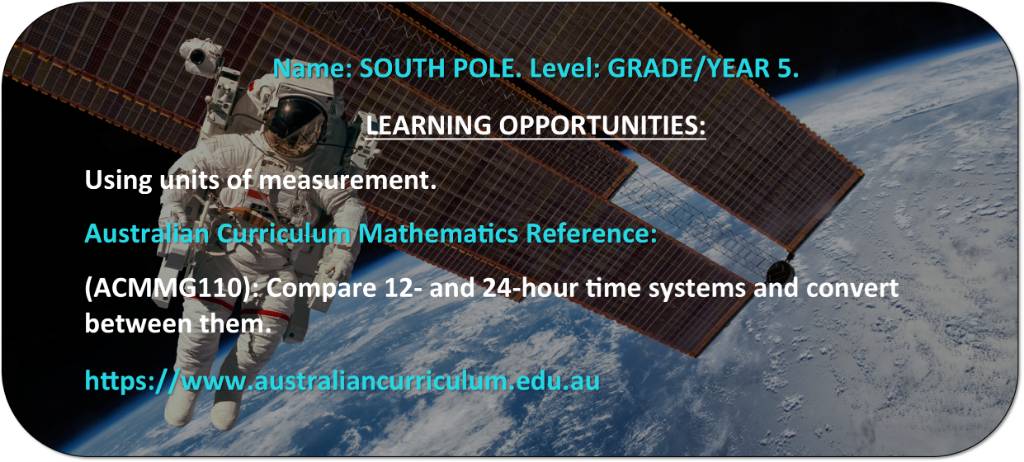
South Pole – Standard - Worksheet
SOUTH POLE – ADVANCED
GAME PLAYS ON: PC & LAPTOP ONLY
South Pole – Advanced - Game Description
Ages: 10 – 11 years old
Suits: Grade 5 students in Australia, Fifth Grade students in the U.S.A. & Canada and Year 6 students in England.
More detailed 12- and 24-hour time system conversion.
This is an advanced level game helping students to fully understand the 12- and 24-hour time systems. This is the second and more detailed game of two, time-system games for this level. Using the rotation of the Earth as the example, this is an excellent way for students to fully grasp the 24-hour system.
It also has a double benefit as it helps students to understand angles and rotation. The game is very engaging and includes sound effects of outer space. It is lots of fun and becomes more and more challenging as it is played. Designed to suit the Mathematics Curriculums of Australia, Canada, England, and the U.S.A.
Teacher Reference:
(ACMMG110): Compare 12- and 24-hour time systems and convert between them, (advanced level). This game is a good gauge for teachers to see if a student fully understands time conversion.
Ref: Australian Curriculum Mathematics.
How To Play:
You are an astronaut floating above the South Pole. You need to know what time it is there. But your instruments only show the earth’s rotation. Can you calculate what time it is at the South Pole? Click on an ANGLE. Calculate what time it is, (see the CLUE). Then drag your answer to the ANGLE above. Are you ready for the challenge? You can do it!
South Pole – Advanced - Learning Outcomes

South Pole – Advanced - Worksheet
AVERAGE RAINFALL – METRIC
GAME PLAYS ON: PC & LAPTOP ONLY
Average Rainfall – Metric - Game Description
Ages: 10 – 11 years old
Suits: Grade 5 students in Australia & Canada.
Learning how to solve problems involving division with a calculator, using metric units of measurement.
This game helps students learn to solve problems involving division including those that result in a remainder. Students must work out the average daily rainfall for each month of the year. They must also construct an appropriate column graph.
The game is filled with stormy sound effects and is an exciting and fun game to play. It also has positive and encouraging voice-overs to help build student confidence with mathematics. Students are encouraged to do calculations in both metric and imperial to learn that countries use different measurement systems. For this reason, students should also play the imperial version. This game suits the Mathematics Curriculums of Australia & Canada as it uses the metric system.
Teacher References:
(ACMNA101): Solve problems involving division, including those that result in a remainder.
(ACMNA291): Use efficient mental and written strategies and apply appropriate digital technologies to solve problems.
(ACMSP119): Construct displays, including column graphs appropriate for data type, with and without the use of digital technologies.
Ref: Australian Curriculum Mathematics.
How To Play:
To measure rainfall, we use a rain gauge. Your school has one and records MONTHLY rainfall measurements. Here is your challenge: You must work out the AVERAGE DAILY rainfall for each month. Can you write down in numbers, how you did one of them? Draw a COLUMN GRAPH of the average daily rainfall. (See the worksheet.)
Average Rainfall – Metric - Learning Outcomes
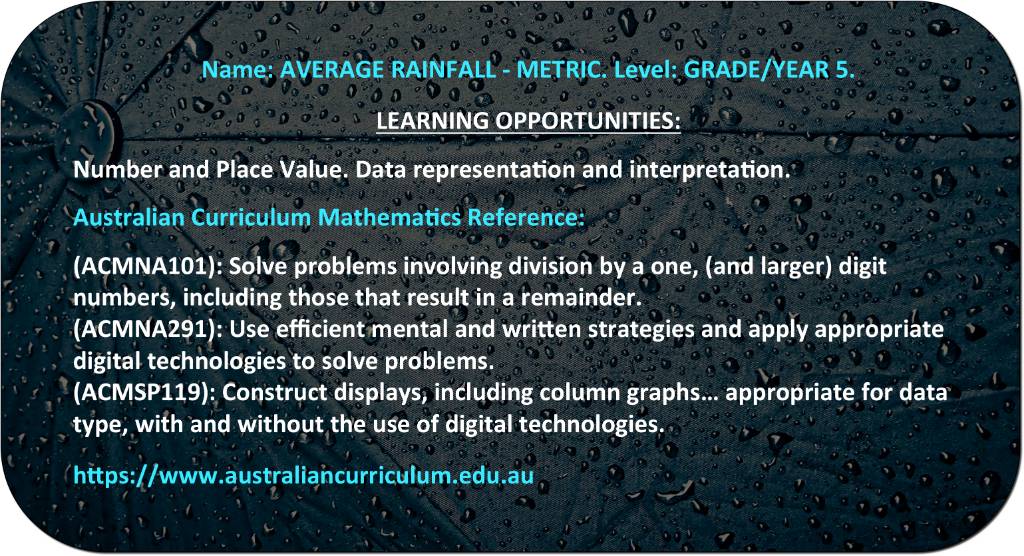
Average Rainfall – Metric - Worksheet
AVERAGE RAINFALL – IMPERIAL
GAME PLAYS ON: PC & LAPTOP ONLY
Average Rainfall – Imperial - Game Description
Ages: 10 – 11 years old
Suits: Fifth Grade students in the U.S.A. and Year 6 students in England.
Learning how to solve problems involving division with a calculator, using imperial units of measurement.
This game helps students learn to solve problems involving division including those that result in a remainder. Students must work out the average daily rainfall for each month of the year. They must also construct an appropriate column graph.
The game is filled with stormy sound effects and is an exciting and fun game to play. It also has positive and encouraging voice-overs to help build student confidence with mathematics. Students are encouraged to do calculations in both metric and imperial to learn that countries use different measurement systems. For this reason, students should also play the metric version. This game suits the Mathematics Curriculums of England and the U.S.A. as it uses the imperial system.
Teacher References:
(ACMNA101): Solve problems involving division, including those that result in a remainder.
(ACMNA291): Use efficient mental and written strategies and apply appropriate digital technologies to solve problems.
(ACMSP119): Construct displays, including column graphs appropriate for data type, with and without the use of digital technologies.
Ref: Australian Curriculum Mathematics.
How To Play:
To measure rainfall, we use a rain gauge. Your school has one and records MONTHLY rainfall measurements. Here is your challenge: You must work out the AVERAGE DAILY rainfall for each month. Click on one of the MONTHS. Calculate the AVERAGE DAILY RAINFALL for that month. Extra challenge: Can you write down in numbers, how you did one of them? Draw a COLUMN GRAPH of the average daily rainfall. (See the worksheet.)
Average Rainfall – Imperial - Learning Outcomes
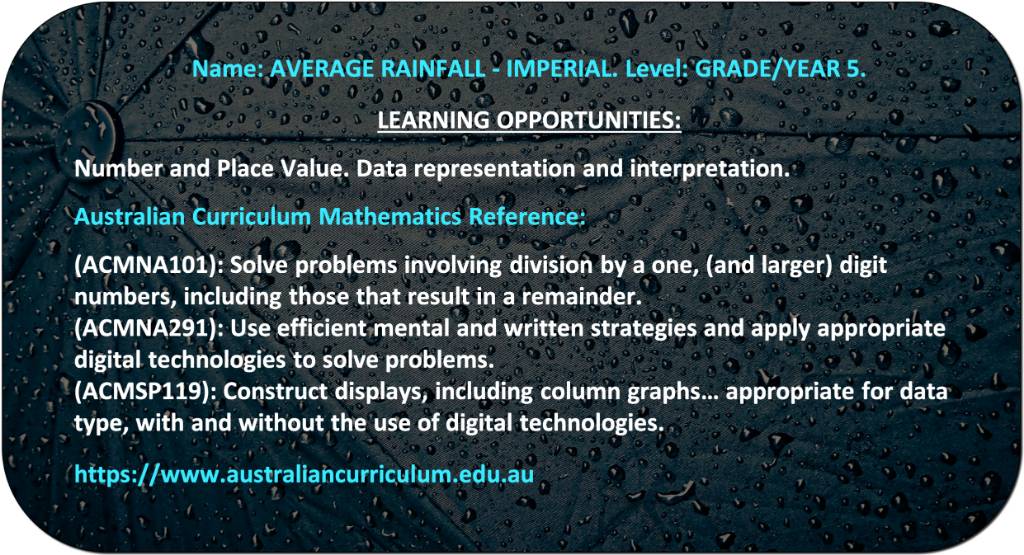
Average Rainfall – Imperial - Worksheet
SKIING METRIC – STANDARD
GAME PLAYS ON: PC, LAPTOP & TABLET
Skiing Metric – Standard - Game Description
Ages: 10 – 11 years old
Suits: Grade 5 students in Australia & Canada.
This game helps students to understand fractions and decimals and how to convert between them. The game is set in the snow with students on a skiing excursion. They must calculate how far each student was able to ski before falling over.
The game is lots of fun to play and is filled with humorous sound effects. It is very engaging and a good way for teachers to gauge how well a student grasps fractions and decimals. Students should also play the imperial version of this game to give them a good understanding of different units of measurement. It is designed to suit the Mathematics Curriculums of Australia & Canada as it uses the metric system.
Teacher Reference:
(ACMNA079): Make connections between fractions and decimal notation. Using knowledge of fractions to establish equivalences between fractions and decimal notation.
Ref: Australian Curriculum Mathematics.
How To Play:
You are on a skiing excursion. There is a competition to see who can ski the longest distance, without falling over! The track is 100 m long. Medals are awarded at the end of the day! Make sure everyone gets their own medal. Choose a medal and DRAG your answer to the blue circle. You will have to convert decimals into fractions to get the answers. A challenge, but you can do it!
Skiing Metric – Standard - Learning Outcomes
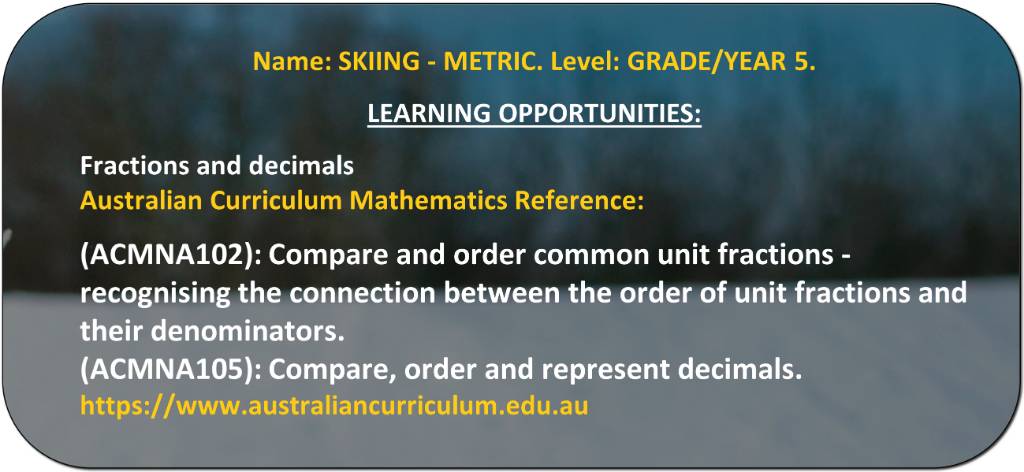
Skiing Metric – Standard - Worksheet
SKIING IMPERIAL – STANDARD
GAME PLAYS ON: PC, LAPTOP & TABLET
Skiing Imperial – Standard - Game Description
Ages: 10 – 11 years old
Suits: Fifth Grade students in the U.S.A. and Year 6 students in England.
This game helps students to understand fractions and decimals and how to convert between them. The game is set in the snow with students on a skiing excursion. They must calculate how far each student was able to ski before falling over.
The game is lots of fun to play and is filled with humorous sound effects. It is very engaging and a good way for teachers to gauge how well a student grasps fractions and decimals. Students should also play the metric version of this game to give them a good understanding of different units of measurement. It is designed to suit the Mathematics Curriculums of England and the U.S.A. as it uses the imperial system.
Teacher Reference:
(ACMNA079): Make connections between fractions and decimal notation. Using knowledge of fractions to establish equivalences between fractions and decimal notation.
Ref: Australian Curriculum Mathematics.
How To Play:
You are on a skiing excursion. There is a competition to see who can ski the longest distance, without falling over! The track is 100 yards long. Medals are awarded at the end of the day! Make sure everyone gets their own medal. Choose a medal and DRAG your answer to the blue circle. You will have to convert decimals into fractions to get the answers. A challenge, but you can do it!
Skiing Imperial – Standard - Learning Outcomes
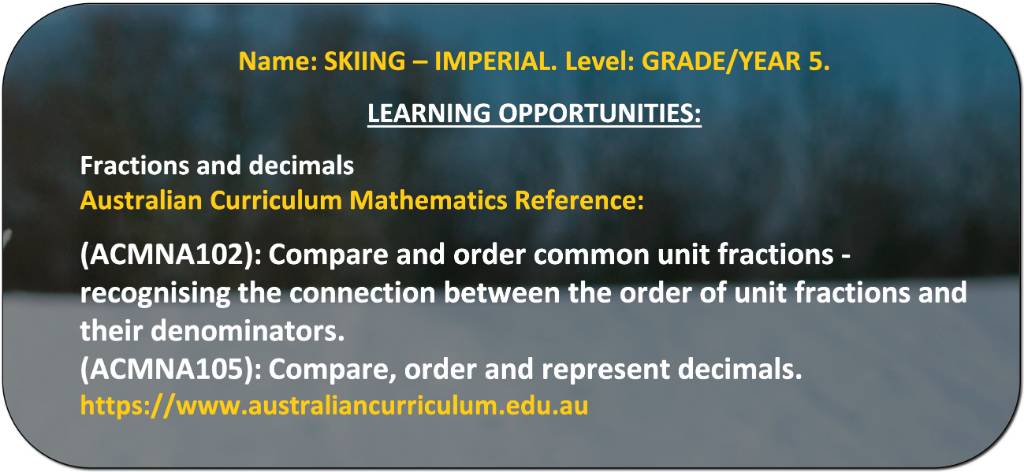
Skiing Imperial – Standard - Worksheet
SKIING METRIC – ADVANCED
GAME PLAYS ON: PC, LAPTOP & TABLET
Skiing Metric – Advanced - Game Description
Ages: 10 – 11 years old
Suits: Grade 5 students in Australia & Canada.
More advanced problem solving with fractions and decimals and how to convert between them.
The game is set in the snow with students on a skiing excursion. They must calculate how far each student was able to ski before falling over. Students must calculate the fractions and decimals of distance travelled on a 200 m track, making it more challenging to solve.
The game is lots of fun to play and is filled with humorous sound effects. Students should also play the imperial version of this game to give them a good understanding of different units of measurement. It is designed to suit the Mathematics Curriculums of Australia & Canada as it uses the metric system.
Teacher Reference:
(ACMNA079): Make connections between fractions and decimal notation. Using knowledge of fractions to establish equivalences between fractions and decimal notation.
Ref: Australian Curriculum Mathematics.
How To Play:
You are on a skiing excursion. There is a competition to see who can ski the longest distance, without falling over! The track is 200 m long. Medals are awarded at the end of the day! Make sure everyone gets their own medal. Choose a medal and DRAG your answer to the blue circle. You will have to convert decimals into fractions to get the answers. A challenge, but you can do it!
Skiing Metric – Advanced - Learning Outcomes
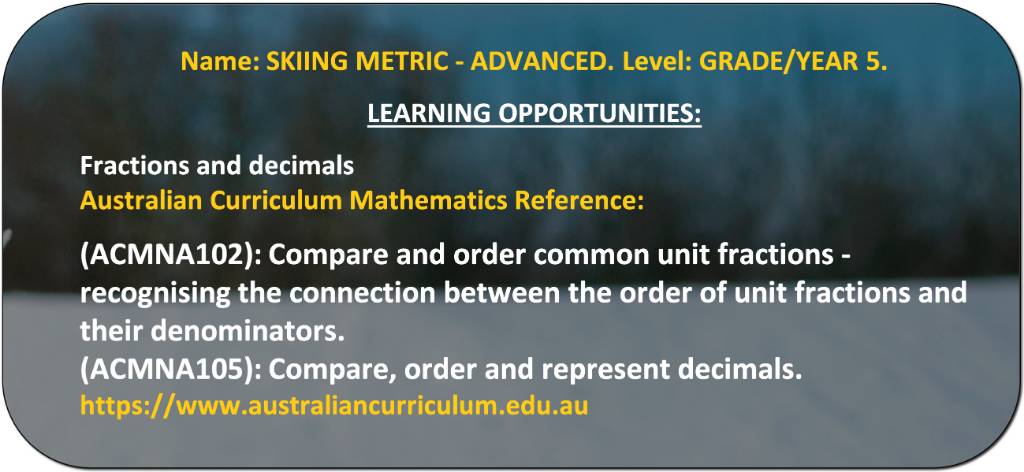
Skiing Metric – Advanced - Worksheet
SKIING IMPERIAL – ADVANCED
GAME PLAYS ON: PC, LAPTOP & TABLET
Skiing Imperial – Advanced - Game Description
Ages: 10 – 11 years old
Suits: Fifth Grade students in the U.S.A. and Year 6 students in England.
The game is set in the snow with students on a skiing excursion. They must calculate how far each student was able to ski before falling over. Students must calculate the fractions and decimals of distance travelled on a 300-yard track, making it more challenging to solve.
The game is lots of fun to play and is filled with humorous sound effects. Students should also play the metric version of this game to give them a good understanding of different units of measurement. It is designed to suit the Mathematics Curriculums of England and the U.S.A. as it uses the imperial system.
Teacher Reference:
(ACMNA079): Make connections between fractions and decimal notation. Using knowledge of fractions to establish equivalences between fractions and decimal notation.
Ref: Australian Curriculum Mathematics.
How To Play:
You are on a skiing excursion. There is a competition to see who can ski the longest distance, without falling over! The track is 300 yards long. Medals are awarded at the end of the day! Make sure everyone gets their own medal. Choose a medal and DRAG your answer to the blue circle. You will have to convert decimals into fractions to get the answers. A challenge, but you can do it!
Skiing Imperial – Advanced - Learning Outcomes
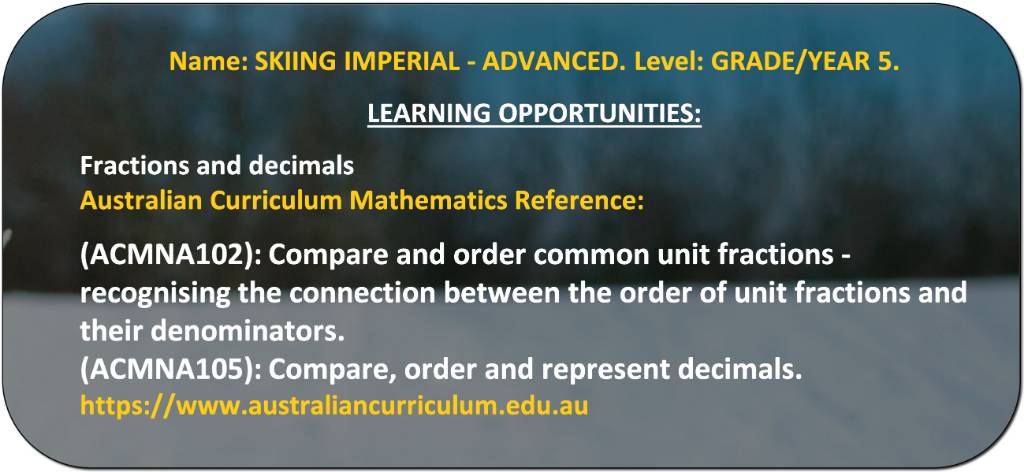
Skiing Imperial – Advanced - Worksheet
THE MOVIES
GAME PLAYS ON: PC & LAPTOP ONLY
The Movies - Game Description
Ages: 10 – 11 years old
Suits: Grade 5 students in Australia, Fifth Grade students in the U.S.A. & Canada and Year 6 students in England.
Learning how to construct a dot plot graph and to describe and interpret different data sets in context.
This game introduces dot plot graphs and how to interpret data. Students are asked to interpret data on dot plot graphs of a very familiar and appropriate topic. They are presented different sets of data on the number of movies fellow students have watched, i.e. screen time. They are also asked to construct their own dot plot on the total number of movies they watched in a year.
The game is filled with movie sound effects and positive voice-overs making it a fun game to play. Interpreting data can be a challenging concept for students of this level. However, this game demonstrates it well and keeps them engaged. It is designed to suit the Mathematics Curriculums of Australia, Canada, England and the U.S.A.
Teacher References:
(ACMSP120) – Describe and interpret different data sets in context.
(ACMSP119) – Construct a dot plot appropriate for data type, without the use of digital technologies.
Ref: Australian Curriculum Mathematics.
How To Play:
Everyone in your class has handed in DOT PLOTS on how many movies they watched last year. But your teacher has found 12 students forgot to write down their names! Click on one of the students. Then drag the correct DOT PLOT to the student. (See the CLUE.)
Worksheet: How many movies did you watch last year? (Include TV, all mobile devices and cinema.) You can estimate. Your final challenge is to make your own DOT PLOT! (See the worksheet.)
The Movies - Learning Outcomes
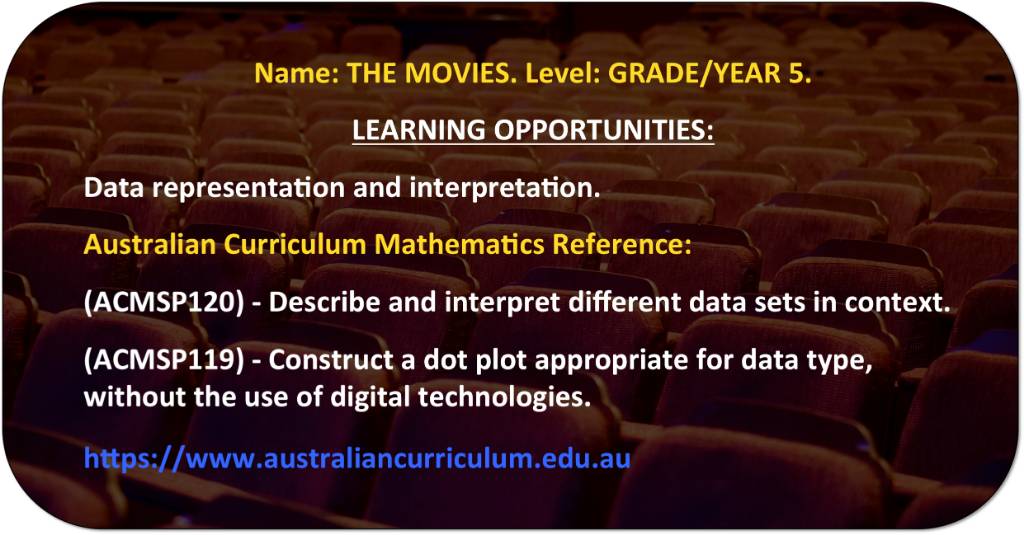
The Movies - Worksheet
FLOOR PLAN – METRIC
GAME PLAYS ON: PC, LAPTOP & TABLET
Floor Plan – Metric - Game Description
Ages: 10 – 11 years old
Suits: Grade 5 students in Australia & Canada.
Learning how to calculate the area and the perimeter of a rectangle using metric units.
This game introduces the area and perimeter of rectangles and how to calculate them. Students use pentominoes of different shapes to make 3 different sized rooms on a floor plan. They are then asked to calculate the area and perimeter of each room.
It is a fun and engaging way for students to become familiar with area, perimeter. The game is designed to suit the Mathematics Curriculums of Australia and Canada as it uses the metric system.
Teacher Reference:
(ACMMG109) – Calculate perimeter and area of rectangles using familiar units. Calculating area and perimeter. Using a scale to interpret information on a simple plan.
Ref: Australian Curriculum Mathematics.
How To Play:
Use the shapes to fill up each room. DRAG the shapes to move them. You can flip them and turn them left or right to make them fit.
What is the AREA of each room? (See the clue.)
What is the PERIMETER of each room? Can you find two different ways to work out the AREA of each room?
Floor Plan – Metric - Learning Outcomes
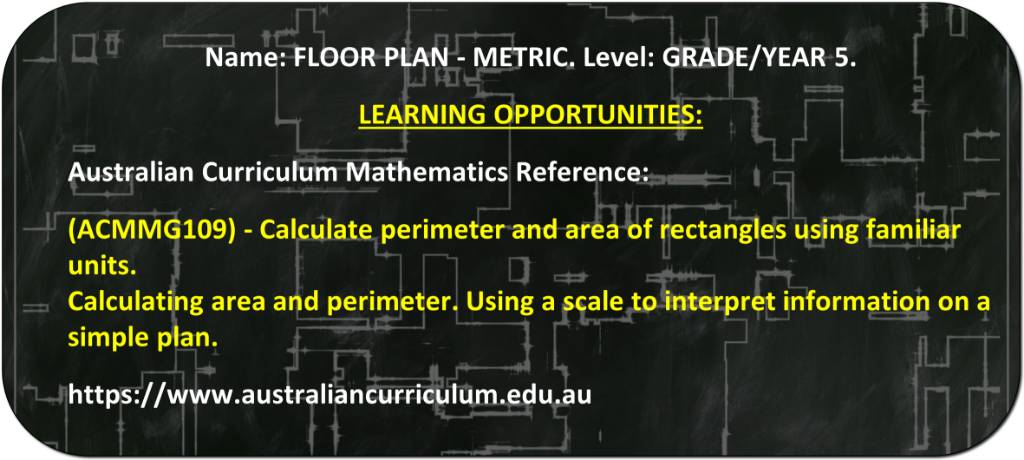
Floor Plan – Metric - Worksheet
FLOOR PLAN – IMPERIAL
GAME PLAYS ON: PC, LAPTOP & TABLET
Floor Plan – Imperial - Game Description
Ages: 10 – 11 years old
Suits: Fifth Grade students in the U.S.A. and Year 6 students in England.
Learning how to calculate the area and the perimeter of a rectangle using imperial units.
This game introduces the area and perimeter of rectangles and how to calculate them. Students use pentominoes of different shapes to make 3 different sized rooms on a floor plan. They are then asked to calculate the area and perimeter of each room.
It is a fun and engaging way for students to become familiar with area, perimeter. The game is designed to suit the Mathematics Curriculums of England and the U.S.A. as it uses the imperial system.
Teacher Reference:
(ACMMG109) – Calculate perimeter and area of rectangles using familiar units. Calculating area and perimeter of other shapes also. Using a scale to interpret information on a simple plan.
Ref: Australian Curriculum Mathematics.
How To Play:
Use the shapes to fill up each room. DRAG the shapes to move them. You can flip them and turn them left or right to make them fit.
What is the AREA of each room? (See the clue.) What is the PERIMETER of each room? Can you find two different ways to work out the AREA of each room?
Floor Plan – Imperial - Learning Outcomes
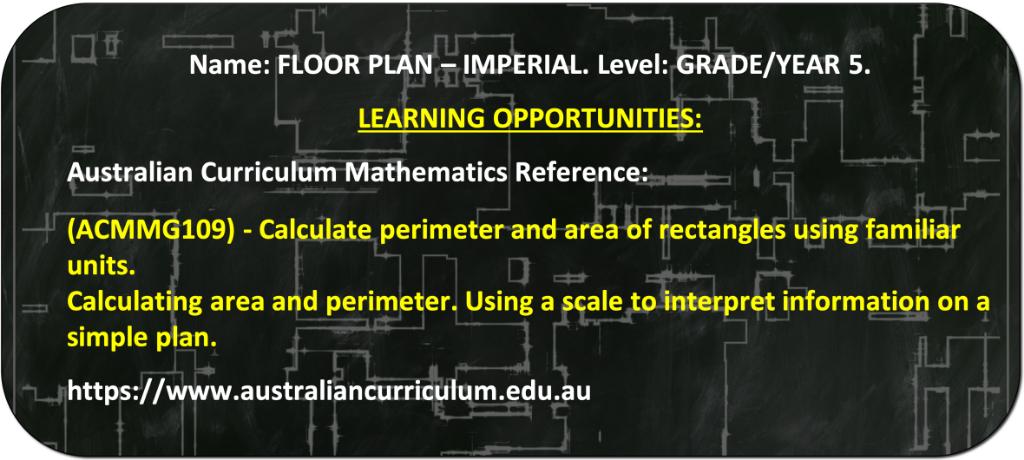
Floor Plan – Imperial - Worksheet
DOG WASH METRIC – STANDARD
GAME PLAYS ON: PC & LAPTOP ONLY
Dog Wash Metric – Standard - Game Description
Ages: 10 – 11 years old
Suits: Grade 5 students in Australia & Canada.
Learning division and multiplication involving one- and two- digit numbers.
Students are asked work out how many container loads it would take to fill a dog bath. They also need to convert from mL to L. It involves multiplication, division plus units of measurement conversion.
It is lots of fun and filled with positive words building student confidence in mathematics. Designed to suit the Mathematics Curriculums of Australia and Canada as it uses the metric system.
Teacher References:
(ACMNA101): Solve problems involving division by a one-digit number. (This game includes division by a two-digit number.)
(ACMNA100): Solve problems involving multiplication of large numbers by one- or two-digit numbers using efficient mental, written strategies and appropriate digital technologies.
(ACMMG108): Choose appropriate units of measurement for volume…
Ref: Australian Curriculum Mathematics.
How To Play:
You have decided to wash all your friends’ dogs. You must wash them outside. You must use buckets to fill the dog bath with warm water. How many container loads will it take to fill the dog bath? The dog bath needs 48 L of water to fill. Click on one of the buckets. Calculate how many trips it would take to fill the dog bath! (See the CLUE.) Then DRAG your answer to the bucket above.
After you compete the challenge, which bucket would be the best to use? Why?
Dog Wash Metric – Standard - Learning Outcomes
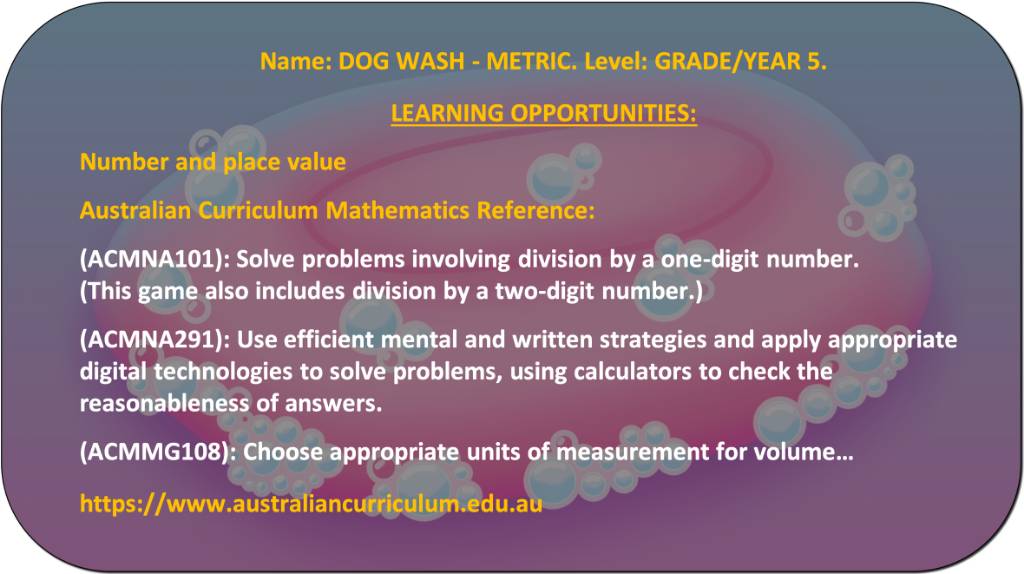
Dog Wash Metric – Standard - Worksheet
DOG WASH IMPERIAL – STANDARD
GAME PLAYS ON: PC & LAPTOP ONLY
Dog Wash Imperial – Standard - Game Description
Ages: 10 – 11 years old
Suits: Fifth Grade students in the U.S.A. and Year 6 students in England.
Learning division and multiplication involving one- and two- digit numbers, without the use of a calculator.
Students are asked to solve problems without using a calculator, therefore developing problem-solving skills. They must work out how many container loads it would take to fill a dog bath. They also need to convert between quarts, gallons. It involves multiplication, division plus units of measurement conversion.
It is lots of fun and filled with positive words building student confidence in mathematics. Designed to suit the Mathematics Curriculums of the England and the U.S.A. as it uses the imperial system.
Teacher References:
(ACMNA101): Solve problems involving division by a one-digit number. (This game includes division by a two-digit number.)
(ACMNA100): Solve problems involving multiplication of large numbers by one- or two-digit numbers using efficient mental, written strategies and appropriate digital technologies.
(ACMMG108): Choose appropriate units of measurement for volume…
Ref: Australian Curriculum Mathematics.
How To Play:
You have decided to wash all your friends’ dogs. You must wash them outside. You must use buckets to fill the dog bath with warm water. How many container loads will it take to fill the dog bath? The dog bath needs 48 gallons of water to fill. Click on one of the buckets. Calculate how many trips it would take to fill the dog bath! (See the CLUE.) Then DRAG your answer to the bucket above.
After you compete the challenge, which bucket would be the best to use? Why?
Dog Wash Imperial – Standard - Learning Outcomes
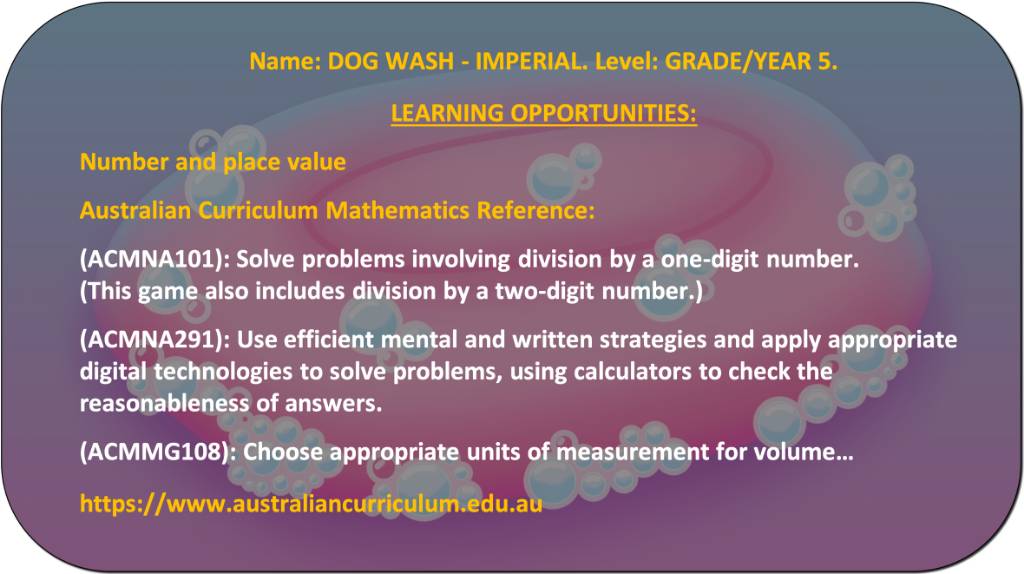
Dog Wash Imperial – Standard - Worksheet
DOG WASH METRIC – ADVANCED
GAME PLAYS ON: PC & LAPTOP ONLY
Dog Wash Metric – Advanced - Game Description
Ages: 10 – 11 years old
Suits: Grade 5 students in Australia & Canada.
Learning division and multiplication involving one- and two- digit numbers, without the use of a calculator.
This game is the more challenging problem-solving game of the “Dog Wash” series as it also involves calculations of time.
Students must solve problems without using a calculator, therefore developing problem-solving skills. They must work out how many container loads and the total time it would take to fill a dog bath. They also need to convert from mL to L and from seconds to minutes to hours. It involves multiplication, division plus units of measurement conversion. The game is used by teachers as a good gauge on how well a student grasps these concepts.
It is lots of fun and filled with positive words building student confidence in mathematics. Designed to suit the Mathematics Curriculums of Australia and Canada as it uses the metric system.
Teacher References:
(ACMNA101): Solve problems involving division by a one-digit number. (This game includes division by a two-digit number.)
(ACMNA100): Solve problems involving multiplication of large numbers by one- or two-digit numbers using efficient mental, written strategies and appropriate digital technologies.
(ACMMG108): Choose appropriate units of measurement for volume…
Ref: Australian Curriculum Mathematics.
How To Play:
You have started a business washing dogs. You must wash them outside. You must use buckets to fill the dog bath with warm water. Every bucket load takes 10 minutes, lucky your friends help you. The dog bath needs 48 L of water to fill. Click on one of the buckets. Calculate how long it would take to fill the dog bath! (See the CLUE.) Then DRAG your answer to the bucket above.
After you compete the challenge, which bucket would be the best to use? Why?
Dog Wash Metric – Advanced - Learning Outcomes
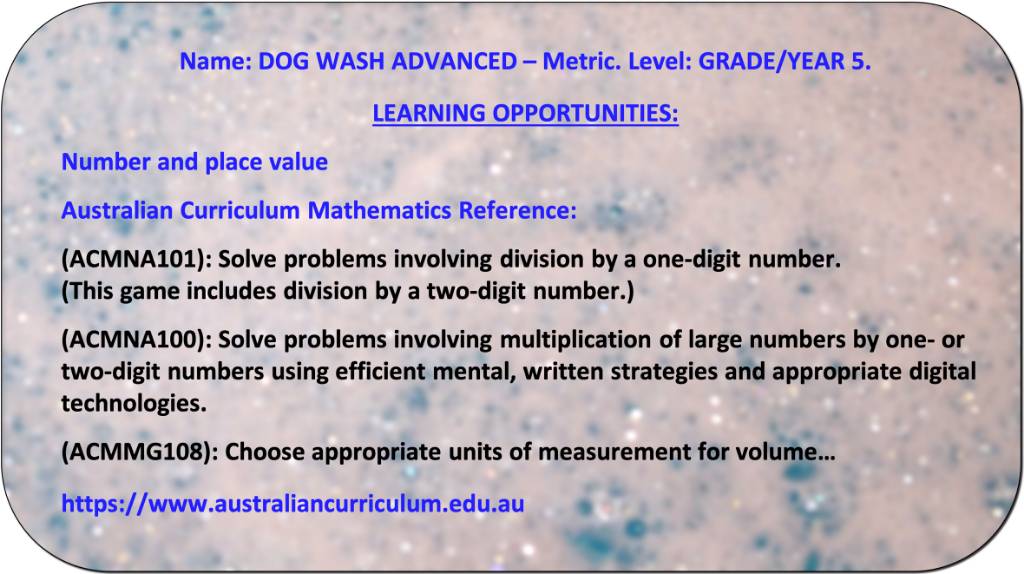
Dog Wash Metric – Advanced - Worksheet
DOG WASH IMPERIAL – ADVANCED
GAME PLAYS ON: PC & LAPTOP ONLY
Dog Wash Imperial – Advanced - Game Description
Ages: 10 – 11 years old
Suits: Fifth Grade students in the U.S.A. and Year 6 students in England.
Learning division and multiplication involving one- and two- digit numbers, without the use of a calculator.
This game is the more challenging problem-solving game of the “Dog Wash” series as it also involves calculations of time.
Students must solve problems without using a calculator, therefore developing problem-solving skills. Students must work out how many container loads and the total time it would take to fill a dog bath. They also need to convert between quarts, gallons and from seconds to minutes to hours. It involves multiplication, division plus units of measurement conversion. The game is used by teachers as a good gauge on how well a student grasps these concepts.
It is lots of fun and filled with positive words building student confidence in mathematics. Designed to suit the Mathematics Curriculums of the U.S.A. and England as it uses the imperial system.
Teacher References:
(ACMNA101): Solve problems involving division by a one-digit number. (This game includes division by a two-digit number.)
(ACMNA100): Solve problems involving multiplication of large numbers by one- or two-digit numbers using efficient mental, written strategies and appropriate digital technologies.
(ACMMG108): Choose appropriate units of measurement for volume…
Ref: Australian Curriculum Mathematics.
How To Play:
You have started a business washing dogs. You must wash them outside. You must use buckets to fill the dog bath with warm water. Every bucket load takes 10 minutes, lucky your friends help you. The dog bath needs 48 gallons of water to fill. Click on one of the buckets. Calculate how long it would take to fill the dog bath! (See the CLUE.) Then DRAG your answer to the bucket above.
After you compete the challenge, which bucket would be the best to use? Why?
Dog Wash Imperial – Advanced - Learning Outcomes
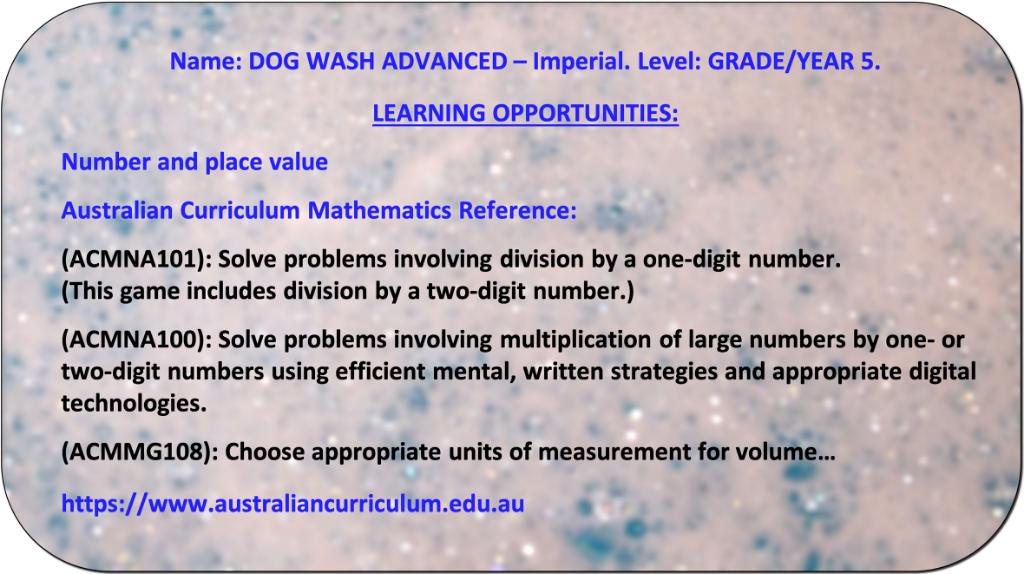
Dog Wash Imperial – Advanced - Worksheet
GRIDS
GAME PLAYS ON: PC, LAPTOP & TABLET
Grids - Game Description
Ages: 10 – 11 years old
Suits: Grade 5 students in Australia, Fifth Grade students in the U.S.A. & Canada and Year 6 students in England.
Using the Cartesian coordinate system and ordered pairs to learn grid referencing for maps and graphs.
This game helps students to use a grid reference system. It introduces the Cartesian coordinate system and ordered pairs. Using the Cartesian coordinate system and ordered pairs is a good way for students to learn grid referencing on maps and graphs.
The game is very engaging and lots of fun for students to play. It is full of exciting sounds and set in a futuristic city after dark!
This game is designed to suit the Mathematics Curriculums of Australia, Canada, England and the U.S.A.
Teacher Reference:
(ACMMG113): Use a grid reference system to describe location
Ref: Australian Curriculum Mathematics.
How To Play:
You are in a city after dark! You are trying to get out of the city to get home. You have a map. Can you read it? To read the map you must know grid referencing! Let’s find out if you know how! As pieces appear, put them onto their correct positions on the grid. Do this until you have done them all! Make sure you drag each one carefully. If you get two answers wrong, you must START AGAIN!
Grids - Learning Outcomes
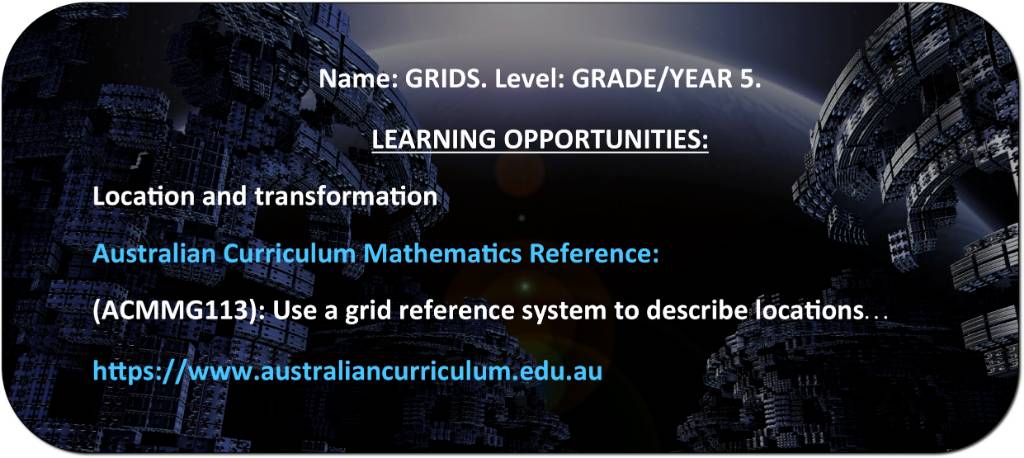
Grids - Worksheet
GRAB A COIN AUSTRALIA – STANDARD
GAME PLAYS ON: PC & LAPTOP ONLY
Grab a Coin Australia – Standard - Game Description
Ages: 10 – 11 years old
Suits: Grade 5 students in Australia.
This game teaches students how to represent probabilities with fractions, decimals, and percentages.
Students learn to represent outcomes of probabilities in chance experiments using fractions, decimals, and percentages. As this is new to this age group, the concept can be a challenge to grasp. However, this game demonstrates it simply in a manner that is easy for them to understand. It is based around pocket money and the chances of getting particular amounts.
This game is very engaging and fun to play for students of all levels of ability. It is designed to suit the Mathematics Curriculum of Australia as it uses the Australian currency
Teacher References:
(ACMSP116): List outcomes of chance experiments involving equally likely outcomes and represent probabilities of those outcomes using fractions.
(ACMSP117): Identify that probabilities range from 0 to 1. Investigating the probabilities of all outcomes for a simple chance experiment and verifying that their sum equals 1.
Ref: Australian Curriculum Mathematics.
How To Play:
For your pocket money each week, you put your hand in a bag, mix up the coins and grab one! Click on one of the bags of money. Calculate the chance (probability), of pulling out the amount of money under the bag. (See the CLUE.) Choose your answer and drag it to the bag. You must get the answer correct on your first or second try, otherwise the GAME STARTS AGAIN! Your challenge is to complete the game! What are 10%, 25% and 50% in fractions? Write them down. (See the worksheet.)
Grab a Coin Australia – Standard - Learning Outcomes
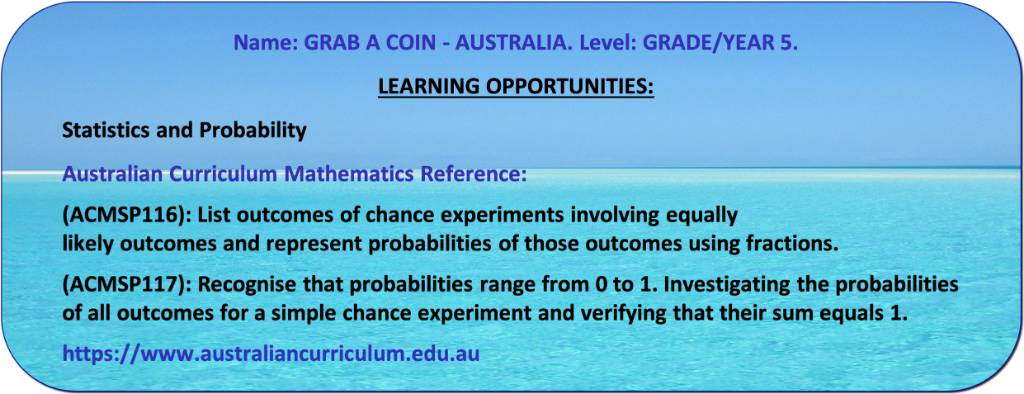
Grab a Coin Australia – Standard - Worksheet
GRAB A COIN CANADA – STANDARD
GAME PLAYS ON: PC & LAPTOP ONLY
Grab a Coin Canada – Standard - Game Description
Ages: 10 – 11 years old
Suits: Fifth Grade students in Canada.
This game teaches students how to represent probabilities with fractions, decimals, and percentages.
Students learn to represent outcomes of probabilities in chance experiments using fractions, decimals, and percentages. As this is new to this age group, the concept can be a challenge to grasp. However, this game demonstrates it simply in a manner that is easy for them to understand. It is based around pocket money and the chances of getting particular amounts.
This game is very engaging and fun to play for students of all levels of ability. It is designed to suit the Mathematics Curriculum of Canada as it uses the Canadian currency.
Teacher References:
(ACMSP116): List outcomes of chance experiments involving equally likely outcomes and represent probabilities of those outcomes using fractions.
(ACMSP117): Identify that probabilities range from 0 to 1. Investigating the probabilities of all outcomes for a simple chance experiment and verifying that their sum equals 1.
Ref: Australian Curriculum Mathematics.
How To Play:
For your pocket money each week, you put your hand in a bag, mix up the coins and grab one! Click on one of the bags of money. Calculate the chance (probability), of pulling out the amount of money under the bag. (See the CLUE.) Choose your answer and drag it to the bag. You must get the answer correct on your first or second try, otherwise the GAME STARTS AGAIN! Your challenge is to complete the game! What are 10%, 25% and 50% in fractions? Write them down. (See the worksheet.)
Grab a Coin Canada – Standard - Learning Outcomes
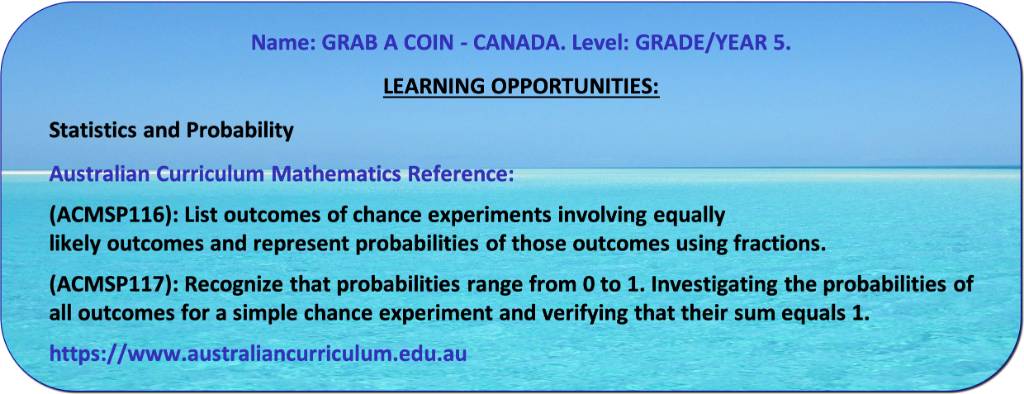
Grab a Coin Canada – Standard - Worksheet
GRAB A COIN ENGLAND – STANDARD
GAME PLAYS ON: PC & LAPTOP ONLY
Grab a Coin England – Standard - Game Description
Ages: 10 – 11 years old
Suits: Year 6 students in England.
This game teaches students how to represent probabilities with fractions, decimals, and percentages.
Students learn to represent outcomes of probabilities in chance experiments using fractions, decimals, and percentages. As this is new to this age group, the concept can be a challenge to grasp. However, this game demonstrates it simply in a manner that is easy for them to understand. It is based around pocket money and the chances of getting particular amounts.
This game is very engaging and fun to play for students of all levels of ability. It is designed to suit the Mathematics Curriculum of England as it uses the British currency
Teacher References:
(ACMSP116): List outcomes of chance experiments involving equally likely outcomes and represent probabilities of those outcomes using fractions.
(ACMSP117): Identify that probabilities range from 0 to 1. Investigating the probabilities of all outcomes for a simple chance experiment and verifying that their sum equals 1.
Ref: Australian Curriculum Mathematics.
How To Play:
For your pocket money each week, you put your hand in a bag, mix up the coins and grab one! Click on one of the bags of money. Calculate the chance (probability), of pulling out the amount of money under the bag. (See the CLUE.) Choose your answer and drag it to the bag. You must get the answer correct on your first or second try, otherwise the GAME STARTS AGAIN! Your challenge is to complete the game! What are 10%, 25% and 50% in fractions? Write them down. (See the worksheet.)
Grab a Coin England – Standard - Learning Outcomes
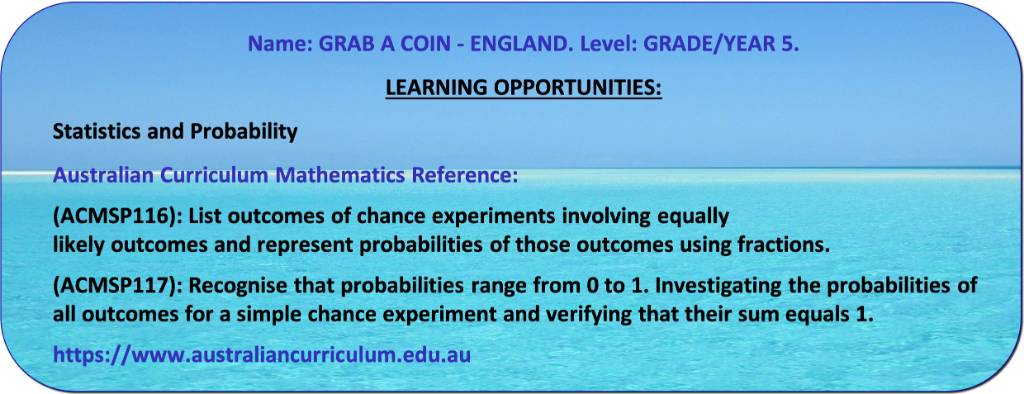
Grab a Coin England – Standard - Worksheet
GRAB A COIN U.S.A. – STANDARD
GAME PLAYS ON: PC & LAPTOP ONLY
Grab a Coin U.S.A. – Standard - Game Description
Ages: 10 – 11 years old
Suits: Fifth Grade students in the U.S.A.
This game teaches students how to represent probabilities with fractions, decimals, and percentages.
Students learn to represent outcomes of probabilities in chance experiments using fractions, decimals and percentages. As this is new to this age group, the concept can be a challenge to grasp. However, this game demonstrates it simply in a manner that is easy for them to understand. It is based around pocket money and the chances of getting particular amounts.
This game is very engaging and fun to play for students of all levels of ability. It is designed to suit the Mathematics Curriculum of the U.S.A. as it uses U.S.A. currency.
Teacher References:
(ACMSP116): List outcomes of chance experiments involving equally likely outcomes and represent probabilities of those outcomes using fractions.
(ACMSP117): Identify that probabilities range from 0 to 1. Investigating the probabilities of all outcomes for a simple chance experiment and verifying that their sum equals 1.
Ref: Australian Curriculum Mathematics.
How To Play:
For your pocket money each week, you put your hand in a bag, mix up the coins and grab one! Click on one of the bags of money. Calculate the chance (probability), of pulling out the amount of money under the bag. (See the CLUE.) Choose your answer and drag it to the bag. You must get the answer correct on your first or second try, otherwise the GAME STARTS AGAIN! Your challenge is to complete the game! What are 10%, 25% and 50% in fractions? Write them down. (See the worksheet.)
Grab a Coin U.S.A. – Standard - Learning Outcomes
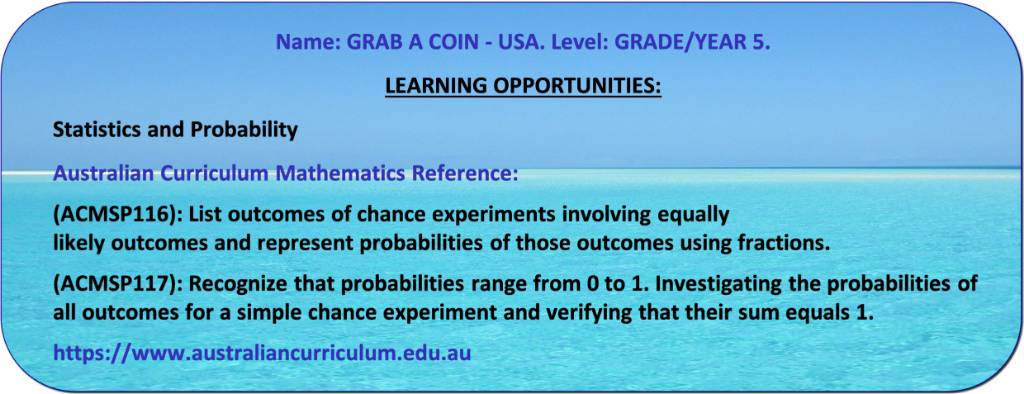
Grab a Coin U.S.A. – Standard - Worksheet
GRAB A COIN AUSTRALIA – ADVANCED
GAME PLAYS ON: PC & LAPTOP ONLY
Grab a Coin Australia – Advanced - Game Description
Ages: 10 – 11 years old
Suits: Grade 5 students in Australia.
This game teaches students how to represent probabilities with fractions, decimals, and percentages.
Students learn to represent outcomes of probabilities in chance experiments using fractions, decimals, and percentages. As this is new to this age group, the concept can be a challenge to grasp. However, this game demonstrates it simply in a manner that is easy for them to understand. It is based around pocket money and the chances of getting particular amounts.
This game is very engaging and fun to play for students of all levels of ability. It is designed to suit the Mathematics Curriculum of Australia as it uses the Australian currency
Teacher References:
(ACMSP116): List outcomes of chance experiments involving equally likely outcomes and represent probabilities of those outcomes using fractions.
(ACMSP117): Identify that probabilities range from 0 to 1. Investigating the probabilities of all outcomes for a simple chance experiment and verifying that their sum equals 1.
Ref: Australian Curriculum Mathematics.
How To Play:
For your pocket money each week, you put your hand in a bag, mix up the coins and grab one! Click on one of the bags of money. Calculate the chance (probability), of pulling out the amount of money under the bag. (See the CLUE.) Choose your answer and drag it to the bag. You must get the answer correct on your first or second try, otherwise the GAME STARTS AGAIN! Your challenge is to complete the game! What are 10%, 25% and 50% in fractions? Write them down. (See the worksheet.)
Grab a Coin Australia – Advanced - Learning Outcomes
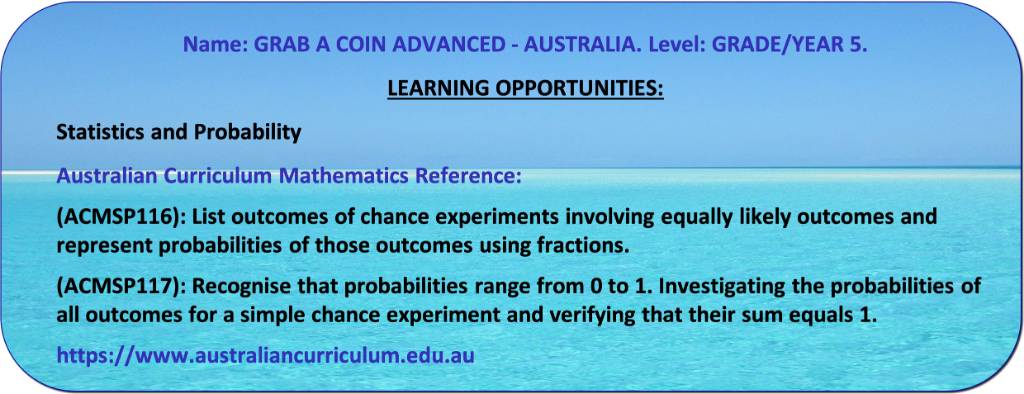
Grab a Coin Australia – Advanced - Worksheet
GRAB A COIN CANADA – ADVANCED
GAME PLAYS ON: PC & LAPTOP ONLY
Grab a Coin Canada – Advanced - Game Description
Ages: 10 – 11 years old
Suits: Fifth Grade students in Canada.
This game teaches students how to represent probabilities with fractions, decimals, and percentages.
Students learn to represent outcomes of probabilities in chance experiments using fractions, decimals, and percentages. As this is new to this age group, the concept can be a challenge to grasp. However, this game demonstrates it simply in a manner that is easy for them to understand. It is based around pocket money and the chances of getting particular amounts.
This game is very engaging and fun to play for students of all levels of ability. It is designed to suit the Mathematics Curriculum of Canada as it uses the Canadian currency.
Teacher References:
(ACMSP116): List outcomes of chance experiments involving equally likely outcomes and represent probabilities of those outcomes using fractions.
(ACMSP117): Identify that probabilities range from 0 to 1. Investigating the probabilities of all outcomes for a simple chance experiment and verifying that their sum equals 1.
Ref: Australian Curriculum Mathematics.
How To Play:
For your pocket money each week, you put your hand in a bag, mix up the coins and grab one! Click on one of the bags of money. Calculate the chance (probability), of pulling out the amount of money under the bag. (See the CLUE.) Choose your answer and drag it to the bag. You must get the answer correct on your first or second try, otherwise the GAME STARTS AGAIN! Your challenge is to complete the game! What are 10%, 25% and 50% in fractions? Write them down. (See the worksheet.)
Grab a Coin Canada – Advanced - Learning Outcomes
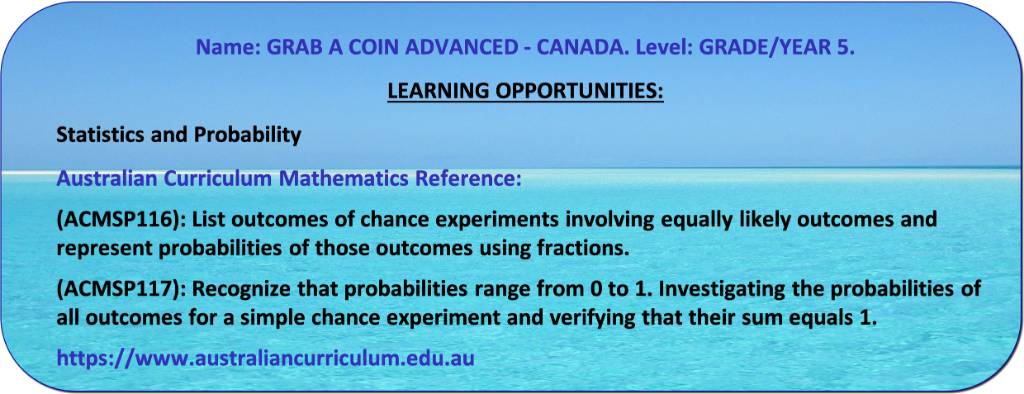
Grab a Coin Canada – Advanced - Worksheet
GRAB A COIN ENGLAND – ADVANCED
GAME PLAYS ON: PC & LAPTOP ONLY
Grab a Coin England - Advanced - Game Description
Ages: 10 – 11 years old
Suits: Year 6 students in England.
This game teaches students how to represent probabilities with fractions, decimals, and percentages.
Students learn to represent outcomes of probabilities in chance experiments using fractions, decimals, and percentages. As this is new to this age group, the concept can be a challenge to grasp. However, this game demonstrates it simply in a manner that is easy for them to understand. It is based around pocket money and the chances of getting particular amounts.
This game is very engaging and fun to play for students of all levels of ability. It is designed to suit the Mathematics Curriculum of England as it uses the British currency
Teacher References:
(ACMSP116): List outcomes of chance experiments involving equally likely outcomes and represent probabilities of those outcomes using fractions.
(ACMSP117): Identify that probabilities range from 0 to 1. Investigating the probabilities of all outcomes for a simple chance experiment and verifying that their sum equals 1.
Ref: Australian Curriculum Mathematics.
How To Play:
For your pocket money each week, you put your hand in a bag, mix up the coins and grab one! Click on one of the bags of money. Calculate the chance (probability), of pulling out the amount of money under the bag. (See the CLUE.) Choose your answer and drag it to the bag. You must get the answer correct on your first or second try, otherwise the GAME STARTS AGAIN! Your challenge is to complete the game! What are 10%, 25% and 50% in fractions? Write them down. (See the worksheet.)
Grab a Coin England - Advanced - Learning Outcomes
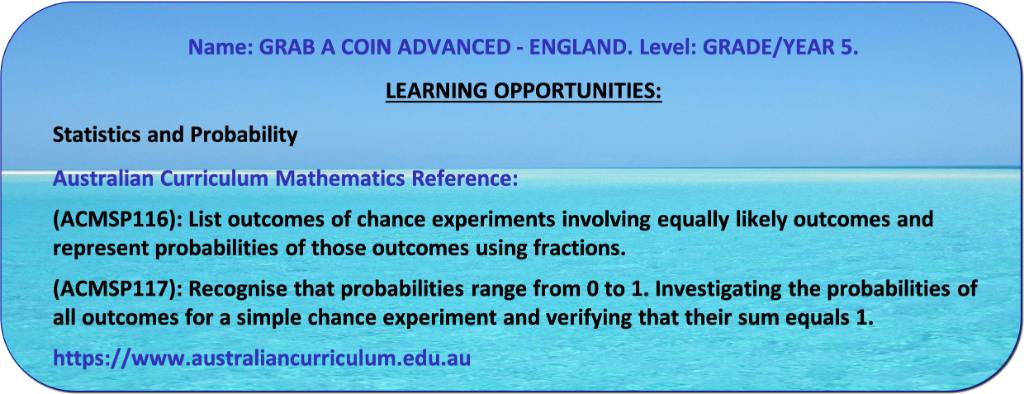
Grab a Coin England - Advanced - Worksheet
GRAB A COIN U.S.A. – ADVANCED
GAME PLAYS ON: PC & LAPTOP ONLY
Grab a Coin U.S.A. – Advanced - Game Description
Ages: 10 – 11 years old
Suits: Fifth Grade students in the U.S.A.
This game teaches students how to represent probabilities with fractions, decimals, and percentages.
Students learn to represent outcomes of probabilities in chance experiments using fractions, decimals and percentages. As this is new to this age group, the concept can be a challenge to grasp. However, this game demonstrates it simply in a manner that is easy for them to understand. It is based around pocket money and the chances of getting particular amounts.
This game is very engaging and fun to play for students of all levels of ability. It is designed to suit the Mathematics Curriculum of the U.S.A. as it uses U.S.A. currency.
Teacher References:
(ACMSP116): List outcomes of chance experiments involving equally likely outcomes and represent probabilities of those outcomes using fractions.
(ACMSP117): Identify that probabilities range from 0 to 1. Investigating the probabilities of all outcomes for a simple chance experiment and verifying that their sum equals 1.
Ref: Australian Curriculum Mathematics.
How To Play:
For your pocket money each week, you put your hand in a bag, mix up the coins and grab one! Click on one of the bags of money. Calculate the chance (probability), of pulling out the amount of money under the bag. (See the CLUE.) Choose your answer and drag it to the bag. You must get the answer correct on your first or second try, otherwise the GAME STARTS AGAIN! Your challenge is to complete the game! What are 10%, 25% and 50% in fractions? Write them down. (See the worksheet.)
Grab a Coin U.S.A. – Advanced - Learning Outcomes

Grab a Coin U.S.A. – Advanced - Worksheet
SELFIE – DOLLARS
GAME PLAYS ON: PC, LAPTOP & TABLET
Selfie – Dollars - Game Description
Ages: 10 – 11 years old
Suits: Grade 5 students in Australia and Fifth Grade students in the U.S.A. & Canada.
Solving practical problems using division with calculations involving units of time and money.
This mathematics game helps students solve problems using division. This game has multiple benefits as students must solve practical and challenging problems involving money & time with a calculator. The game involves an interesting and popular topic for this age group, i.e. using mobile/cell phones.
It is set on the snowfields with students on a holiday. Each day they are given $10 to make 1 phone call. They must work out how long they can talk for, as the cost a call cost varies with each day. It is lots of fun and becomes more and more challenging as it is played. The game also builds student confidence in problem solving. It is designed to suit the Mathematics Curriculums of Australia, Canada and the U.S.A, as it uses dollars.
Teacher References:
(ACMNA291): Use efficient mental and written strategies and apply appropriate digital technologies to solve problems, (proficiency using a calculator).
(ACMNA101): Solve problems involving division, (this game includes 3- digit numbers with decimals). Interpreting and representing the remainder in division calculations sensibly for the context.
Ref: Australian Curriculum Mathematics.
How To Play:
You are on an overseas holiday. You spend $10 of your phone credit every day on just one phone call. Call costs change each day. How long is your phone call? Choose one of the phones. Calculate the correct amount of time you have spent and drag it to the blue circle. Your challenge is to complete the game. You can do it!
Selfie – Dollars - Learning Outcomes
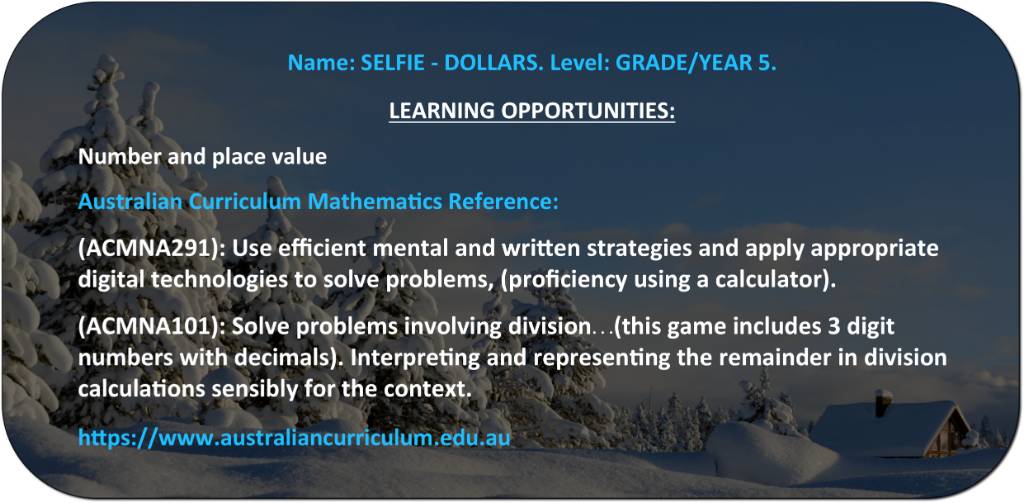
Selfie – Dollars - Worksheet
SELFIE – POUNDS
GAME PLAYS ON: PC, LAPTOP & TABLET
Selfie – Pounds - Game Description
Ages: 10 – 11 years old
Suits: Year 6 students in England.
Solving practical problems using division with calculations involving units of time and money.
This mathematics game helps students solve problems using division. This game has multiple benefits as students must solve practical and challenging problems involving money & time with a calculator. The game involves an interesting and popular topic for this age group, i.e. using mobile/cell phones.
It is set on the snowfields with students on a holiday. Each day they are given £10 to make 1 phone call. They must work out how long they can talk for, as the cost a call cost varies with each day. It is lots of fun and becomes more and more challenging as it is played. The game also builds student confidence in problem solving. It is designed to suit the Mathematics Curriculum of England as it uses British pounds.
Teacher References:
(ACMNA291): Use efficient mental and written strategies and apply appropriate digital technologies to solve problems, (proficiency using a calculator).
(ACMNA101): Solve problems involving division, (this game includes 3- digit numbers with decimals). Interpreting and representing the remainder in division calculations sensibly for the context.
Ref: Australian Curriculum Mathematics.
How To Play:
You are on an overseas holiday. You spend £10 of your phone credit every day on just one phone call. Call costs change each day. How long is your phone call? Choose one of the phones. Calculate the correct amount of time you have spent and drag it to the blue circle. Your challenge is to complete the game. You can do it!
Selfie – Pounds - Learning Outcomes
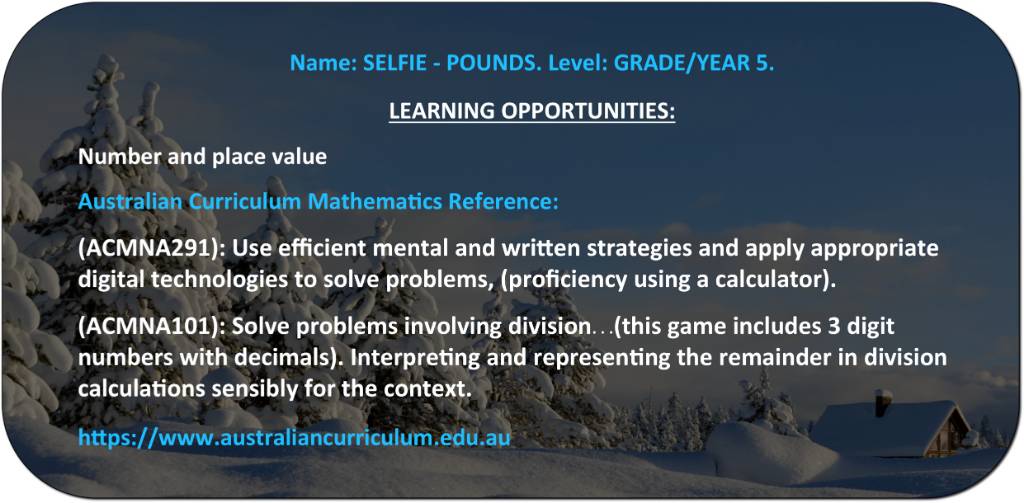
Selfie – Pounds - Worksheet
ROLLER COASTER – AUSTRALIA
GAME PLAYS ON: PC & LAPTOP ONLY
Roller Coaster – Australia - Game Description
Ages: 10 – 11 years old
Suits: Grade 5 students in Australia.
Solving problems involving multiplication of large numbers involving money and using a calculator. This game uses the Australian currency.
This is an educational mathematics game helping students to solve challenging problems involving money and using a calculator. Students must calculate the cost of buying items involving large sums of money. They must also use addition to find totals.
This game is presented in a simple and easy way for them to understand. They are purchasing tickets to a roller coaster ride and buying items such as ice cream and popcorn for the whole class. It is engaging and fun to play and involves sound effects of a roller coaster and fun park. It is designed to suit the Mathematics Curriculum of Australia as it uses Australian banknotes.
Teacher References:
(ACMNA100): Solve problems involving multiplication of large numbers by one- or two-digits using efficient mental, written strategies and appropriate digital technologies.
(ACMNA291): Use efficient mental and written strategies and apply appropriate digital technologies to solve problems.
Ref: Australian Curriculum Mathematics.
How To Play:
Your class is fundraising for an excursion to a roller coaster. There are 20 students going on the excursion. What can you buy with the money raised? Click on any card. Calculate the total cost, (See CLUE). Once you have found the cost, choose the correct answer. No guessing! You must get the answer correct on your first or second try, otherwise the GAME STARTS AGAIN!
Roller Coaster – Australia - Learning Outcomes
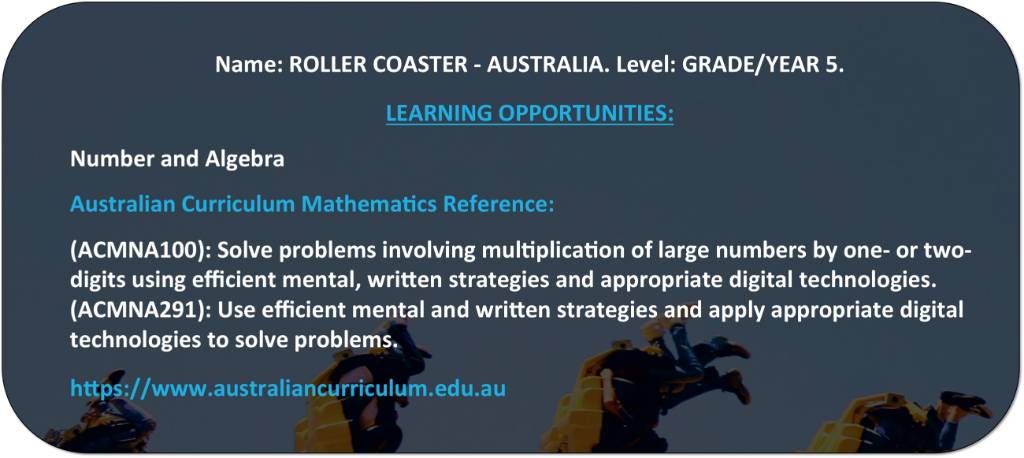
Roller Coaster – Australia - Worksheet
ROLLER COASTER – CANADA
GAME PLAYS ON: PC & LAPTOP ONLY
Roller Coaster – Canada - Game Description
Ages: 10 – 11 years old
Suits: Fifth Grade students in Canada.
Solving problems involving multiplication of large numbers involving money and using a calculator. This game uses the Canadian currency.
This is an educational mathematics game helping students to solve challenging problems involving money and using a calculator. Students must calculate the cost of buying items involving large sums of money. They must also use addition to find totals.
This game is presented in a simple and easy way for them to understand. They are purchasing tickets to a roller coaster ride and buying items such as ice cream and popcorn for the whole class. It is engaging and fun to play and involves sound effects of a roller coaster and fun park. It is designed to suit the Mathematics Curriculum of Canada as it uses Canadian banknotes.
Teacher References:
(ACMNA100): Solve problems involving multiplication of large numbers by one- or two-digits using efficient mental, written strategies and appropriate digital technologies.
(ACMNA291): Use efficient mental and written strategies and apply appropriate digital technologies to solve problems.
Ref: Australian Curriculum Mathematics.
How To Play:
Your class is fundraising for an excursion to a roller coaster. There are 20 students going on the excursion. What can you buy with the money raised? Click on any card. Calculate the total cost, (See CLUE). Once you have found the cost, choose the correct answer. No guessing! You must get the answer correct on your first or second try, otherwise the GAME STARTS AGAIN!
Roller Coaster – Canada - Learning Outcomes
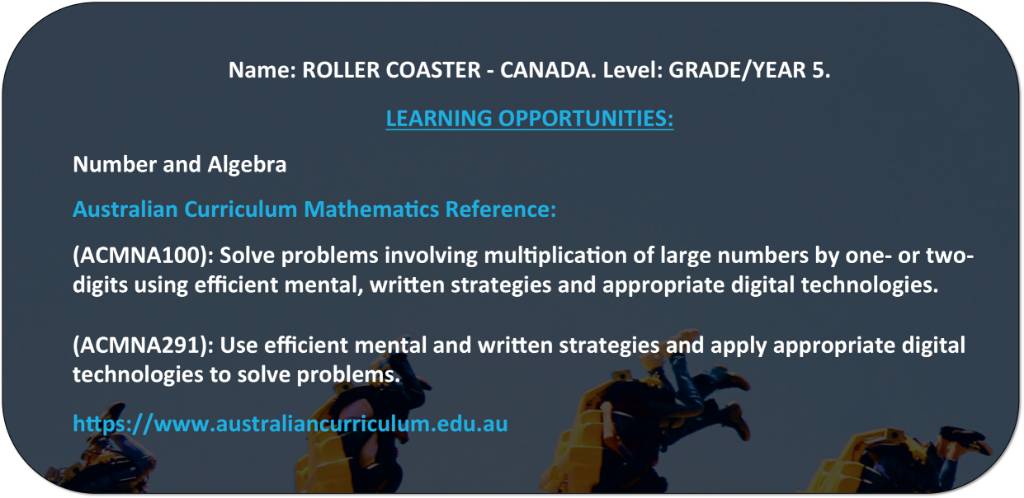
Roller Coaster – Canada - Worksheet
ROLLER COASTER – ENGLAND
GAME PLAYS ON: PC & LAPTOP ONLY
Roller Coaster – England - Game Description
Ages: 10 – 11 years old
Suits: Year 6 students in England.
Solving problems involving multiplication of large numbers involving money and using a calculator. This game uses British currency.
This is an educational mathematics game helping students to solve challenging problems involving money and using a calculator. Students must calculate the cost of buying items involving large sums of money. They must also use addition to find totals.
This game is presented in a simple and easy way for them to understand. They are purchasing tickets to a roller coaster ride and buying items such as ice cream and popcorn for the whole class. It is engaging and fun to play and involves sound effects of a roller coaster and fun park. It is designed to suit the Mathematics Curriculum of England as it uses British banknotes.
Teacher References:
(ACMNA100): Solve problems involving multiplication of large numbers by one- or two-digits using efficient mental, written strategies and appropriate digital technologies.
(ACMNA291): Use efficient mental and written strategies and apply appropriate digital technologies to solve problems.
Ref: Australian Curriculum Mathematics.
How To Play:
Your class is fundraising for an excursion to a roller coaster. There are 20 students going on the excursion. What can you buy with the money raised? Click on any card. Calculate the total cost, (See CLUE). Once you have found the cost, choose the correct answer. No guessing! You must get the answer correct on your first or second try, otherwise the GAME STARTS AGAIN!
Roller Coaster – England - Learning Outcomes
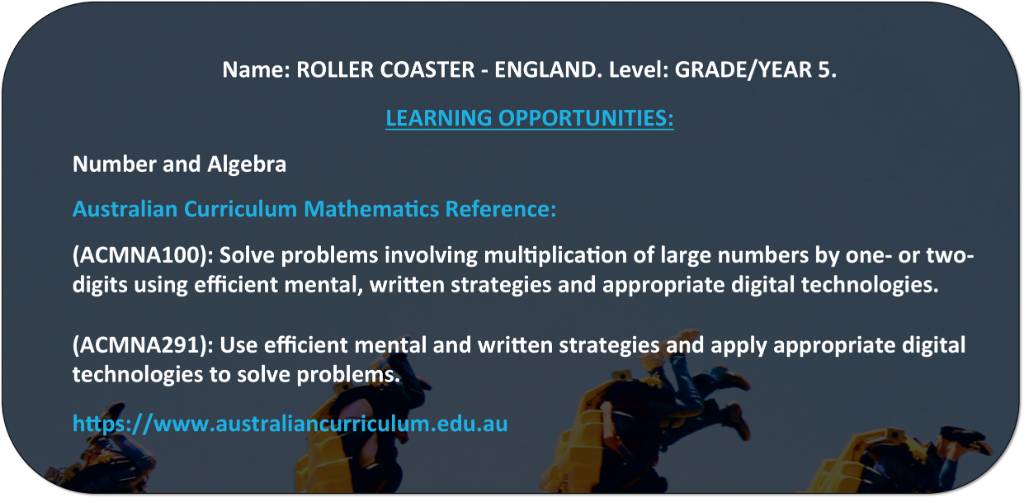
Roller Coaster – England - Worksheet
ROLLER COASTER – U.S.A.
GAME PLAYS ON: PC & LAPTOP ONLY
Roller Coaster – U.S.A. - Game Description
Ages: 10 – 11 years old
Suits: Fifth Grade students in the U.S.A.
Solving problems involving multiplication of large numbers involving money and using a calculator. This game uses U.S.A. currency.
This is an educational mathematics game helping students to solve challenging problems involving money and using a calculator. Students must calculate the cost of buying items involving large sums of money. They must also use addition to find totals.
This game is presented in a simple and easy way for them to understand. They are purchasing tickets to a roller coaster ride and buying items such as ice cream and popcorn for the whole class. It is engaging and fun to play and involves sound effects of a roller coaster and fun park. It is designed to suit the Mathematics Curriculum of the U.S.A. as it uses U.S.A. banknotes.
Teacher References:
(ACMNA100): Solve problems involving multiplication of large numbers by one- or two-digits using efficient mental, written strategies and appropriate digital technologies.
(ACMNA291): Use efficient mental and written strategies and apply appropriate digital technologies to solve problems.
Ref: Australian Curriculum Mathematics.
How To Play:
Your class is fundraising for an excursion to a roller coaster. There are 20 students going on the excursion. What can you buy with the money raised? Click on any card. Calculate the total cost, (See CLUE). Once you have found the cost, choose the correct answer.
No guessing! You must get the answer correct on your first or second try, otherwise the GAME STARTS AGAIN!
Roller Coaster – U.S.A. - Learning Outcomes
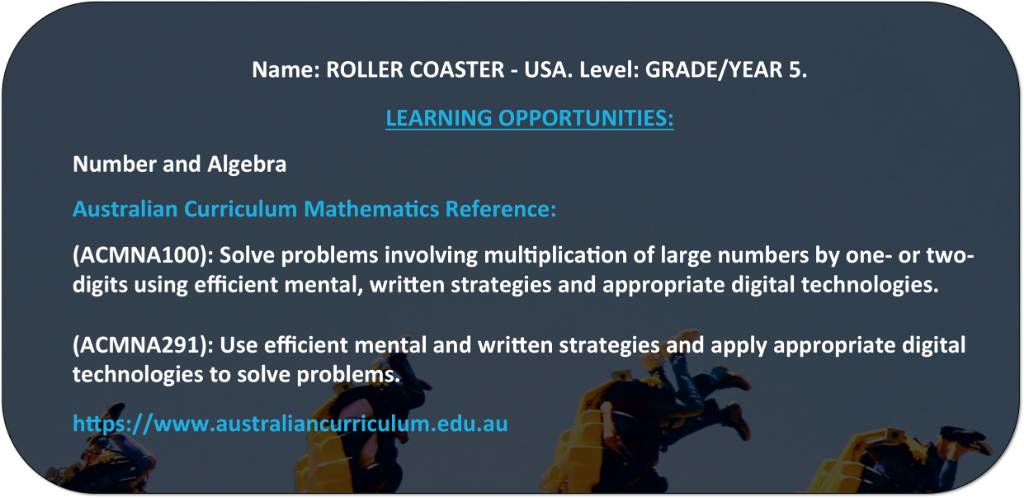
Roller Coaster – U.S.A. - Worksheet
THE HEX
GAME PLAYS ON: PC, LAPTOP & TABLET
The Hex - Game Description
Ages: 10 – 11 years old
Suits: Grade 5 students in Australia, Fifth Grade students in the U.S.A. & Canada and Year 6 students in England.
This is a challenging and engaging game for students. Using a hexagon puzzle, students must match either 2 fractions or 2 decimals so that their sum adds up to 1. The game becomes a good exercise in arithmetic as students must try many different combinations to solve the puzzle.
Fully engaging and fun to play it often will build a student’s confidence once they have solved a difficult puzzle. Designed to suit the Mathematics Curriculums of Australia, Canada, England and the U.S.A.
Teacher References:
(ACMNA102): Compare and order common unit fractions.
(ACMNA103): Investigate strategies to solve problems involving addition of fractions with the same denominator.
(ACMNA105): Compare, order, and represent decimals.
Ref: Australian Curriculum Mathematics.
How To Play:
Put six hexagons around the centre/center piece, so all touching sides are matching in colour/color AND add up to 1.
DRAG the pieces to move them. Then you can TURN each one to fit. A real challenge but you can do it. Don’t give up!
The Hex - Learning Outcomes
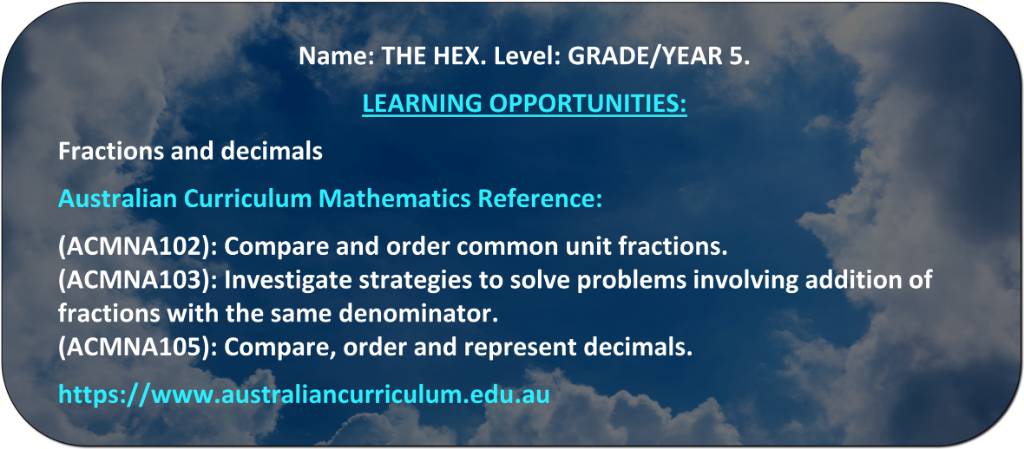
The Hex - Worksheet
DETECTIVE
GAME PLAYS ON: PC, LAPTOP & TABLET
Detective - Game Description
Ages: 10 – 11 years old
Suits: Grade 5 students in Australia, Fifth Grade students in the U.S.A. & Canada and Year 6 students in England.
Helping students to become proficient at adding and subtracting decimals.
Students must solve a crime by completing two number puzzles, without using a calculator.
As decimals are newly introduced to this age group, the concept can be a challenge to grasp. However, this game is filled with crime-scene sounds creating an exciting atmosphere that keeps them engaged. It is designed to suit the Mathematics Curriculums of Australia, Canada, England and the U.S.A.
Teacher References:
(ACMNA105): Compare, order, and represent decimals. (By addition and subtraction of decimals.)
(ACMNA107): Describe, continue, and create patterns with decimals resulting from addition and subtraction.
Ref: Australian Curriculum Mathematics.
How To Play:
You are a master detective! Two robbers are on the loose and you have been asked to catch them. You have their DNA as evidence. Their uncompleted DNA codes will appear. By solving both puzzles, you find their DNA codes and catch them. See the CLUE to help you solve this crime. Good luck, they are dangerous!
Detective - Learning Outcomes
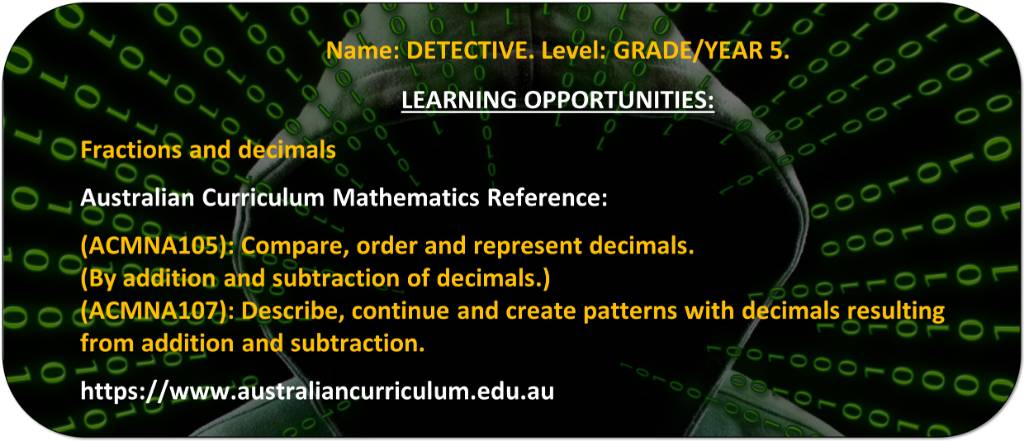
Detective - Worksheet
LEAP YEARS 2
GAME PLAYS ON: PC & LAPTOP ONLY
Leap Years 2 - Game Description
Ages: 10 – 11 years old
Suits: Grade 5 students in Australia, Fifth Grade students in the U.S.A. & Canada and Year 6 students in England.
Using a calculator for problem solving with multiplication where there is no remainder.
This is a challenging game helping students solve complex problems involving multiplication. It is part 2 of the leap year games, the first game is in Grade 4 and students are also encouraged to also play that game as a good introduction to leap years.
This game has a double learning benefit as students must identify, represent, and order numbers to at tens of thousands. Five-digit numbers and represented in words and in numerical representations.
The game has an amazing picture of Earth from a distance and is filled with outer space and atmospheric sound effects. Students are asked to calculate the ages of a tree as it grows. The game is designed to suit the Mathematics Curriculums of Australia, Canada, England, and the U.S.A.
Teacher References:
(ACMNA072): Identify, represent, and order numbers to at least tens of thousands. (Reproducing five-digit numbers in words using their numerical representations, and vice versa.)
(ACMNA076): Use appropriate digital technologies for multiplication where there is no remainder.
Ref: Australian Curriculum Mathematics.
How To Play:
How old are trees in days? Let’s work it out. Every 4 years is a leap year, and you will have to add an extra day! Click on one of the trees. Use the clues to calculate how many days old it is? Choose the correct answer. No guessing! You must get the answer correct on your first or second try, otherwise, the GAME STARTS AGAIN!
Leap Years 2 - Learning Outcomes
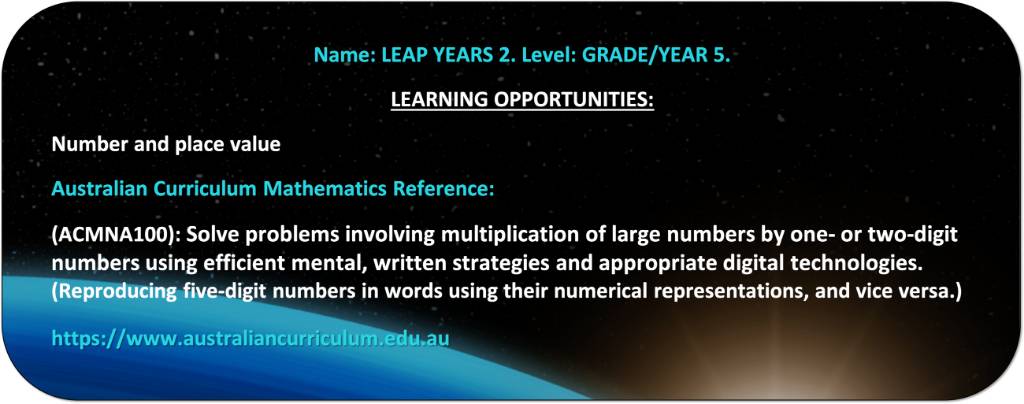
Leap Years 2 - Worksheet
By the end of Grade 5, students solve simple problems involving the four operations using a range of strategies. They check the reasonableness of answers using estimation and rounding. Students identify and describe factors and multiples. They identify and explain strategies for finding unknown quantities in number sentences involving the four operations. Students connect three-dimensional objects with their two-dimensional representations. They describe transformations of two-dimensional shapes and identify line and rotational symmetry. Students interpret different data sets. Students order decimals and unit fractions and locate them on number lines. They add and subtract fractions with the same denominator. Students continue patterns by adding and subtracting fractions and decimals. They use appropriate units of measurement for length, area, volume, capacity and mass, and calculate perimeter and area of rectangles. They convert between 12- and 24-hour time. Students use a grid reference system to locate landmarks. They measure and construct different angles. Students list outcomes of chance experiments with equally likely outcomes and assign probabilities between 0 and 1. Students pose questions to gather data, and construct data displays appropriate for the data.
https://www.australiancurriculum.edu.au







